CHAPMAN
CANOPY OF LIGHT
Beyond the treetops and into space, scientists expose the latest climate trends.


Beyond the treetops and into space, scientists expose the latest climate trends.

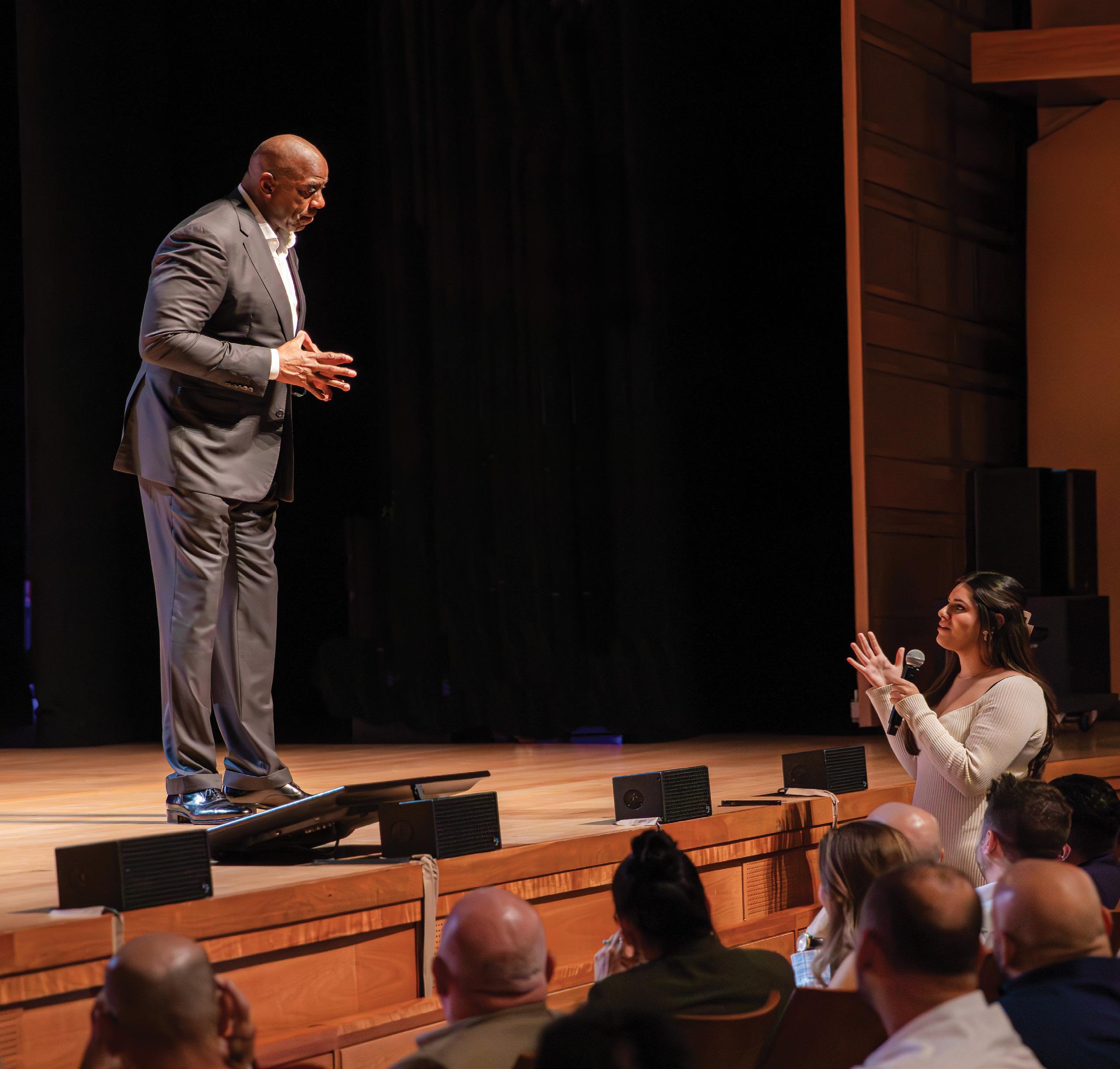
On Sept. 22, 2023, Chapman University announced a transformative gift of $10 million from the Argyros family, which has led to the elevation of the George L. Argyros School of Business and Economics to the George L. Argyros College of Business and Economics.
The gift was announced at the launch of Argyros’ Dean’s Distinguished Lecture Series, at which Earvin “Magic” Johnson was the inaugural speaker. In addition to being widely regarded as the greatest point guard in NBA history, Johnson currently serves as the chairman and CEO of Magic Johnson Enterprises. He holds ownership stakes in prominent sports franchises, including the Los Angeles Dodgers, the Los Angeles Sparks, the Washington Commanders, the Los Angeles Football Club and eSports franchise Team Liquid.
After a discussion with Argyros Dean Henrik Cronqvist, Johnson took time to answer student questions.
One student, who asked for advice on how to persevere through rejection, gained inspiring insight from Johnson, who told her to “quit worrying about what others say. You have to believe in you. You keep showing up to work, doing your job. You’re smart, you have to love yourself first.”

President Daniele C. Struppa, members of the Argyros family, Earvin “Magic” Johnson and Argyros College of Business and Economics Dean Henrik Cronqvist celebrate the announcement of a $10 million gift from the Argyros family.
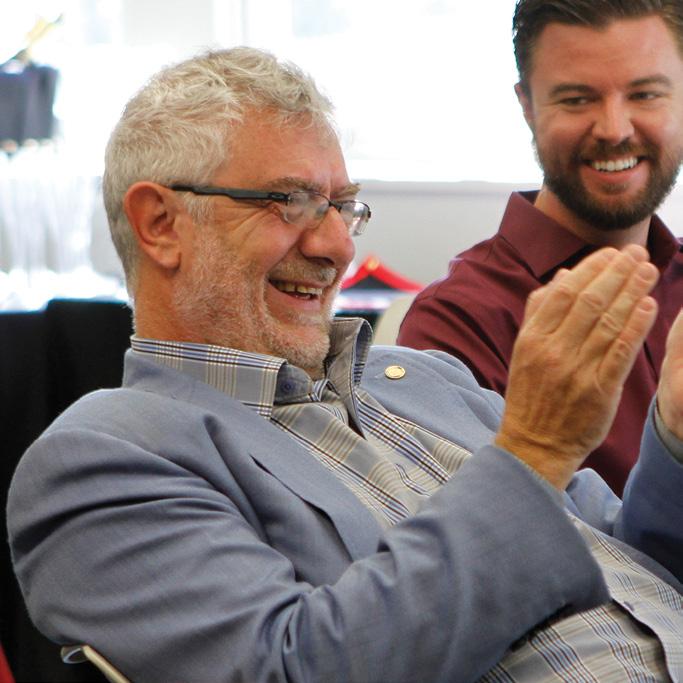
Though I’ve been president of Chapman University for seven years, each passing year feels as fresh as the first. There is an unstoppable spirit of curiosity and community mindedness that drives this university toward new horizons year after year.
That drive is on full display among our alumni community, who have been connecting through regional networks and at Chapman On the Road events from coast to coast these past few months. I was lucky enough to join many of you recently in Seattle and San Jose. In this issue of Chapman Magazine, read about upcoming opportunities for parents and alumni to engage with Chapman and one another (Page 56), and meet a few Chapman graduates of the last decade, whose innovations are having an impact in their fields (Page 10).
The strength of our alumni community and success of Chapman graduates begins the first moment a student walks on campus. That’s why our five-year strategic plan, “Our Path to Greatness,” centers on our commitment to academic excellence and a vibrant campus community. At my State of the University address in February, I shared the progress of this plan, including our successes in providing enhanced support for students and faculty to excel in study and research and our most successful fundraising year in Chapman’s history – an achievement in which over 17,000 of you played a role.
As we continue to pursue strategic initiatives that map our path for the future, we also celebrate the students, alumni and faculty whose distinctive research, creative activity and community advocacy are already putting Chapman on the map.
Faculty member and artist Lia Halloran exemplifies that spirit of curiosity (Page 20). In a new book, “The Warped Side of the Universe,” Lia has created over 150 original paintings that integrate tightly with poetic verse written by collaborator and Nobel Prize-winning physicist Kip Thorne. Together, they explore discoveries from astrophysics that invite readers to have a novel and engaging experience of the universe.
A bit closer to Earth, albeit still a few hundred miles up in space, an observational instrument on the International Space Station has conducted remote sensing of canopy temperatures in tropical rainforests. Schmid College researchers Greg Goldsmith and Josh Fisher are using the data to determine the “tipping point” at which temperatures would get too high for tropical trees to function (Page 30). This research helps the global scientific community understand a critical temperature threshold and urges a path forward for avoiding crossing that line.
And right here on campus, the Rodgers Center for Holocaust Education, led by Professor Marilyn Harran, is marking the 25th anniversary of the annual Holocaust Art and Writing Contest, which brings students from across the globe to Chapman for unparalleled education. Through creativity in art, poetry, prose or film, students focus on a survivor’s or rescuer’s specific Holocaust memory and share the action they will take as a witness in answering the call of memory (Page 48).
Together, our Chapman community of students, alumni, faculty and staff demonstrate a lifelong quest for knowledge. In this commitment, we are able to confront the challenges of a changing world with ingenuity and impact.
Daniele C. Struppa President, Chapman University
The 52,000-square-foot building located in Irvine serves health sciences students.
Chapman University celebrated the grand opening of its Rinker Health Science Campus Center in Irvine on Oct. 25.
The building offers meeting, study and community space at Rinker Campus. The facility gives Chapman more space to partner on events with community groups and offers academic support services, open and private spaces, food, and art and photography.
“Irvine is becoming a hub for health sciences,” Irvine Mayor Farrah Khan said before the ribbon cutting at the ceremony. “We need a pipeline of people who are going to be able to do the work … Thank you for considering Irvine as your home.”
School of Pharmacy Interim Dean Rennolds Ostrom said the new center is an investment in Chapman and Orange County.
“There is an exploding need for health care in Orange County, and the aging population needs more healthcare workers,” he said. “We’re building a campus that is going to train these healthcare professionals to improve the health of our communities.”
Crean College of Health and Behavioral Sciences Dean Janeen Hill said the new center is “a dream come true.”
“We’ve always known that we would need to have a student center where students could eat, relax, do all kinds of things besides just study. And it has been a real act of

persistence and commitment on the part of the university to make sure this center came to reality,” she said.
Student leaders representing Crean and the School of Pharmacy, which are housed at Rinker Campus, spoke at the opening.
“Within these walls, we discover our passions, unlock our potential and shape our futures,” said Brenda Kilzi, a Doctor of Pharmacy student.
“This building has become an opportunity for us to engage with each other and study, not only with ourselves but other disciplines, as well as provide a space for a much-needed rest,” said Kara Ito, a Doctor of Physical Therapy student.
Vice President of Campus Planning and Design Collette Creppell, who oversaw the design of the Fitwel-certified campus center, thanked the students who advocated for the student center.
“You’ve responded wonderfully since this opened,” she said to the students. “I hope you continue to make this place your own.”
After the ribbon cutting, the campus’ new panther statue was dedicated and attendees were invited to take tours.
Investment in graduate health science programs is one of the pillars of Chapman’s strategic plan, including achieving a stateof-the-art Rinker campus in the next five years.
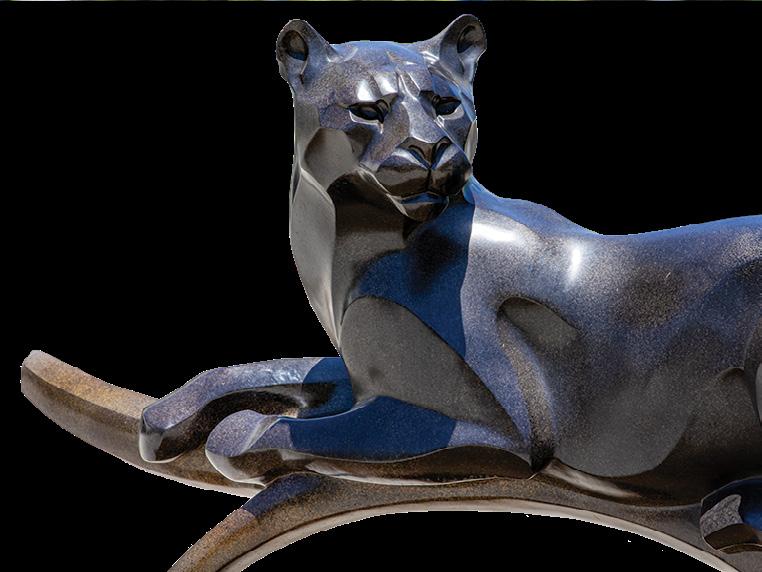 From left, student Kara Ito, Trustee Akin Ceylon, chair of the Real Estate and Campus Development Committee, student Brenda Kilzi, Irvine Mayor Farrah Khan, Crean College of Health and Behavioral Sciences Dean Janeen Hill, School of Pharmacy Interim Dean Rennolds Ostrom and Vice President of Campus Planning and Design Collette Creppell cut the ribbon at the Campus Center at Rinker.
From left, student Kara Ito, Trustee Akin Ceylon, chair of the Real Estate and Campus Development Committee, student Brenda Kilzi, Irvine Mayor Farrah Khan, Crean College of Health and Behavioral Sciences Dean Janeen Hill, School of Pharmacy Interim Dean Rennolds Ostrom and Vice President of Campus Planning and Design Collette Creppell cut the ribbon at the Campus Center at Rinker.
At Chapman University, sometimes the pace of progress feels as fast as the pulsed lasers inside Swenson Hall of Engineering; the spirited leaps on par with those of students in the gleaming new Sandi Simon Center for Dance. It’s no wonder, then, that as Martina Nieswandt seeks to further elevate research and creative activity at Chapman, she and her Chapman colleagues are always on their toes.
Such is life at a university on the rise.
“Our daily challenge is to provide the resources to sustain next-phase opportunities for a university that, in a relatively short time, has developed a significant research community as an R2 institution,” said Nieswandt, vice president for research and graduate education at Chapman.
Nieswandt draws inspiration from the very people who soar thanks in part to the support her office provides.
“There is no saturation point,” she said of research opportunities at Chapman. “There’s unmistakable research momentum that reflects on this dynamic collaborative community and is supported with funding in STEM fields and beyond.”
The data validate that the university’s trajectory remains on the upswing.
In the most recent fiscal year, Chapman’s federal research expenditures climbed 93%. Meanwhile, during the two decades since 2000, citations of publications by Chapman scholars have skyrocketed by more than 14,000%.
What’s more, in the latest edition of an internationally recognized research database, 24 Chapman faculty members ranked among the top 2% of researchers worldwide, based on the high volume of their citations. The figure represents a 50% increase from the previous year.


That growth is not only due to Chapman research stalwarts like Nobel Prize-winning economist Vernon Smith and National Medal of Science honoree Yakir Aharonov. Nieswandt is pleased that emerging faculty scholars also are contributing to the university’s advancement.
She’s excited about the quality of the junior faculty joining Chapman and about the university’s commitment to “an equitable, holistic career-long research focus.”
That vision includes:
Developmental support targeting researchers’ specific career phase so they get a leg up on next-level projects and funding.
Mentorship from those with years and sometimes decades of research experience to help next-generation scholars step into positions of leadership.
Examples of early-career and breakthrough research success are multiplying at Chapman.
In Chapman’s Attallah College of Educational Studies, Whitney McIntyre Miller has developed a new model for turning peace leadership theories into practical steps that global change-makers are applying in more than 40 nations.
In the School of Pharmacy, Sun Yang is developing peptides and patented compounds with promise as targeted therapies for melanoma.
Those advances reflect another area of focus at Chapman: building partnerships with industry to expand impactful research collaboration.
During the 2021-22 fiscal year, more than 80 new contracts united Chapman faculty researchers with industry innovators, driving projects to create new food-processing techniques, antimicrobial treatments and much more. From fiscal year 2020/21-2022/23, invention disclosures quadrupled at Chapman, and the number of Chapman publications increased by about 30%.
“We’re eager to establish even more collaboration, leading to partnerships that include fee-for-service contracts, graduate training and internships for our undergraduates,” Nieswandt said. “We’re seeing industry partners also benefit by having a pipeline to Chapman students as future employees. At the same time, their existing employees can add skills thanks to our graduate programs and state-of-the-art facilities.”
Inside those facilities, cutting-edge technology is making a difference across the Chapman campus in Orange as well as the university’s Rinker Health Science Campus in Irvine.
“ This kind of interdisciplinary project puts Chapman on the agenda across the nation, highlighting work that impacts the life of this society and our world.”
Martina Nieswandt
Aiding engineering research and teaching in the Optics and Photonics Lab is a new laser that emits extremely high power over an incredibly short duration – a femtosecond, or one-quadrillionth of a second. The technology opens doors to extremely precise research in fields like fiber-optic communication systems.
Elsewhere, a recent anonymous gift of $2.5 million is supporting an Innovation Hub at Dodge College of Film and Media Arts, ranked the No. 4 film school in the nation by The Hollywood Reporter and The Wrap.
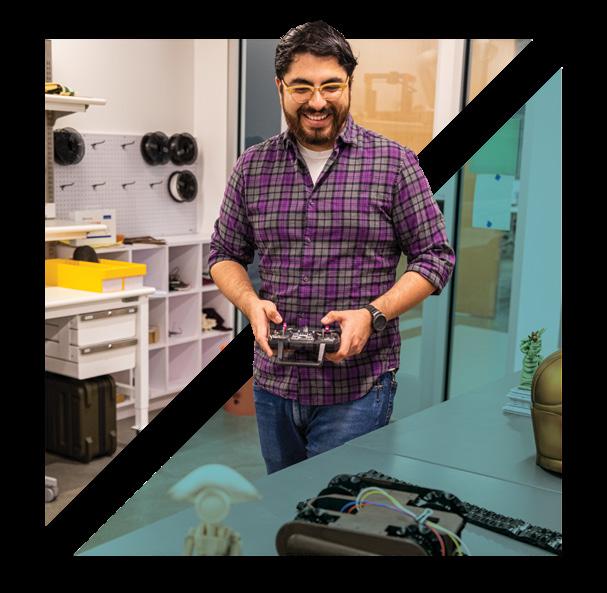

“We already provide the best facilities of any film school in the country,” said Dodge College Dean Stephen Galloway. “This generous gift will help move us into an even higher realm of technological innovation.”
“Chapman is all about innovation,” added Jim Mazzo, co-chair of Chapman’s ongoing fundraising campaign Inspire: The Campaign for Chapman University. The public phase of the campaign was launched in February 2023 with the goal of raising $500 million by 2028. As of September, the campaign had well surpassed the halfway mark.
In 2021, Dodge College became the first film school to install an LED virtual production wall, now in high demand for teaching and student film production in the Digital Media Arts Center on campus. Students have embraced the technology because it allows them to blend the live-action and digital filmmaking worlds – a hybrid form pioneered by Disney’s “The Mandalorian.”
“There are a few moments in history when technology can reshape an art form, and this is one of those moments,” Galloway said.
At Chapman, there are also opportunities to reshape the health sciences. The Rinker Campus is well situated for success in part because of its location at the center of Orange County’s booming health science industries.
Rinker, home of Crean College of Health and Behavioral Sciences graduate programs and the School of Pharmacy, boasts:
One of the oldest Doctor of Physical Therapy programs in the state. Students in these programs and others like physician assistant and speech therapy get robust handson training running stroke rehabilitation, aphasia support groups and real-world simulations with diverse mannequins.
Cancer-fighting research by several faculty members, including recently patented medication and medical trials. Faculty use state-of-the-art equipment, including a $3 million machine that speeds up creation of medications.
These programs and others across the university use a multidisciplinary, collaborative approach that is a Chapman staple. One example is Fowler School of Law’s climate conference that gathered perspectives and ideas from law, art, STEM and business.
“This kind of interdisciplinary project puts Chapman on the agenda across the nation, highlighting work that impacts the life of this society and our world,” Nieswandt said.


t Night of Champions Oct. 20, the 2023 Chapman Athletics Hall of Fame class was inducted, and an athletics endowment created by Chapman Board of Trustees Chair Parker S. Kennedy was announced.
The endowment is part of Kennedy’s $15 million gift to Chapman announced in August 2023.
Track and field Olympic medalist and civil rights activist John Carlos spoke at the event, and President Daniele C. Struppa sponsored and unveiled a bust of Carlos, which will reside near the Anderson Athletics Complex.
Carlos is known for raising his fist on the podium at the 1968 Mexico City Olympic Games to protest racial inequality.
The new Hall of Fame class was also recognized at halftime of the Panthers’ Oct. 21 home football game.
“I’ve taken a lot of [memories with me] from my time at Chapman. It was an absolute privilege
“In the years I went to school here, the two things that stood out to me as an international



On Induction: “It is a tremendous honor to be selected. I am grateful to represent the basketball program and truly thankful to the fans, coaches and teammates who made my success possible.”
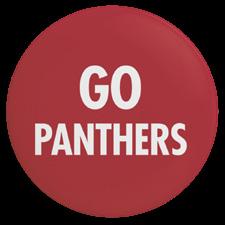
Favorite Memory: “The easy one is the triple-overtime victory against UCSD in their brand-new arena during my second year … In many ways, it’s simply the whole experience that I remember. The long practices, long road trips, late nights, close friendships, hard-fought victories, devastating losses and the lasting friendships that made my time there so special. I really am blessed to have been able to be a part of it all.”

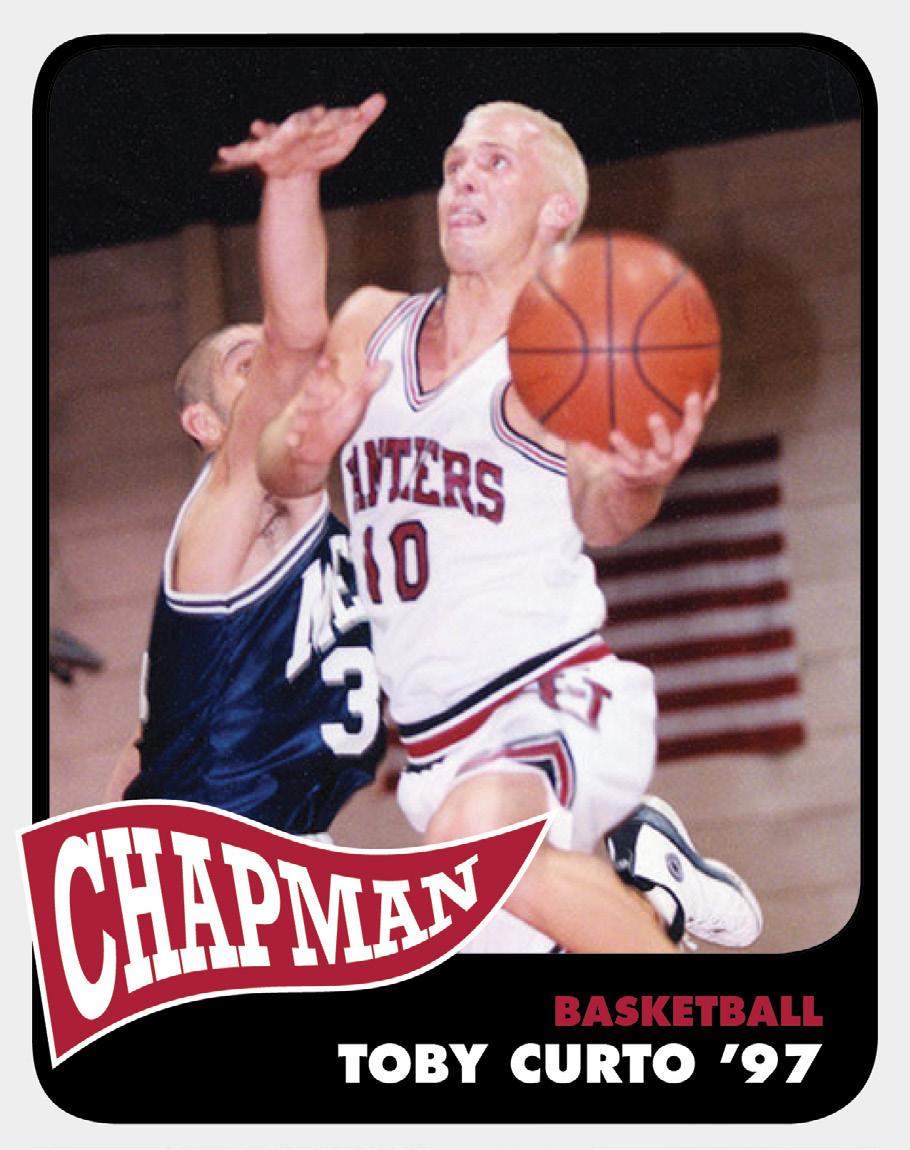

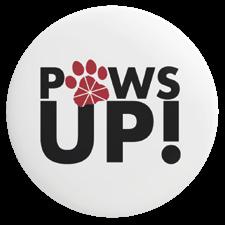
 TOBY CURTO ‘97 BASKETBALL TWO-TIME ALL-REGION SELECTION 1,000-POINT SCORER TOP-10 CAREER SCORING AVERAGE
TOBY CURTO ‘97 BASKETBALL TWO-TIME ALL-REGION SELECTION 1,000-POINT SCORER TOP-10 CAREER SCORING AVERAGE

SECOND NCAA CHAMPIONSHIP TEAM FOR CHAPMAN BASEBALL
FINISHED WITH 39-12 OVERALL RECORD
SWEPT CHRISTOPHER NEWPORT UNIVERSITY IN CHAMPIONSHIP SERIES
On Induction: “Each of us have our own specific details that stick out in our minds, but it is the whole shared experience that makes it so special. Accomplishing something great, something very difficult … to then achieve the ultimate success in that thing — is incredibly satisfying and rare. But to do that as a group — to achieve the pinnacle of success as a team — that must be the most satisfying experience there is. To be inducted into the Hall of Fame as teammates 20 years after the fact underscores how true that is.”
Favorite Memory: “My favorite memory is the feelings of fulfillment that I experienced day in and day out just being with the team and doing my part as the coach. Just the intense feeling of purpose and confidence knowing that we were doing the right things, and on a daily basis doing everything we could possibly do to prepare the team to be the very best it could possibly be. And the satisfaction of knowing the team believed and trusted in us (coaches) and in each other.”
— Head Coach Tom Tereschuk on behalf of the team
TWO-TIME ALL-REGION SELECTION CAREER RECORD HOLDER FOR ASSISTS
TOP-5 FOR CAREER POINTS
On Induction: “Being selected means the world to me. I am the biggest Panther out there and now to know I’m in the HOF means everything to me. It’s such an honor to be part of this amazing group.”
Favorite Memory: “Being part of something so special. When I came to Chapman it was Chapman College, and when I graduated it was Chapman University.”






TWO-TIME SCIAC OFFENSIVE PLAYER OF THE YEAR RECORD HOLDER FOR CAREER AND SEASON COMPLETION PERCENTAGE
TOP 3 FOR CAREER PASSING TOUCHDOWNS, YARDS AND COMPLETIONS
On Induction: “Being selected into the Chapman Hall of Fame is a great honor because it includes me in a Chapman sports family with some of the great athletes throughout the history of the school. This Hall of Fame selection helped solidify leaving a legacy for the football program, which was always a goal of mine from the moment I stepped on campus.”
Favorite Memory: “My favorite memory at Chapman was beating Redlands on their home turf for the firstever SCIAC football championship in school history. Celebrating on the 50-yard line, after dumping the Gatorade cooler over Coach Owens, will never be erased from my mind.”



The spaciously reimagined new home of one of the world’s largest collections of California narrative art officially opened to the public in February.
The Hilbert Museum of California Art at Chapman University, founded and funded through the ongoing generosity of art patrons and philanthropists Mark and Janet Hilbert, has undergone an ambitious three-year project to expand from 7,000 to 22,000 sq. ft. on the same site it has occupied in Orange, Calif. since opening in 2016.
“Chapman University, central Orange County and Southern California have a glorious new home for California narrative art that is as rich, expansive and artistically accessible as the art inside,” said Mark Hilbert, who with his wife gifted the couple’s extensive collection to Chapman to make it available for public view.
The new two-building venue offers 26 galleries for rotating displays of the more than 5,000 oils, watercolors and drawings depicting everyday California life in the growing Hilbert Collection. The museum also has a café, research library and community room for lectures, classes and events. An outdoor courtyard creates a new gateway to Old Towne Orange and Chapman University, said Collette Creppell, Chapman’s vice president of campus planning and design.
Visitors can now view an opening slate of eight exhibitions showcasing the museum’s commitment to California Scene narrative art from the 1930s to the present, plus its rich holdings in animation and movie art, Native American art and American illustration and design.
Among the opening shows are those honoring Norman Rockwell, Millard Sheets, Disney’s Mary Blair and local Chicano artist Emigidio Vasquez as well as vintage radios, Navajo weavings and examples of California modernism.
“This spectacular new expansion is a dream come true – the building itself is an eye-catching piece of art that provides a visual welcome,” said Museum Director Mary Platt, who personally curated some of the exhibitions. “We have a dynamic array of extraordinary exhibitions to open with, showing off many of the varied facets of The Hilbert Collection. The Hilbert Collection is unique in that it is one of the few to specialize in narrative art – or art that tells a story, which in our case is focused on California. Because of this, we wanted a museum building that embraces the visitor and entices them to explore the history and culture of the Golden State as seen through the painters, illustrators, animators and other artists who have long been drawn here.”
Designed by architecture firm Johnston Marklee, the museum stands in an industrial corridor within the Cypress Street Barrio historic district and the design pays tribute to local Orange industrial and mercantile architecture.
“The visitor experience begins outside with the Millard Sheets mosaic, framing a civic space that links the Chapman University campus to the city of Orange,” said Sharon Johnston of the firm.
To learn more and make a reservation, visit hilbertmuseum.org.

The museum features a restored 1950s mosaic by Millard Sheets, “The Pleasures Along the Beach,” originally created for the Home Savings building in Santa Monica, Calif.
The destruction of Ukrainian museums, libraries, theaters, art galleries, monuments and other important cultural sites was devastating to witness. The scale of this campaign is almost unimaginable; the human and heritage cost incalculable.
UNESCO has verified the damage and destruction of 300 key sites of significant Ukrainian cultural heritage since the invasion began in 2022.
This aspect of the war is mainly understood in the West as some sort of collateral damage to the military campaign, tangential to the Russian war aims — regrettable but somehow inevitable in modern conflict.
This is fundamentally wrong. Destroying Ukrainian culture is the central purpose of everything Putin is doing. If he succeeds, Ukraine will be erased, suppressed, scattered and absorbed. Nothing about this is collateral or tangential or accidental. It’s what the war is about. Cultural erasure is not some obscure aspect of the war: it is the central pillar of the entire Russian undertaking.
Putin is nothing if not clear about his intentions. He has called Ukrainian statehood “a fiction” and alleged that Ukraine only exists because of a series of mistakes by Soviet leaders. He claims that Ukrainians lack the history, identity and culture worthy of a separate state. His pundits have claimed that Ukrainian language and culture simply do not exist. Russian historians and scholars tamely support the Kremlin’s line. Reality is bent to meet Putin’s warped narrative.
In those regions occupied even temporarily by Russian
WHAT UKRAINIAN ART HAS NOT BEEN BURNED OR BLOWN TO PIECES, HAS BEEN LOOTED.
forces, the destruction, looting and vandalism of art and cultural artifacts has been systematic and well organized. What Ukrainian art has not been burned or blown to pieces has been looted. Libraries have been stripped of Ukrainian-language books. Schools in occupied areas teach only Moscow-approved history and literature. It is a desperate image of the future should Ukraine lose.

Putin intends to blot out Ukraine as an independent culture, a people and an idea. Only ruins will be left, the remnants and memory of a vibrant culture scattered to the wind or buried in rubble, its population subjugated or driven into exile.
Putin must not succeed.
 A mural by British street artist Banksy in Borodyanka, near Kyiv, Ukraine.
John Hall is a professor at Fowler School of Law specializing in art, human rights and international law.
Professor John Hall in front of residential housing blocks in Izyum, eastern Ukraine. The buildings were damaged by Russian missiles.
A mural by British street artist Banksy in Borodyanka, near Kyiv, Ukraine.
John Hall is a professor at Fowler School of Law specializing in art, human rights and international law.
Professor John Hall in front of residential housing blocks in Izyum, eastern Ukraine. The buildings were damaged by Russian missiles.
Chapman Alumni are making an impact — in boardrooms, courtrooms, laboratories, studios, stages and even on the beach. Here are 11 inspiring young alumni who are leading the way in their fields with innovative ideas, insatiable curiosity and a commitment to excellence in everything they do.
REX WILDE ’11| Founder and CEO, Rex Wilde Consulting SOCIOLOGY | WILKINSON COLLEGE OF ARTS, HUMANITIES, AND SOCIAL SCIENCES

Rex Wilde is a non-binary LGBTQ+ speaker, educator and business consultant who guides organizations toward creating more inclusive workplaces. They have provided training for over 200 companies including Dropbox, Spectrum/Charter Networks, Sundance Institute, City of LA, the Western Business Alliance Summit and the California Workforce Development Board.
“Being able to provide education is a way to help shift things for future generations,” said Wilde, stressing the importance of having positive LGBTQ+ representation. “I really envision a world where everyone is able to be free and authentic in their identity and that we can truly embrace and welcome each other with our various elements of diversity of identity.”
In March 2019, Wilde produced the Transcend Career Fair, the largest transgender career fair in the world. This event, featuring over 75 businesses and 500 transgender and gender diverse participants, received national media coverage from CBS, NBC and Telemundo. According to Wilde, more than 100 individuals were able to secure employment as a direct result of the event.
“Being able to be involved with that level of economic empowerment directly in my local community here in Los Angeles has been something that I feel incredibly proud of,” they said.
Wilde currently sits on the Transgender Inclusion Task Force for the LA LGBTQ Chamber of Commerce.
Michael Rafferty (MBA ’10) is chief operating officer at Canela Media, a Hispanic-focused digital media company.
Rafferty started his career in media 20 years ago at Freedom Communication. He worked in corporate leadership development in the newspaper division while getting his MBA at Chapman. He then went to the Los Angeles Times, where he led projects that integrated print and digital.
In 2019, he and his wife, Isabel Rafferty Zavala, launched Canela Media. Canela started the first on-demand platform focused on U.S. Latinos, which expanded to all of Latin America. Canela.TV came to the market in the middle of the pandemic and quickly found an audience. Despite initial audience success, advertising at that time was in a volatile state, Rafferty says.
“I told Michael, ‘Are you up for this? If we fail, we’ll be sleeping on our parents’ couch with our four kids,’” Rafferty Zavala told management consulting firm McKinsey & Company.
Canela Media now offers Canela.TV, Canela Music, Canela Desportes and Canela Kids, which focuses on helping parents teach their kids language and culture through content.
Rafferty oversees content, product, technology and distribution.
In 2022, Canela Media began streaming original content along with titles from 200 producers and distributors, including Warner Brothers, Paramount, Hallmark and Lionsgate.
Outside the office, Rafferty works with organizations that tackle poverty, serve the unhoused and fight human trafficking.
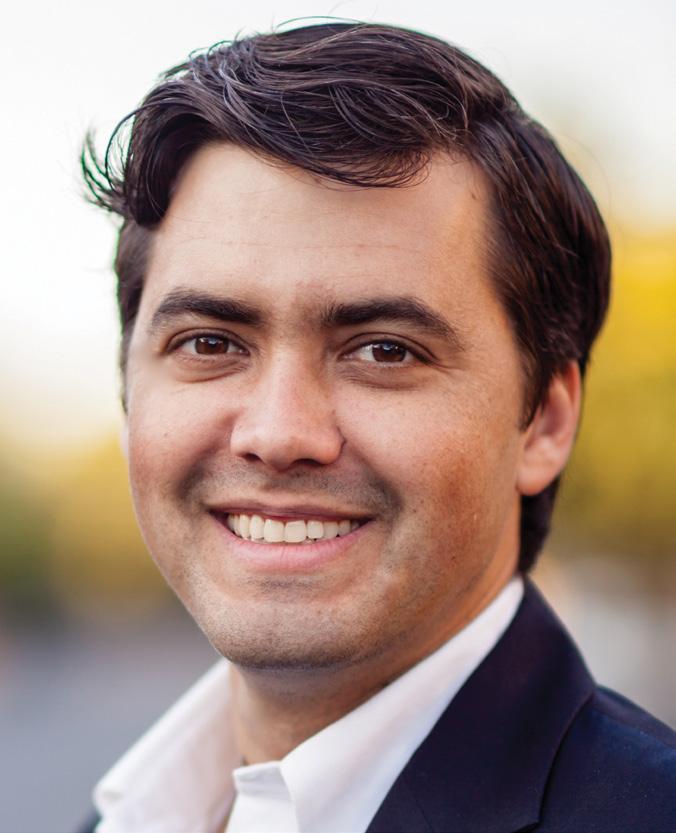

Lindsay Johnson (JD ’13), a partner at Ray & Bishop, PLC in Newport Beach, has distinguished herself in her practice and in the legal community.
She created published law in California at the state Court of Appeals, has served as president of the California Academy of Attorneys for Health Care Professionals and regularly teaches Continuing Legal Education in health care and trial advocacy. At Fowler School of Law, she won top individual and team awards in brief writing and oral advocacy as a member of the moot court team. She is the only student in the history of the law school to receive the top awards in all three categories for moot court competitions.
“The moot court program at Fowler School of Law allowed me to study and explain the law to judges, just like I now do in my practice,” Johnson says. “As a partner at my firm, I now use those skills to make sure the law allows patients to see the best possible providers. I was able to succeed at the highest levels of practice immediately because of this experience.”
Johnson is a director of the JSerra Catholic High School mock trial program. Many of her students have gone to law school, including Fowler School of Law. She also volunteers for the law school’s moot court team as a coach and judge, helping select each year’s Golden Gavel and Golden Quill award winners.
Pollyanna Wong (MMS ’19) was in her patients’ shoes a few years ago.
Wong, a physician assistant at Hoag Hospital, was diagnosed with colorectal cancer shortly after graduating from Chapman’s physician assistant studies program. She took a nine-month leave for chemotherapy, radiation and surgery, and decided to switch from working in pain management to surgery when she returned to work. She started working in colorectal surgery.
“It’s been incredible because I can pay forward what’s been given to me,” she says. “It’s a self-actualizing experience caring for patients going through colorectal conditions. I’m very fortunate and grateful to be where I’m at.”
In addition to caring for her patients, Wong provides ostomy education for
patients and health care providers and is working with her surgeon to develop an integrative surgery program that “looks at surgery through a holistic lens.”
“We’re healing the mind, body and spirit,” she says. “It’s important for us to not just focus on fixing the physical and structural aspects, but rather heal the individual as a whole.”
Wong, who is also working in the inflammatory bowel disease program, plans to continue in her specialty. She credits Chapman’s PA faculty for preparing her as a practitioner.
“I felt comfortable going into the field even though I didn’t have direct experience,” she says. “All the professors were wonderful and helped me progress to the next step in my career.”

STRATEGIC AND CORPORATE COMMUNICATION | SCHOOL OF COMMUNICATION
CREATIVE WRITING | WILKINSON COLLEGE OF ARTS, HUMANITIES, AND SOCIAL SCIENCES
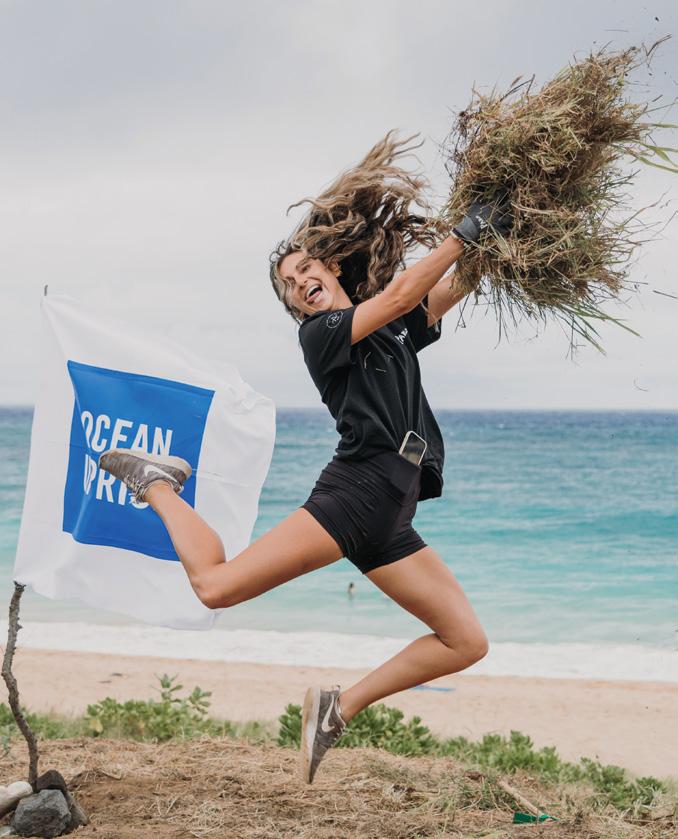
“I spend all of my free time at the ocean,” says Shannon Ball ’21. “It’s my safe haven, happy place, and is where I go for peace of mind, clarity and play. My work revolves around protecting that space that I love so much, so it makes what I do pretty easy.”
From the beaches of Oahu, Hawaii, Ball leads groups of interns and ambassadors as they begin their journeys as environmental activists. She wears a variety of hats as Ocean Uprise Lead at Parley for the Oceans, including mentoring young people from more than 35 countries on how to protect their local bodies of water.
She also organizes events featuring young activists, curates media, hosts educational talks and does grant writing and fundraising. She recently spoke on a panel
at the Ohana Festival in Dana Point about community activism. “Some days I’m out in the field removing invasives and replanting native species; other days I’m giving talks about the importance of the oceans. I really just do anything I can to push the movement forward. Every day is different!” she says.
Ball graduated from Chapman with a double major in strategic and corporate communication and creative writing, knowing that she wanted to pursue a career in ocean conservation.
“I’ve discovered in the last few years that you are the only one in control of your future. Take risks, pursue your passions and follow your intuition,” she says, “The life you want is up to you to create.”
As the head of visual effects at Artists Equity, the film production company owned by Ben Affleck and Matt Damon, Hansjeet Duggal (MFA ’18) is poised to make an impact in Hollywood. Most recently, he served as visual effects supervisor on the Oscar-contender film “Air,” which tells the story of Nike’s quest to recruit Michael Jordan to their brand.
Hansjeet has created visual effects for over 100 projects and also founded his own VFX company, Kiddan LA, which is currently creating visual effects for upcoming projects and employs 1,500 artists in Los Angeles, Mumbai and Europe.
What excites Hansjeet most about his line of work is the fluidity of it. “You work on something, you think, OK, you have figured it out. Then you move on to the next project,
and something new comes up, and you realize whatever you did in the past doesn’t apply to this one ... Every problem has a different solution.”
As a youth, Hansjeet trained as a traditional artist, painting in oils and watercolors, and in Disney-style animation. Over time, he realized that art and technology are two sides of the same creative process.
“Art is challenging the technology and technology inspiring the art,” he says. “And I’m right in the middle, marrying these two forms together all the time.”
In addition to his professional credits, Hansjeet has taught classes in editing, virtual reality and augmented reality at Chapman’s Dodge College of Film and Media Arts and has served as a mentor to many students.

EMMETT GRIFFITH ‘16 |
LGBTQ+ Educator and Diversity, Equity and Inclusion Manager, Stanford University School of Medicine Department of Pediatrics
INTEGRATED EDUCATIONAL STUDIES | ATTALLAH COLLEGE OF EDUCATIONAL STUDIES ENGLISH LITERATURE | WILKINSON COLLEGE OF ARTS, HUMANITIES, AND SOCIAL SCIENCES
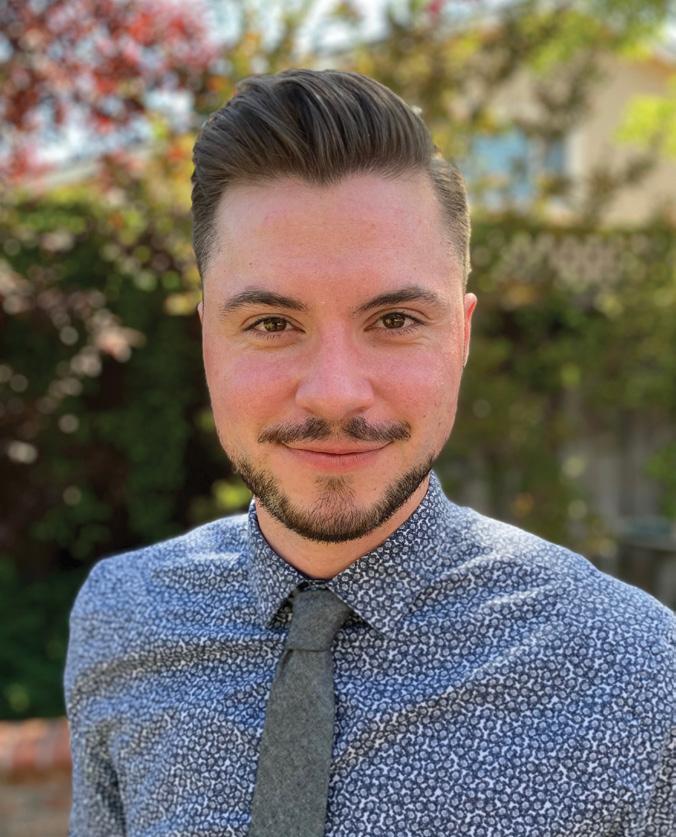
Emmett Griffith ’16 has brought his years of experience working on LGBTQ+ issues in education to social media.
Griffith, who double majored in integrated educational studies and English literature, began posting LGBTQ+ resources for educators in 2022 at @emmett.the.educator on Instagram and booking workshops and educational programs on a variety of topics through his website. He also leads a virtual group for young adults called Cultivating Trans Joy through the Diversity Center of Santa Cruz County.
Griffith’s day job is manager of diversity, equity, inclusion and justice in the pediatrics department at Stanford University School of Medicine. In that role, he manages the HEAL (Health Equity Advanced through
Learning) Initiative, which trains faculty and staff on diversity, equity, inclusion and justice. Before that, he was associate director of Pace University’s LGBTQA+ Center in New York City, where he oversaw student programs, training and initiatives.
Griffith says his experience in those areas started at Chapman, where he was involved in LGBTQ+ and DEI work.
“As a former integrated educational studies major, I am extremely grateful to my professors and mentors who made a significant impact on my life and career, and I am honored to give back to the Attallah College of Educational Studies as an advisory board member to help support the next generation of educators,” he says.
In addition to seeing patients, psychiatrist Eric Rafla-Yuan ’12 is a mental health educator, researcher and health policy expert.
He is a 988 advisor for the California Governor’s Office of Emergency Services and was senior policy advisor for health and human services for the San Diego County Board of Supervisors. He chairs the American Psychiatric Assn. Caucus on the Social Determinants of Mental Health.
“I am driven by the idea that people who are experiencing mental health emergencies deserve effective care and to be treated with dignity — no less than we would expect for any other kind of medical emergency,” Rafla-Yuan says.
This has led to his work and leadership on the new 988 Suicide and Crisis Lifeline and the development of accessible and equitable crisis services for those experiencing psychiatric emergencies.
He serves on the board of the Miles Hall Foundation, which advocates for those impacted by mental illness. He is a
contributing editor for Psychiatric Services journal and was the first person to write about 988 in a major medical journal. He has been published in the New England Journal of Medicine and Health Affairs and in popular media.
Rafla-Yuan was health counsel for Rep. Tony Cárdenas and staff director of the U.S. House of Representatives’ 988 and Crisis Services Congressional Task Force. He is a former psychiatric and congressional fellow and has held several leadership roles with local and state organizations.
After graduating from Schmid College of Science and Technology and Vanderbilt University School of Medicine, he was chief resident of UC San Diego’s Community Psychiatry Program. He founded the psychiatry residency diversity committee at UC San Diego, starting support groups for residents, holistic review processes for residency application review, and a lecture series on health equity, communications and advocacy.
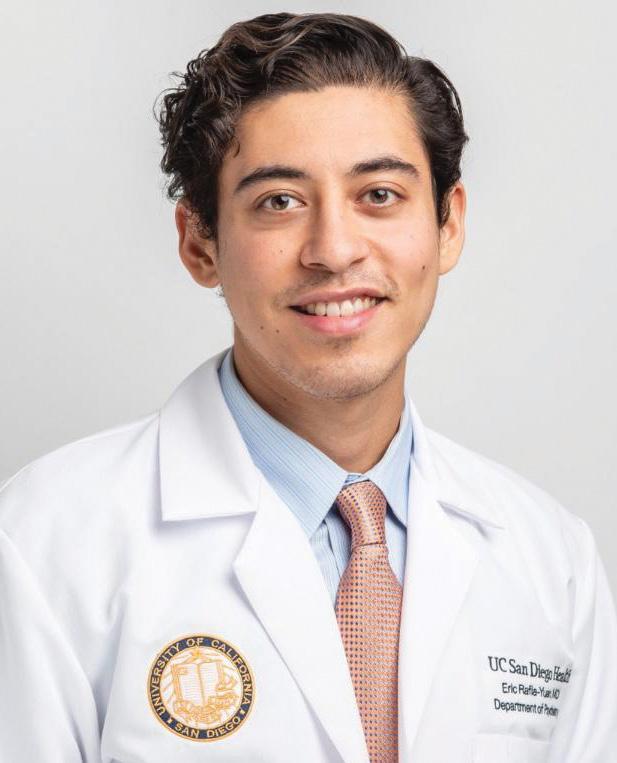
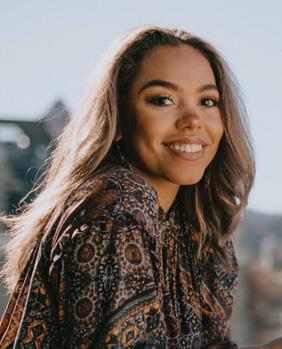
Kyla Stone ’20 knew she was breaking ground for young Black women everywhere when she was cast as the first Black actress to play the lead role in the national touring production of “Anastasia” — a musical based on the animated film that tells the story of a young woman who just might be a Russian princess.
“It’s a show that I hold near and dear to my heart,” said Stone of her history-making role. “I always say that I got to live out my earliest manifesto — wanting to inspire young people the same way I was inspired at such a young age. To have the opportunity to break the mold and prove that all of us strong, often
overlooked women, are so much more than a stereotype was truly an honor.”
“It is one thing to dream about being ‘the first’ of anything, but then to actually do the work and be part of something greater than yourself is so rewarding and humbling,” she said.
In October 2023, Stone made her Broadway debut in the Barry Manilow and Bruce Sussman musical, “Harmony,” as swing performer and understudy to two lead roles. “I think projects like this one that have a strong message, rich history and an amazing group of people is what I want to continue to be part of in the future,” she said.
Jet Propulsion Laboratory
COMPUTATIONAL AND DATA SCIENCES (PH.D.) & COMPUTER SCIENCE AND MATHEMATICS (BS) | FOWLER SCHOOL OF ENGINEERING
As wildfires and widespread smoke have become part of life in the West, ways to track them still have shortcomings.
Enter the work of Nick LaHaye ’13 (Ph.D. ’21), a data scientist at NASA’s Jet Propulsion Laboratory (JPL).
LaHaye and some colleagues at JPL and Chapman developed Segmentation, Instance Tracking, and data Fusion Using multi-SEnsor imagery (SIT-FUSE), which uses machine learning to detect and track wildfires and smoke plumes. SIT-FUSE encapsulates LaHaye’s Ph.D. research at Chapman. It uses unsupervised and self-supervised machine learning, in which the model learns to distinguish between like and different things and creates segmentation maps. Humans are still “in the loop” to add context to these maps, and SIT-FUSE can use data
from instruments on the ground, in the air and in space to give a “tiered multi-sensor view” of wildfires and smoke plumes, LaHaye says.
SIT-FUSE allows for human oversight while eliminating the labor-intensive part of segmenting images, he says.
He and his colleagues are exploring using SIT-FUSE for other ecological issues and natural hazards like algal bloom mapping and oil palm farm identification in the Amazon. LaHaye’s long-term vision is to use his framework to support NASA missions and airborne projects.
LaHaye lectures in Fowler School of Engineering and volunteers as a peer reviewer for American Geophysical Union, Empirical Software Engineering and openaccess scientific journals.
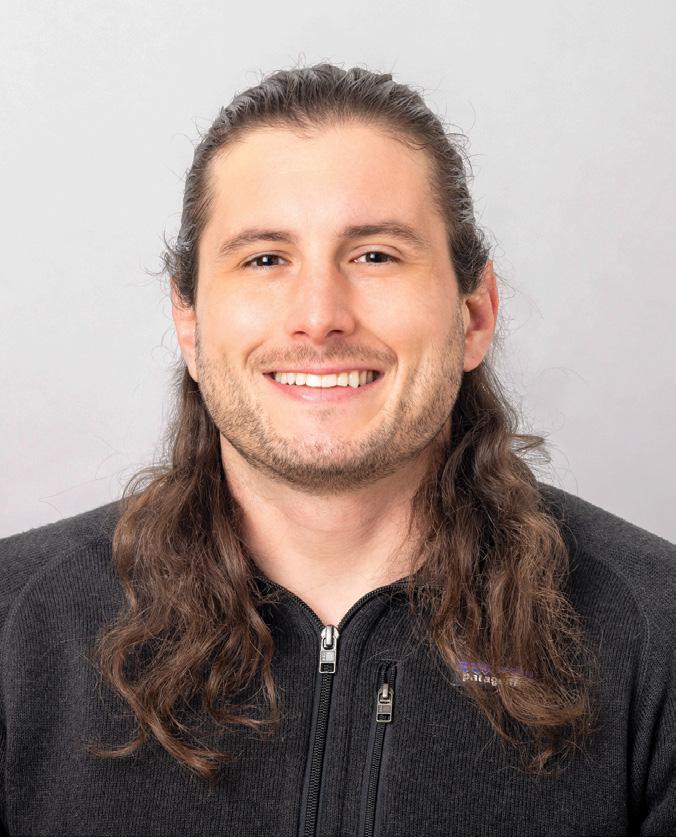
DOCTOR OF PHARMACY | SCHOOL OF PHARMACY

Aafiya Moulvi (Pharm.D. ’22) is using her Chapman education to help people living with diabetes.
Moulvi, who chairs the School of Pharmacy’s alumni advisory board, helped launch a diabetes program designed for vulnerable populations. It’s designed to increase life expectancy and reduce complications, she says.
Moulvi is on a team of 10 pharmacists at MedWatchers piloting the program with doctors.
“I always wanted to be an ambulatory care pharmacist to help people control chronic diseases,” Moulvi says. “So this is my forte, this is what I want to do.”
The program she helped launch aims to educate people on the disease and the
importance of taking the right medication.
“We’re optimizing therapy so patients have better quality of life at the end of the day,” she says.
She said response to the program has been great so far. Her and her colleagues’ goal is risk of heart attack or stroke dropping as patients stay on the right medication.
Moulvi says she feels a deep connection to Chapman because of relationships she made there and gaining “knowledge I can use every day to impact patients’ lives and help my family along the way.
“Knowledge is power and I feel a very strong sense to give back to this institution that gave me this power,” she says.
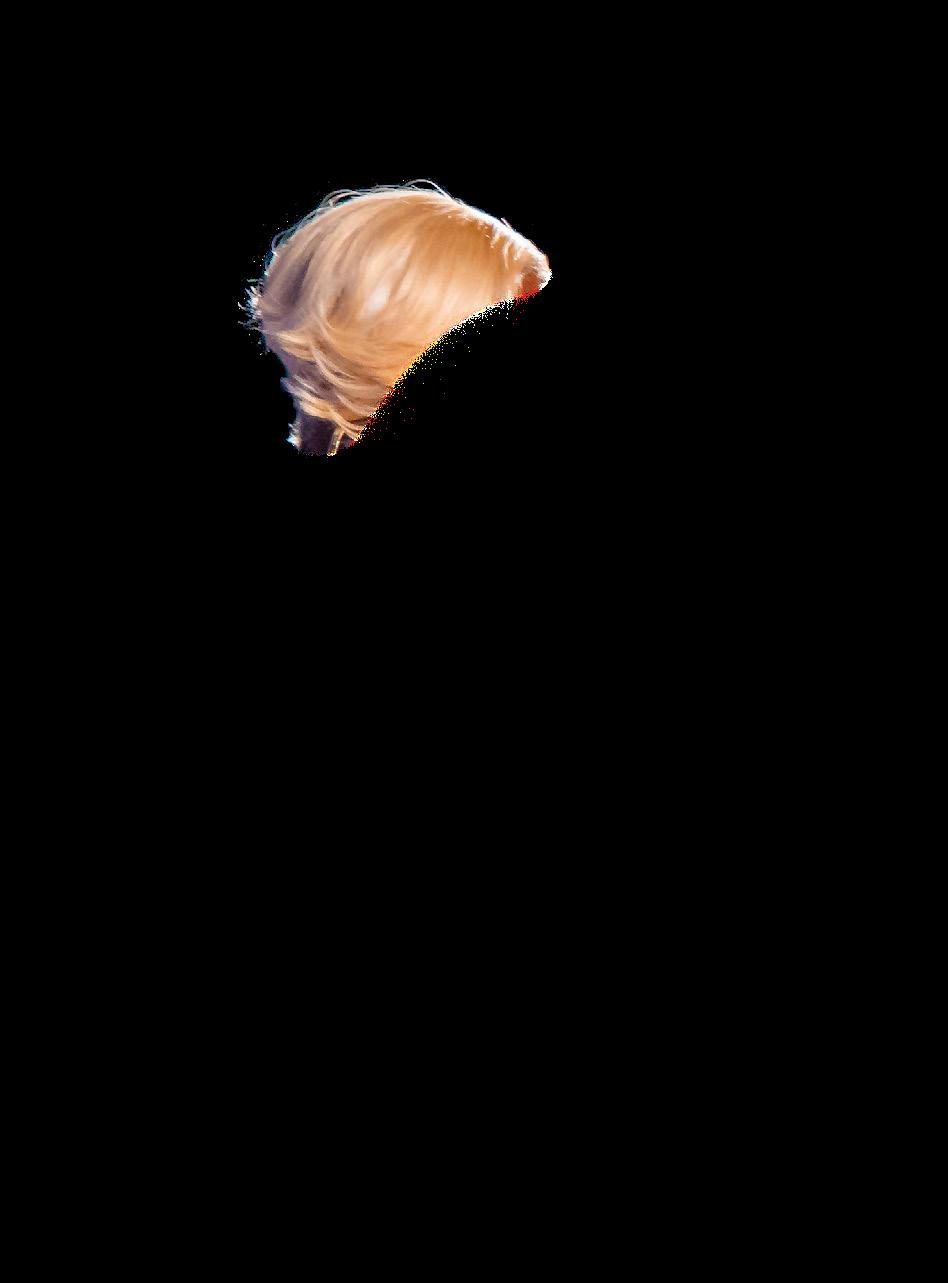 BY DENNIS ARP
BY DENNIS ARP
The unwaveringly engaging Women in Focus conference trains its creative lens on comedy this time, but the conversation goes way beyond setups and punchlines.
Tiffany Haddish didn’t want it to end.
The panel discussion had wrapped, the photos had been taken, and Haddish’s ride was idling out back of Marion Knott Studios. Still, she stood at the edge of the Folino Theater stage, a microphone in her hand and a radiant smile on her face. There was more she wanted to share with Chapman University students.
“The world is coming at you with obstacles, with disapproval, with lots of reasons to think you can’t succeed in a highly competitive industry,” Haddish told them. “So dare to do what you love. Meet that negativity with light.”
“Whatever it is you love to do, don’t ever doubt that you can do it,” she said.

“
Since 2000, Chapman’s Dodge College of Film and Media Arts has been elevating the voices of women in entertainment by organizing an insider discussion and inviting the next generation of industry difference-makers to join in the journey.
For better than an hour, some of the funniest women in Hollywood mixed entertaining stories with deep and reflective insights, making the 500-seat space feel like a cozy chat sesh among friends. As the latest edition of Dodge College’s popular Women in Focus conference started breaking up, it seemed that everyone wanted more.
The 2023 Women in Focus conference was titled “What’s Funny Now?” In addition to Haddish (“Girls Trip,” “Haunted Mansion”), the event featured Molly Shannon (“Saturday Night Live,” “The White Lotus”), Megan Mullally (“Will & Grace”), Yvonne Orji (“Insecure”) and Kerry Ehrin (executive producer of “Bates Motel,” “The Morning Show”).


The discussion was moderated by Janice Min, CEO and founder of “The Ankler” and former editorial director of The Hollywood Reporter.
“This has been an amazing panel,” Min enthused near the end of the event. “Your humor and your honesty have made this a memorable day for me and I’m sure for everyone else here.”

There were lots of laughs, to be sure. When Haddish was asked about her breakthrough moments and how she celebrated hitting it big, she spoke of an unusual splurge.
“I bought a $375 microscope,” she said. “It hooked up to my computer so I could take pictures of what I was looking at. I liked seeing what kinds of bacteria and germs were going around my apartment.”
She added that more recently she has learned what real indulgence looks like.
“I bought another microscope for like $3,000,” she said. “This one tells you what the [stuff] is you’re looking at.”

In Shannon’s case, a unique comedy perspective grew out of a hardscrabble upbringing, which included coping with her mom’s death when she was 4.
“To this day, I don’t like people I know coming to see me perform because I’m afraid I’ll disappoint them,” she said. “It’s like, ‘Meh, she’s not that good’ – that’s a thought I have about my mom. Like she died when I was 4 because I was not such a great kid. You kind of blame yourself. But the beauty is that it gives you this drive and this bounceability in show business, where you can take the blows.”

For Mullally, there was no alternative besides performing, but there were no guarantees of success.
“I always say, I came out of the womb in a top hat and tap shoes,” she said. “I just had to do it.”
She also had to endure a lot of rejection. It took belief and perseverance to not let a seemingly endless string of failed auditions kill her dream of making it in comedy.
“I remember I was in the parking lot of Bed Bath and Beyond on a pay phone with my agent when I said, ‘I am not auditioning for sitcoms anymore – never again,’” Mullally recalled. “He said, ‘Yeah, right.’ And of course I couldn’t pay my rent, so I auditioned for ‘Will & Grace.’”
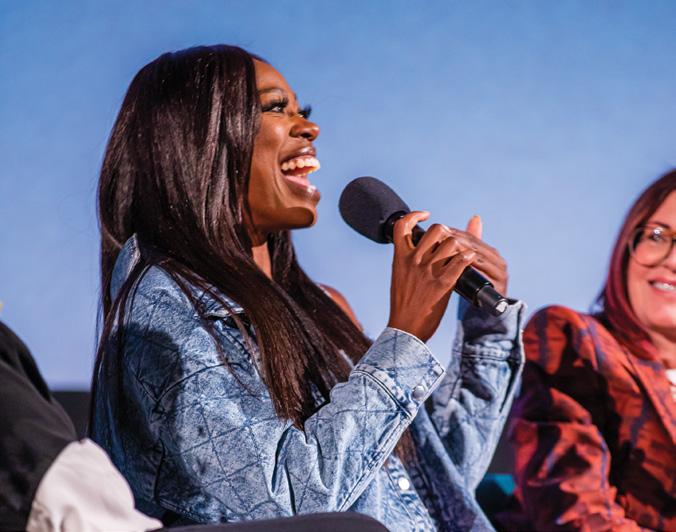
For each of the panel members, the road to success has been anything but direct. As a Nigerian-born immigrant whose parents wanted her to be a doctor, Orji navigated a particularly twisty path.
“I don’t like blood, but I still majored in bio and then got a master’s in public health just to stall, because I had no idea what else I would want to do,” she said.
While in grad school, on a lark, she entered a Miss Nigerian American pageant, which meant that she needed a talent. So she prayed for guidance, “and loud as day I heard the voice of God say, ‘Do comedy,’” Orji said. “I had two weeks before the pageant, so I just started writing what I thought was funny growing up with this dual lens of being both Nigerian and American.”
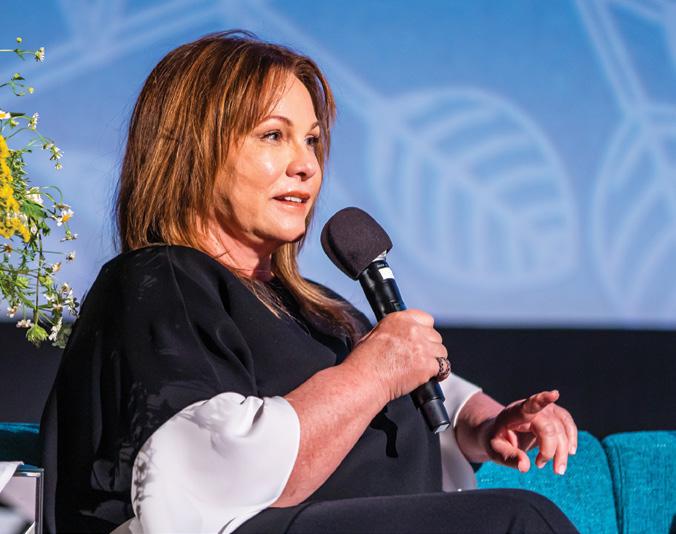
As a writer, producer and showrunner, Ehrin has been on the other side of many an audition. She said it really stands out when an actor displays depth, which “in general, comes from dealing with painful things. As a writer, I connect with that.”
Haddish is all too familiar with pain and resilience. Her mother was in a car accident and struggled with mental illness, so at age 9, before she went into the foster care system, Haddish became the primary caregiver to her four siblings.
“I was not a good mom at 9,” she said. “They don’t have classes for that in elementary school.”
Min read a passage from Haddish’s book, a collection of personal essays titled “The Last Black Unicorn.” This story dealt with her mom, Leola.
“I THINK MY ON THIS PLANET IS TO BRING JOY.”
There, she started winning awards for her monologues in drama competitions, but she was also always in trouble because she acted up in class, copied friends’ work and perpetually tried to make classmates laugh.
Eventually, her social worker gave her a choice during a summer break: start seeing a therapist, or go to the Laugh Factory comedy camp. She chose comedy camp.
“Here I am 30 years later, and I’m living my dream,” Haddish said. “I think my whole purpose on this planet is to bring joy. I mean, I absorbed so much hurt, so much pain from others, but now I also see them walking away from me with a smile on their face. To me, that’s important.”
So important, in fact, that as the Women in Focus event wound down, she had no interest in walking away from her new Chapman friends.
— Tiffany Haddish“If I could make Leola laugh and turn her anger into some joy, I was less likely to get beat,” Haddish wrote. “Same thing in school. If I could make the kids laugh, they’d help me with my homework and protect me from other bullies.”
From the Folino stage, Haddish recounted three-hour RTD bus rides from her South Los Angeles home to attend a middle school and high school in the San Fernando Valley, where she would “use personality and charisma to build relationships and get people to help me while they’re not even realizing they’re helping me.”

Following the panel discussion, the stars posed with Dodge students in Chapman’s Folino Theater.
When she finally did, nothing could have kept her from smiling.
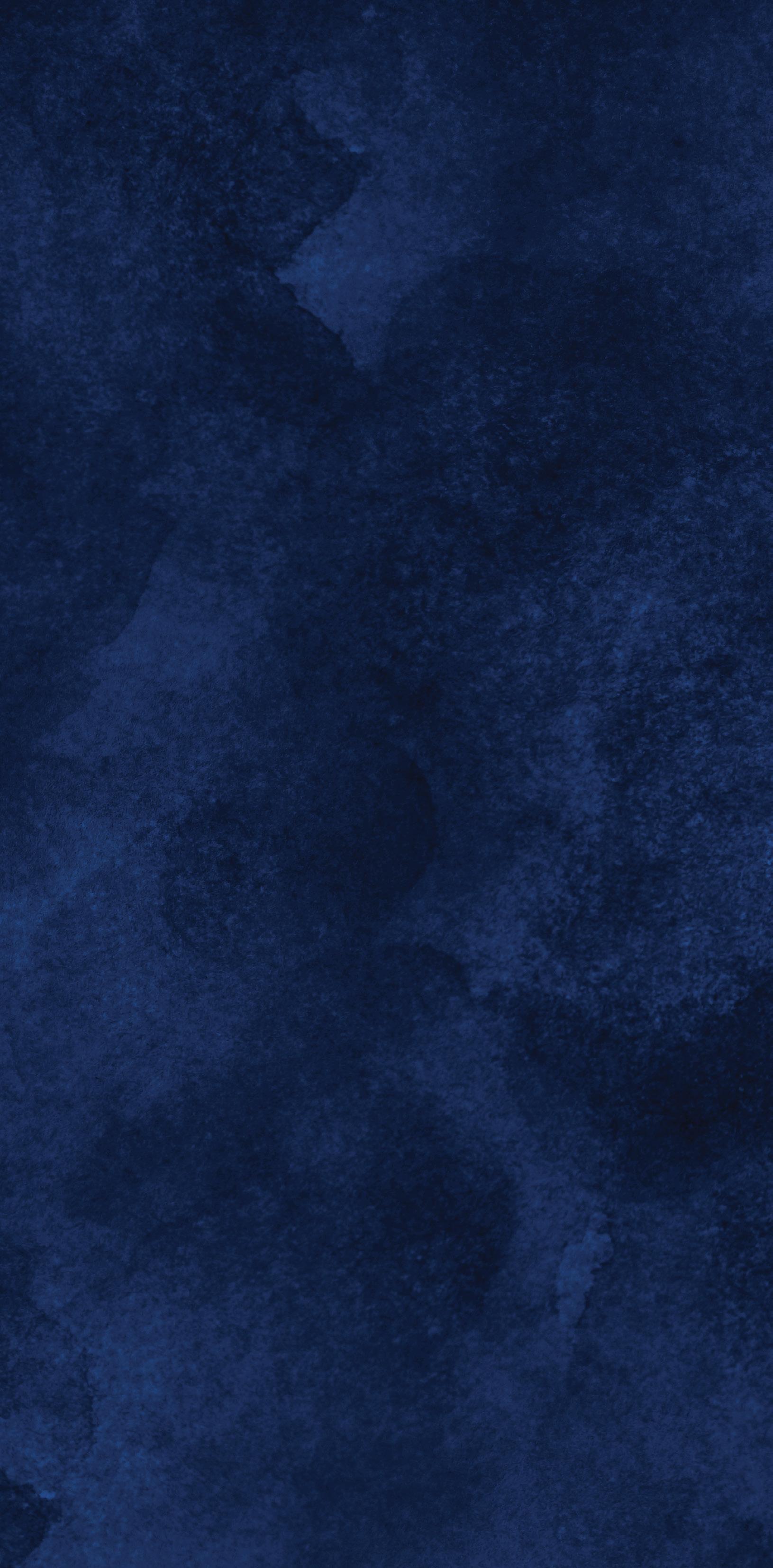 BY RACHEL MORRISON
BY RACHEL MORRISON
In their new book, an artist and a theoretical physicist bridge the complexity of physics with the wonder of discovery in some of the weirdest corners of the cosmos.
In 2015, gravitational waves were first detected by the Laser Interferometer Gravitational-Wave Observatory (LIGO), the world’s largest gravitational wave observatory, comprising two enormous laser interferometers in Washington and Louisiana. This detection also determined the source of the gravitational waves: a collision between two massive black holes 1.3 billion light years away. This further confirmed a key prediction of Einstein’s theory of general relativity, made 100 years prior, and provided the first direct evidence that black holes merge, according to a LIGO statement from 2016.

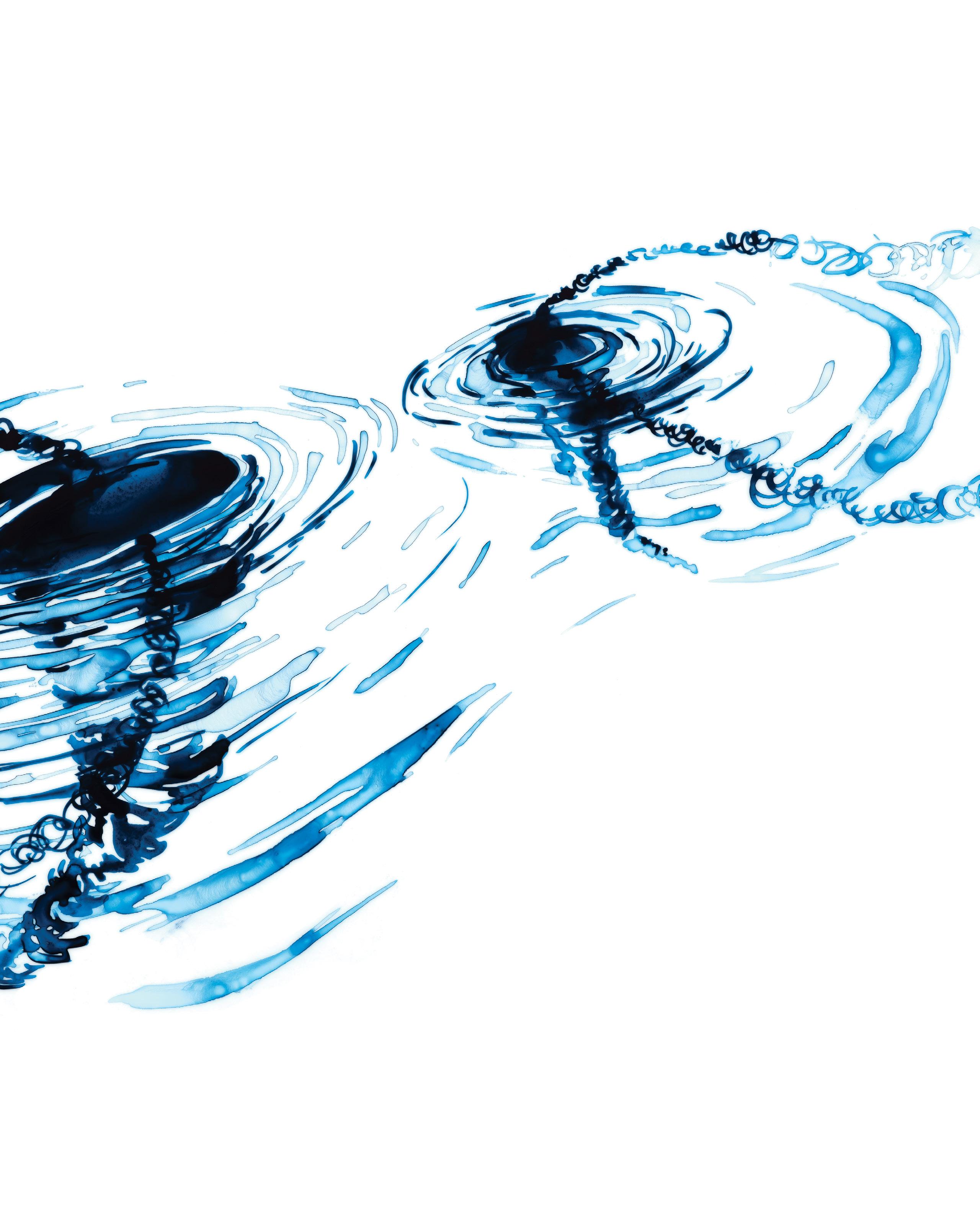


LIGO was co-founded 40 years ago by Kip Thorne, the 2017 Nobel Prize-winning physicist and Feynman Professor of Theoretical Physics Emeritus at Caltech. In 2010, Playboy magazine commissioned an article by Thorne. He suggested the topic of “The Warped Side of the Universe,” which would be based on objects and phenomena made from warped space-time, with art by Chapman Art Department Chair and Associate
Professor Lia Halloran. The article didn’t pan out as planned; as Thorne and Halloran describe it, “Lia’s depiction of [the female figure] was not up to the ‘Femlin standard’ that Hefner required for Playboy women.” However, the experience led to a longstanding collaboration between Halloran and Thorne, whose creative synergy has come to resemble a unique cosmic force itself.
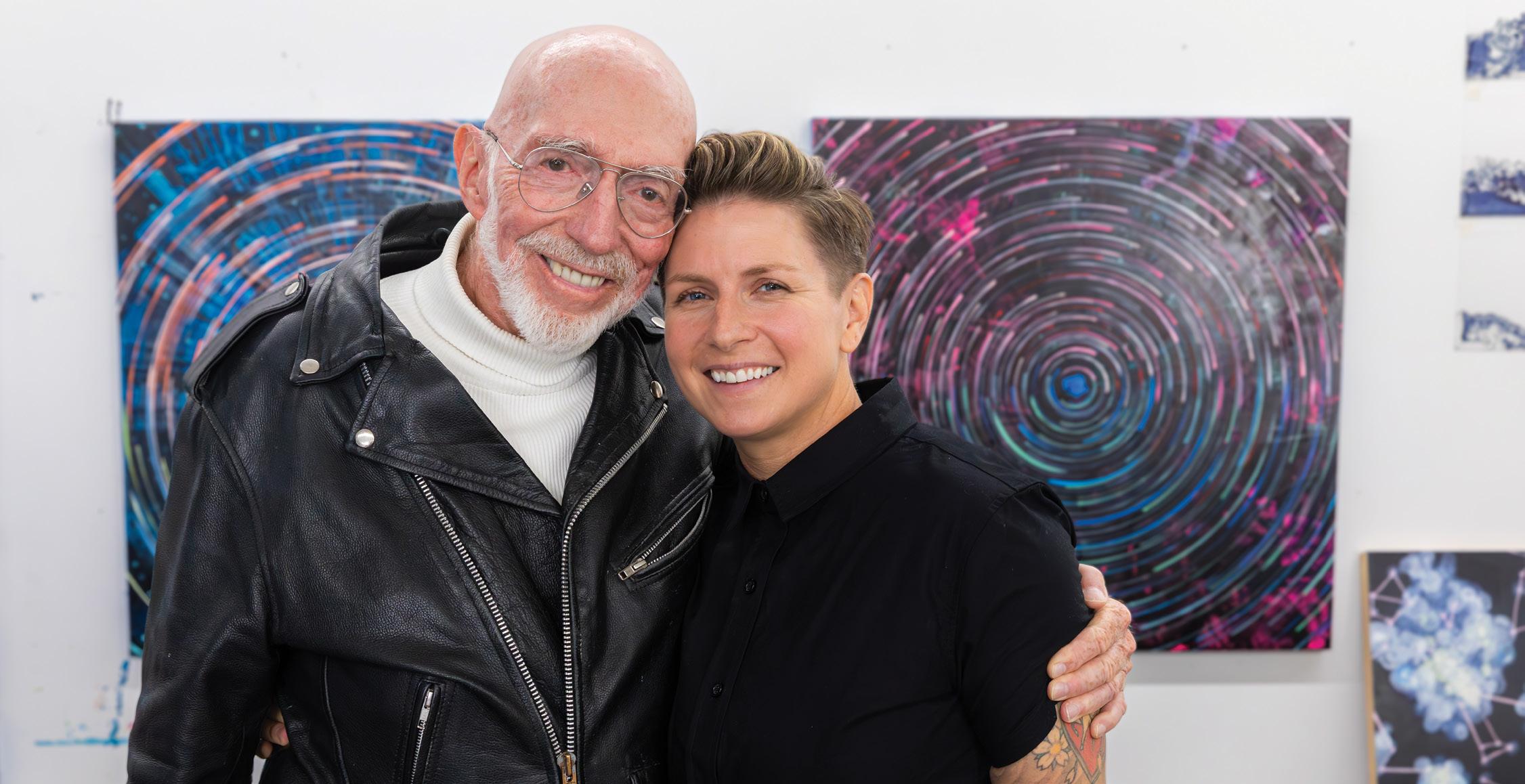



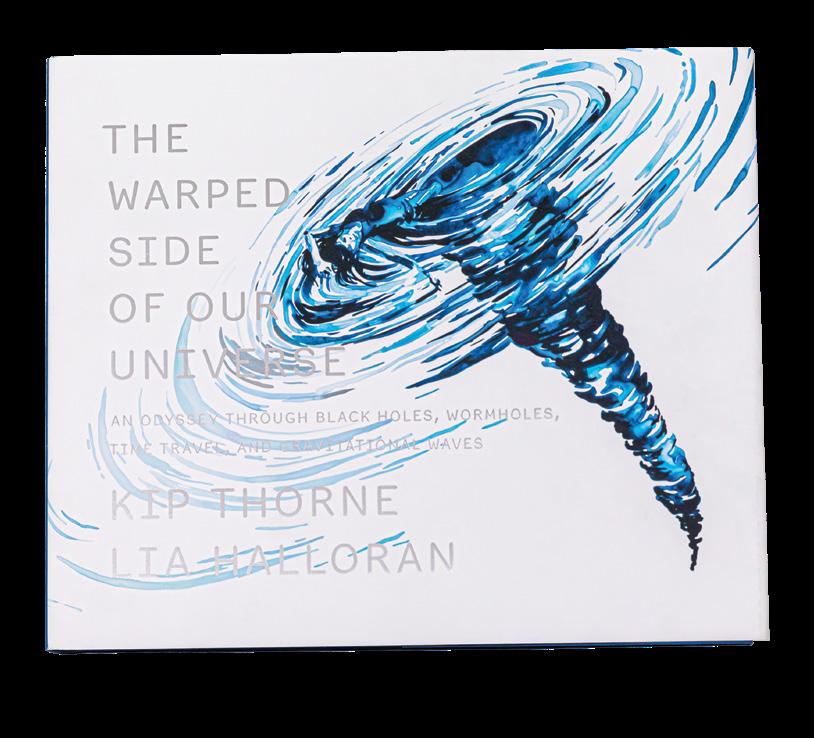
"The Warped Side of Our Universe" includes poetic verse written by Kip Thorne and approximately 150 paintings by Lia Halloran.
Thirteen years later, that would-be article expanded to become the book “The Warped Side of Our Universe: An Odyssey Through Black Holes, Wormholes, Time Travel, and Gravitational Waves” (Norton/Liveright, 2023). Told
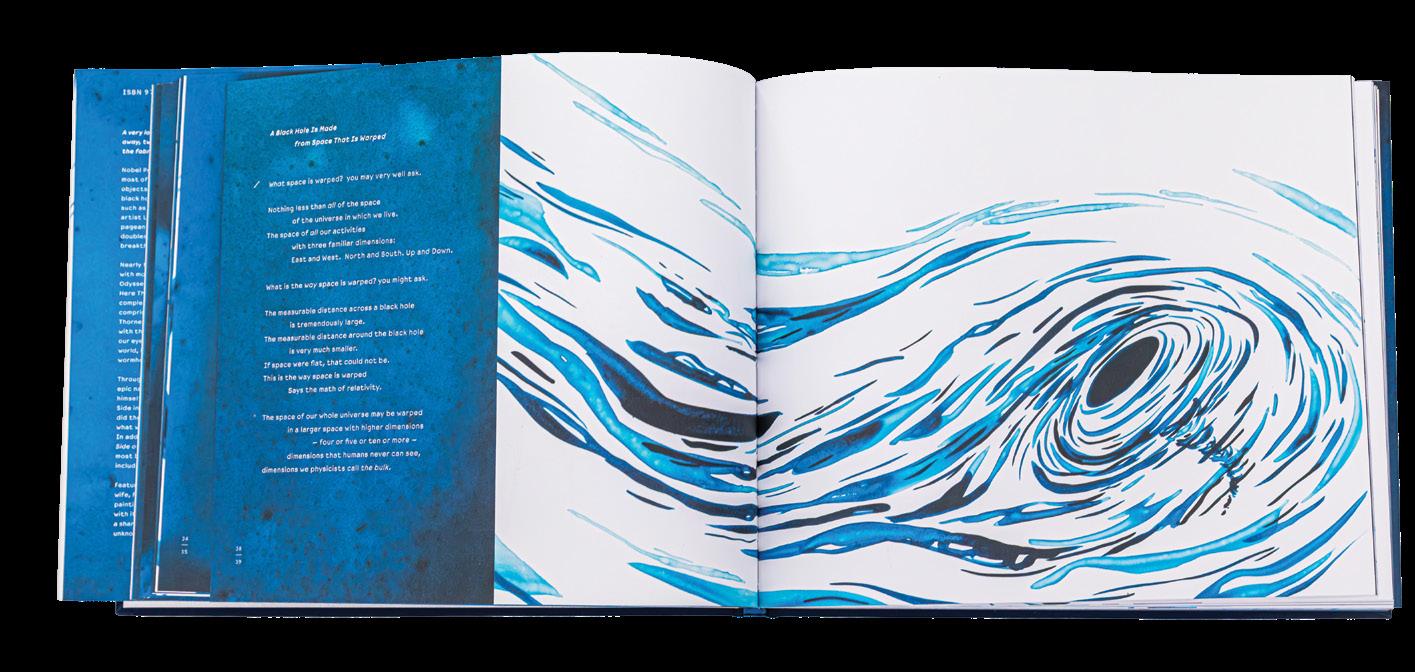

through poetic verse written by Thorne and tightly integrated into original art by Halloran, “Warped Side” explores discoveries in the field of astrophysics from the past decade, including black holes, wormholes, bizarre flows of time and the birth of the universe.
For the project, Halloran created over 500 ink works on drafting film, approximately 150 of which ended up as final paintings in the book, which also features four double-sided gate folds that extend out to over two feet. The book's main character is a spacetime traveler named Felicia, who is modeled in body and spirit on Halloran’s eponymous wife. This choice was intentional. The collaborators didn’t want to write a didactic book about physics; they wanted to provide an entry point to those complex ideas in a way that is accessible to anyone. “The book exposes us to black holes in an intimate and sensual way, through the writing and the paintings and who even appears in the book,” says Halloran. “We aren’t trying to teach about black holes. We’re offering a way to have an intimate and engaging experience of the universe.”

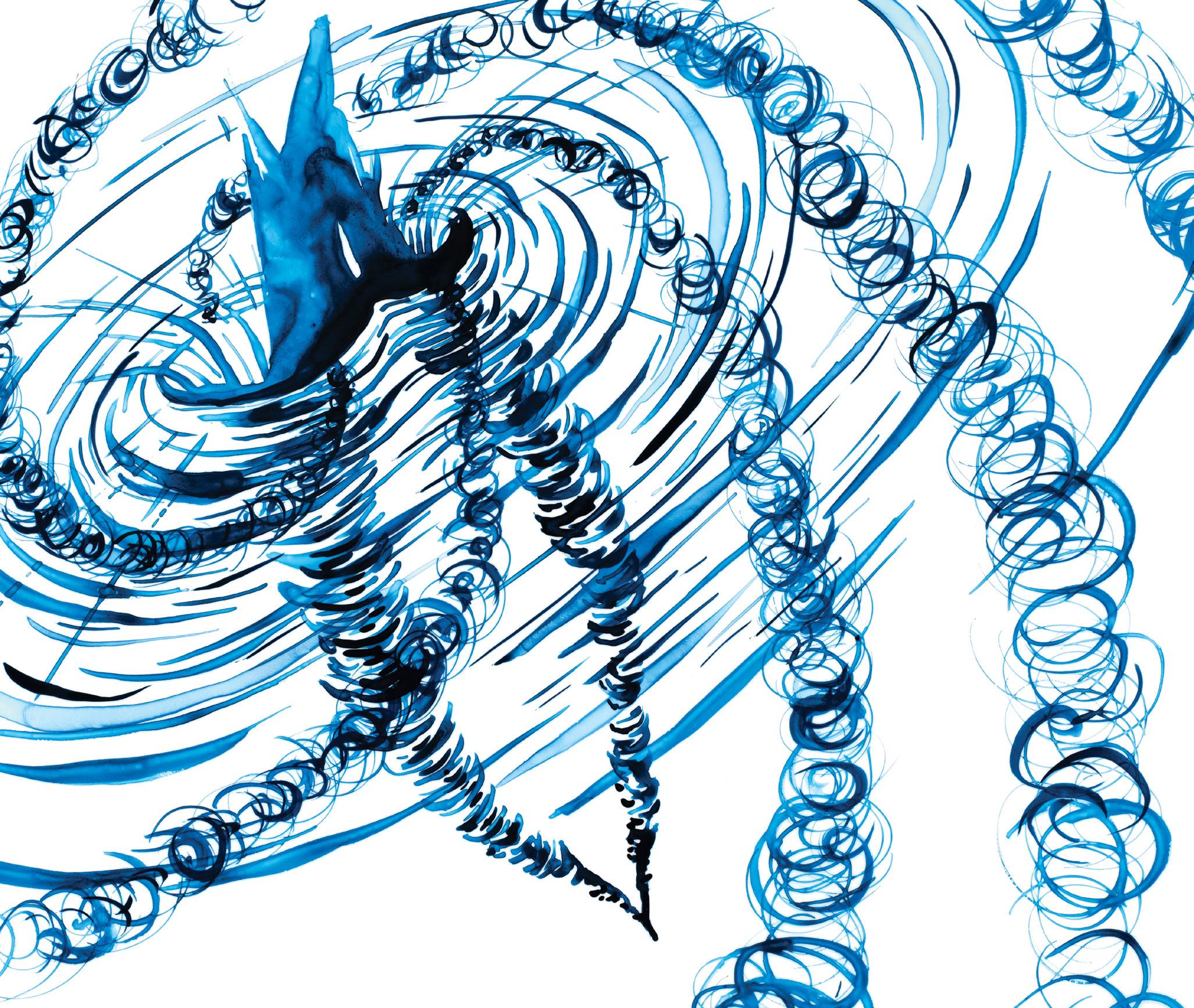

As an artist, Halloran is known for works that merge art and science. Her unique style often incorporates elements of photography, drawing and painting, inspired by celestial phenomena, and considers themes of exploration, human curiosity and our place in the vastness of space.
Halloran’s cognitive process and creative practice enable an interdisciplinary approach to her art. “My studio functions like a laboratory,” she says. “It starts with a question, and then we orbit around that question from multiple perspectives.”

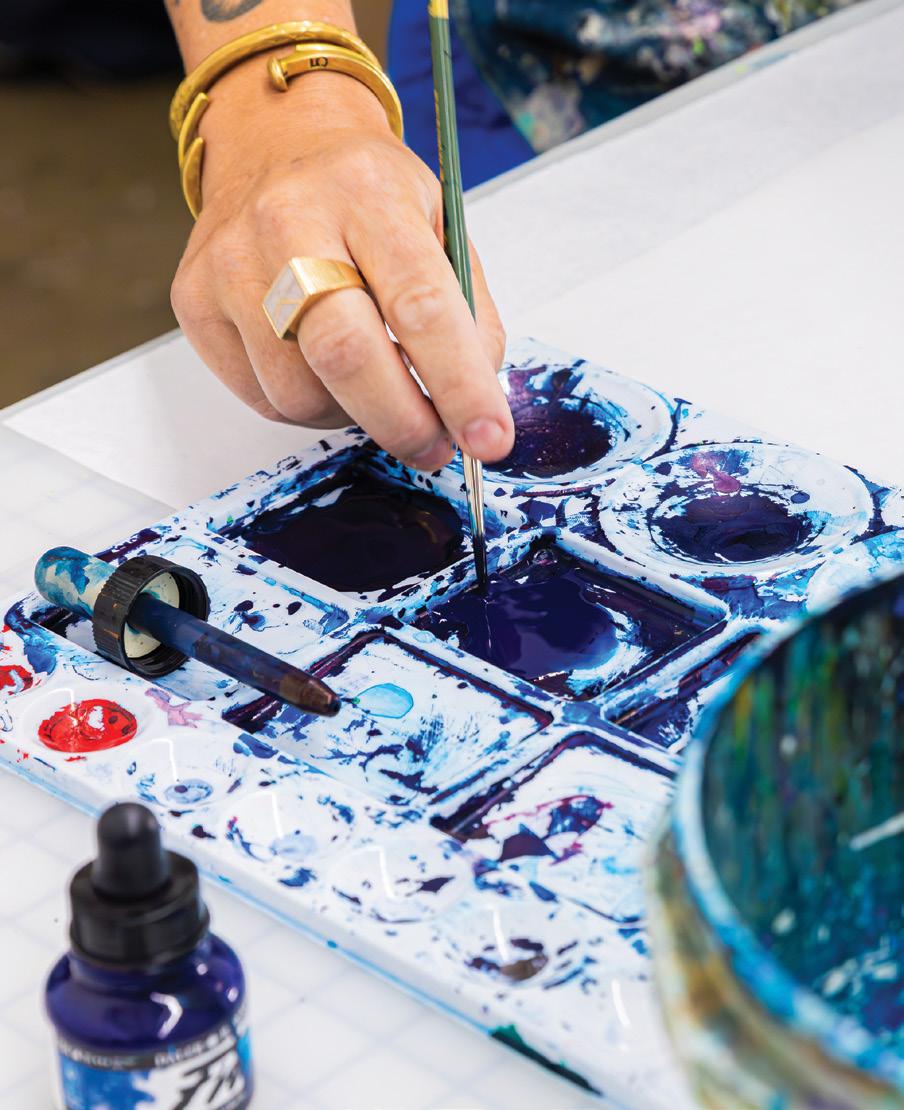
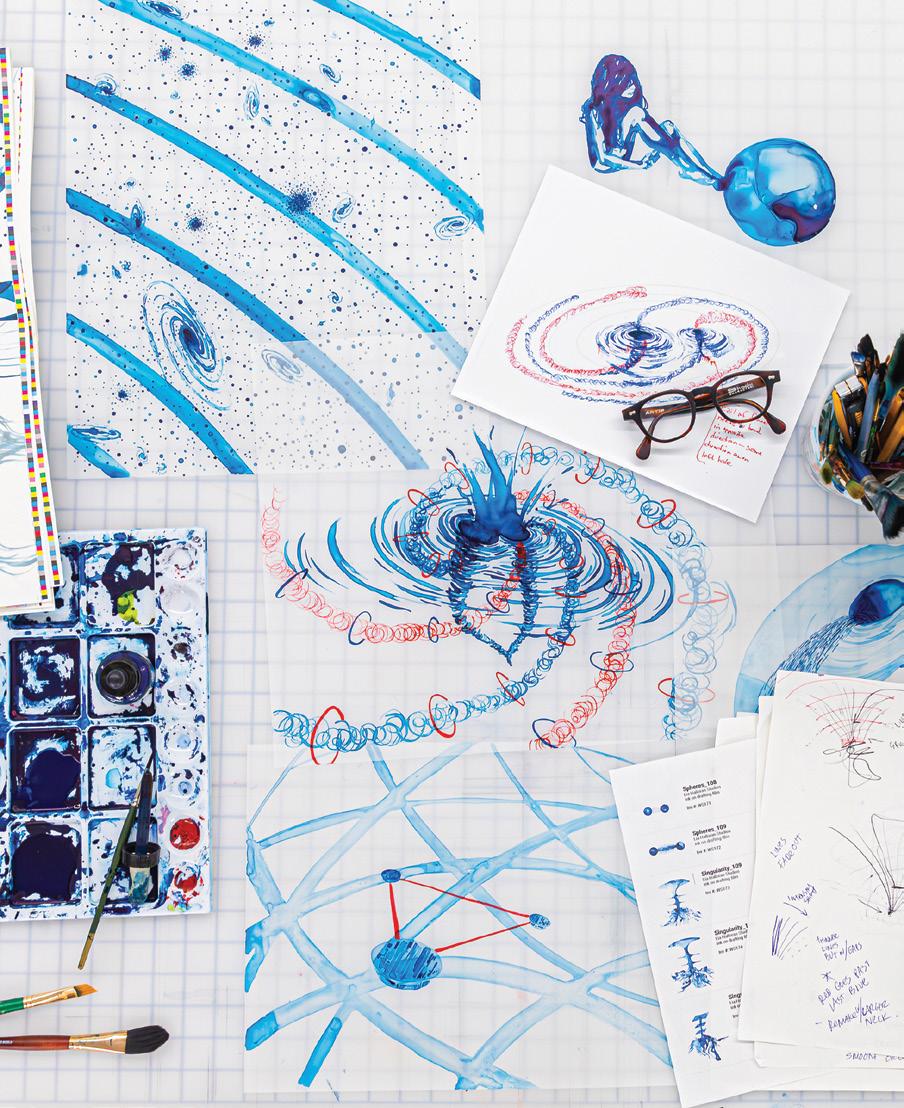
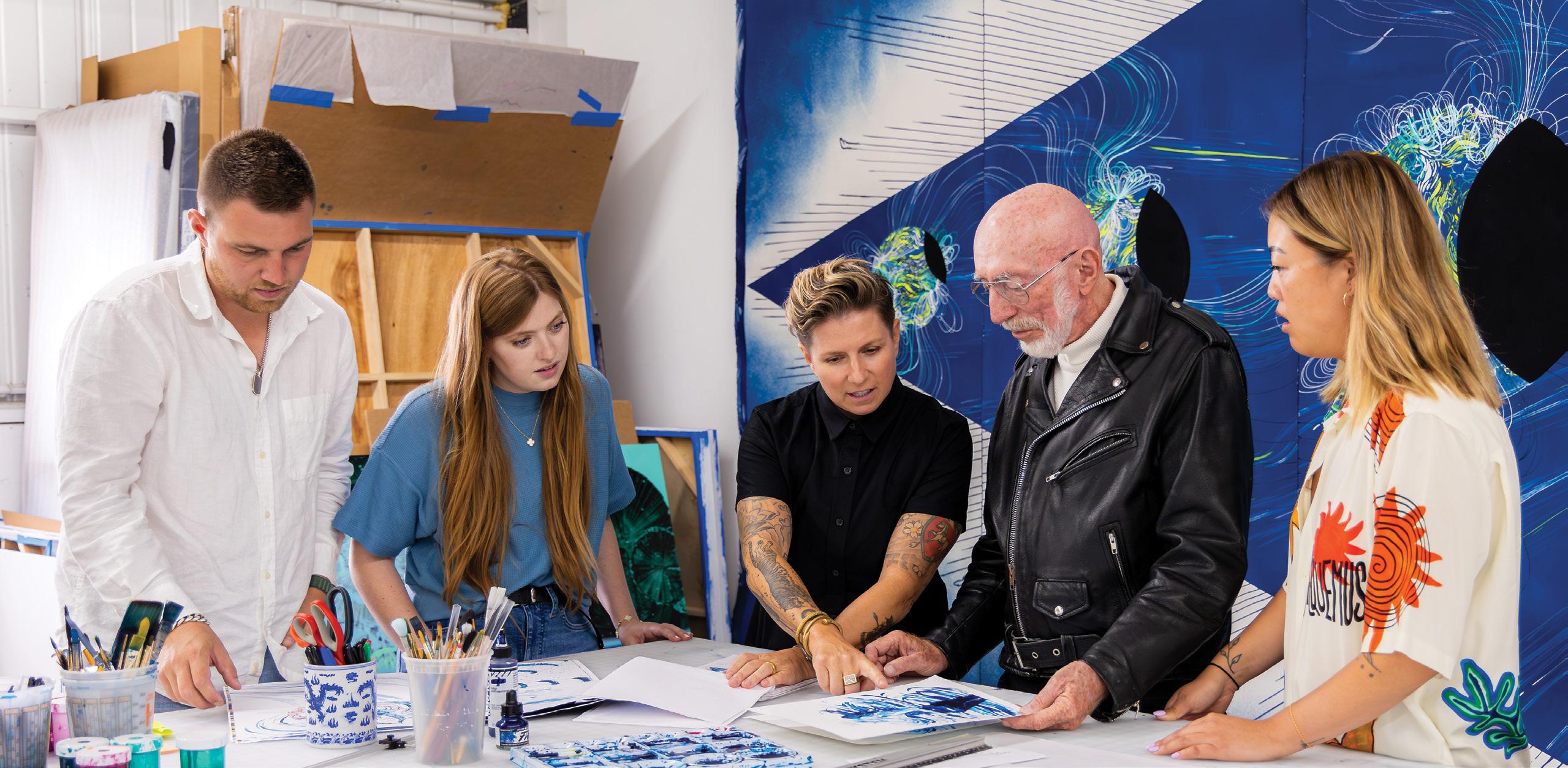
Halloran brings ideas from her work as an artist into the classroom, and many of her Chapman students have become longtime studio assistants. Adam Ottke ’13 was among the students who took the course "The Intersection of Art and Science" over a decade ago, and he worked on image handling and color correction for the final version of “The Warped Side of Our Universe.” “I was always interested in interdisciplinary study, in science and math,” says Ottke, who also has his own photography studio. “Lia showed us, in the real world, how science and art can coexist and inform one another.”
Consider the concept of “Up.” In 2015 Halloran began learning to fly a Cessna 172. “As I was flying, I was thinking through the physics and the feeling of being unbounded by the Earth,” she recalls. This contemplation led to the creation of a piece titled “Double Horizon,” an immersive three-screen video installation, shot over two years during the course of more than 30 flights. Halloran describes the video as a “double portrait” — of the city of Los Angeles and as a self-portrait of the artist in the cockpit flying above the city. The art investigates how space can be experienced differently when there are shifts in perception, time and scale. An ArtCenter article published in advance of the 2020 exhibition at the college’s Peter and Merle Mullin Gallery notes that in “Double Horizon,” “Halloran traverses the landscape in ways most won’t and
asks the viewer to reflect on the poetic nature of the body’s relationship to its environment. (“Double Horizon” had a four-month run at the San Francisco Exploratorium museum in 2022, as well as in several other solo exhibitions.)
This experience of learning to fly also led to a course called "Up," which Halloran co-taught with Claudine Jaenichen and Anna Leahy, both professors in Chapman’s Wilkinson College of Arts, Humanities, and Social Sciences.
“The idea for the course was, because so many of us are fascinated by being ‘up,’ we can build a class from the perspective of physics, design, writing, art, history and future dreaming. We take the concept, circle around it, and engage all the disciplines,” Halloran says.
Jen Seo ’14 took the same course over a dozen years ago. She has assisted in Lia’s studio on an early layout draft of “The Warped Side,” the series “Deep Sky Companion,” which is permanently installed at Caltech in Pasadena, and the early testing of large-scale cyanotype prints in the series “Your Body Is a Space That Sees.” “What’s great about Lia is that when she gets excited about an idea, she doesn’t just silo away. For most artists, it’s lonely work. But she will take the idea and bring people in, start conversations,” says Seo. “She brings her ideas to the class—they guide what she’s teaching. And that creates a community on campus, and it invites us into her world.”

In 2014, Halloran created a travel course titled "The Origins of Art and Science," in which students spent three weeks during the Interterm session in Florence, Italy, to study the interconnection of the arts and science during the Renaissance. “Alchemy, the fountains of medical schools, collecting of objects from the natural world — this all plays into how we understand science now,” she says. In another course, "The Intersection of Art and Science," Thorne took the class to visit a prototype of LIGO at Caltech in Pasadena.
For Halloran, teaching is an extension of her studio practice.
She brings ideas from the studio into the classroom and invites students to participate in her thought processes and art.
Halloran credits Chapman’s unique environment for her ability to design and teach courses that follow an interdisciplinary mode of inquiry. “Chapman has enabled such autonomy and interdisciplinarity. President Daniele Struppa and Wilkinson College Dean Jennifer Keane have really fostered this,” she says. “But the culture of interdisciplinarity also emanates from faculty across the college and the students themselves.”
You can see Halloran's work and a list of public speaking events to celebrate the launch of the book at www.liahalloran.com or on Instagram @liahalloranstudio.
Original art from "The Warped Side of the Universe: An Odyssey Through Black Holes, Wormholes, Time Travel, and Gravitational Waves" by Kip Thorne and Lia Halloran. Text Copyright © 2023 by Kip Thorne. Illustrations Copyright © 2023 by Lia Halloran. Used with permission of the publisher, Liveright Publishing Corporation, a division of W. W. Norton & Company, Inc. All rights reserved.


“IN THE BOOK, WE AREN’T TRYING TO TEACH ABOUT BLACK HOLES. WE’RE OFFERING A WAY TO ENGAGE WITH AND HAVE AN INTIMATE AND ENGAGING EXPERIENCE OF THE UNIVERSE.”
— LIA HALLORAN

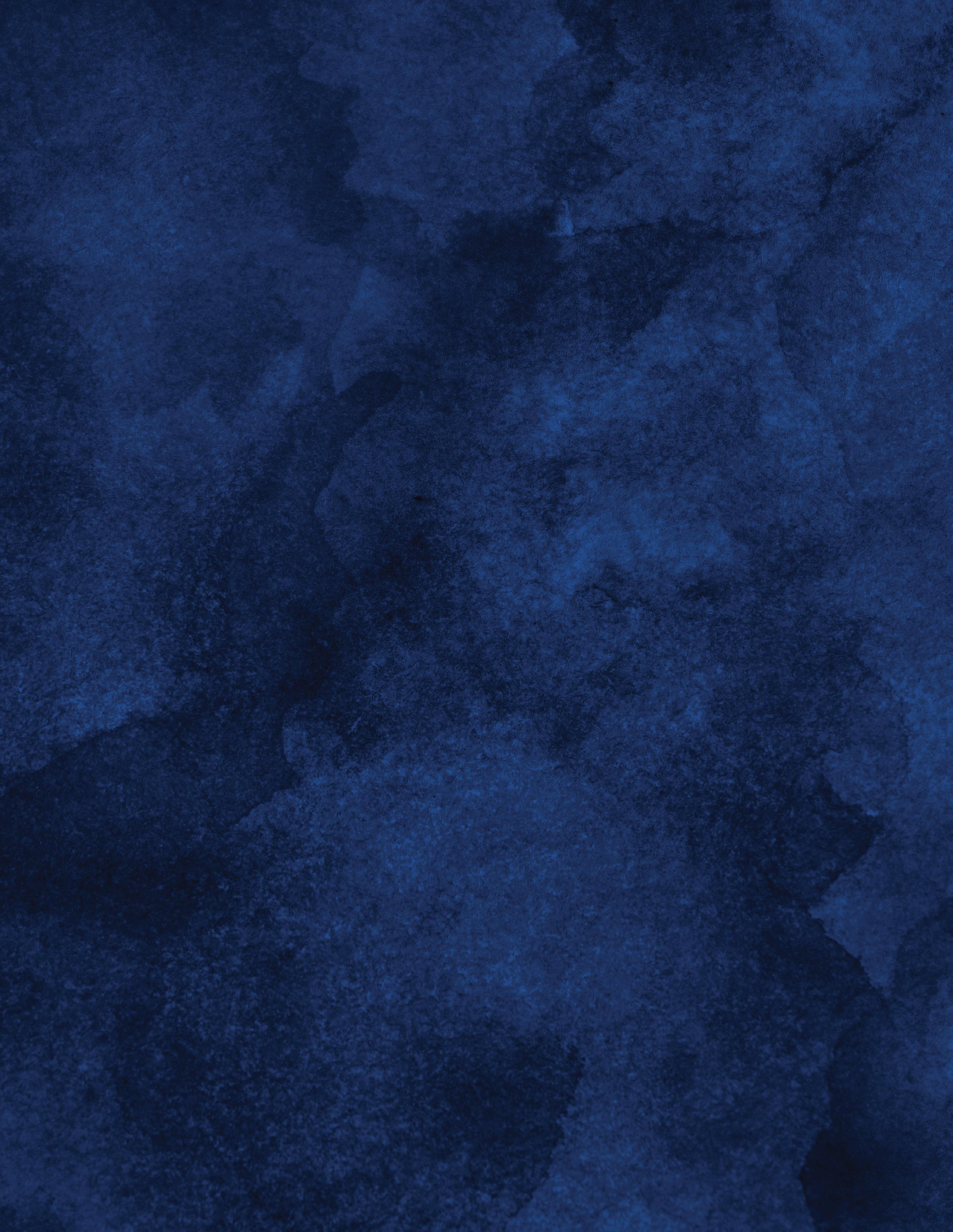
At Chapman, we drive excellence by fueling curiosity within a community distinguished by an energy of innovation, collaboration and support — on a campus pulsing with intellectual, creative and social vibrance unlike anywhere else.

Since its launch, Inspire: The Campaign for Chapman University has provided for the future of Chapman by supporting a personalized education of distinction as we continue our momentum to become one of the most highly regarded universities in the nation.
These philanthropic contributions provide capital and academic program enhancements, fund scholarships and financial aid for students and support the expansion of the endowment, which secures our financial foundation.
To learn more about how the comprehensive campaign is driving the future of Chapman, visit: chapman.edu/inspire.

Consider the impactful moments that have shaped your journey: navigating new relationships and opportunities, pursuing your passions and forging your path in life.
At Chapman University, we celebrate these defining Chapman experiences while excelling in what sets us apart: providing students with a personalized education that fosters close faculty-student connections and abundant personal and professional opportunities.
Maria '26 is one of the many students at Chapman who have embraced these unique qualities of the university.
“A distinguishing feature of being a Chapman student is the privilege of engaging in intimate classroom settings that foster close-knit interactions with every educator,” she explained. “This personalized approach to learning has been a highlight of my academic experience.”
Maria is pursuing a double major in strategic and corporate communication and psychology. As she contemplates her future career path, her aspirations gravitate toward advertising and marketing.
“This inclination influenced my decision to pursue strategic and corporate communication as my second major, as it aligns with my professional goals,” she said.
Furthermore, Maria is deeply involved in the campus Public Relations/Advertising club and is an active sorority member.
“These extracurricular pursuits have enriched my collegiate life and contributed to my personal growth,” she said.
Maria’s involvement and opportunities are even more meaningful because of the Chapman Fund scholarship she received.
“My academic journey to Chapman University was made possible by the generous Hesperian scholarship, which facilitated my enrollment,” said Maria. “The availability of financial aid was instrumental in allowing me to attend Chapman, for which I am truly grateful.”
The Chapman Fund supports students’ educational journeys by facilitating merit- and need-based scholarships to over 80% of students.
“I deeply appreciate Chapman’s contribution to my academic pursuits,” Maria said. “My time at Chapman has proven transformative, allowing me to forge meaningful connections with exceptional individuals who continually inspire my personal development.”

“My time at Chapman has proven transformative, allowing me to forge meaningful connections with exceptional individuals who continually inspire my personal development."
— Maria '26
On the heels of the warmest months on record for Earth, a new study that includes work by two Chapman University scientists finds that the world’s tropical forest canopies may be closer to critical high-temperature thresholds than previously thought.
However, the researchers add that moderately ambitious climate-change mitigation can help keep more trees from reaching these dangerous thresholds.
The study was published in the prestigious academic peer-reviewed journal Nature in August 2023. The research was funded by NASA as well as government agencies in Australia and the United Kingdom.
Chapman scientists Gregory Goldsmith, Joshua Fisher and 16 colleagues estimate that the world’s tropical forests can withstand a nearly 4 degrees Celsius increase in air temperature due to climate change before reaching a potential tipping point in the breakdown of biological function.
A small percentage of tropical leaves are already reaching that threshold of photosynthetic function, according to data collected from across the world’s tropical forests, including in the Caribbean, Central America, South America, Africa, Australia and Southeast Asia.
The alarming implications of foliage temperature rise and biological breakdown have shined a spotlight on the research done by Goldsmith, Fisher and their colleagues. Media outlets from ABC News to CNN, Barrons to Scientific American have reported on their study.
Yet, “the results do not indicate that reaching a tipping point for tropical forests is fait accompli,” Goldsmith said. “We still hold in our power the ability to conserve these places that are so critically important for carbon sequestration, water and biodiversity.”

“ WE STILL HOLD IN OUR POWER THE ABILITY TO CONSERVE THESE PLACES THAT ARE SO CRITICALLY IMPORTANT FOR CARBON SEQUESTRATION, WATER AND BIODIVERSITY. ”— Gregory Goldsmith


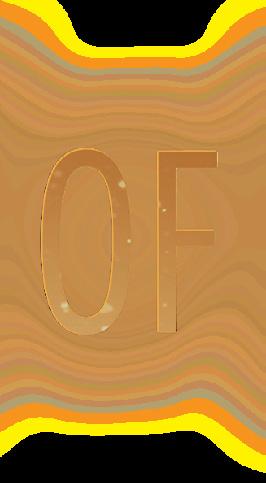
 BY DENNIS ARP
BY DENNIS ARP
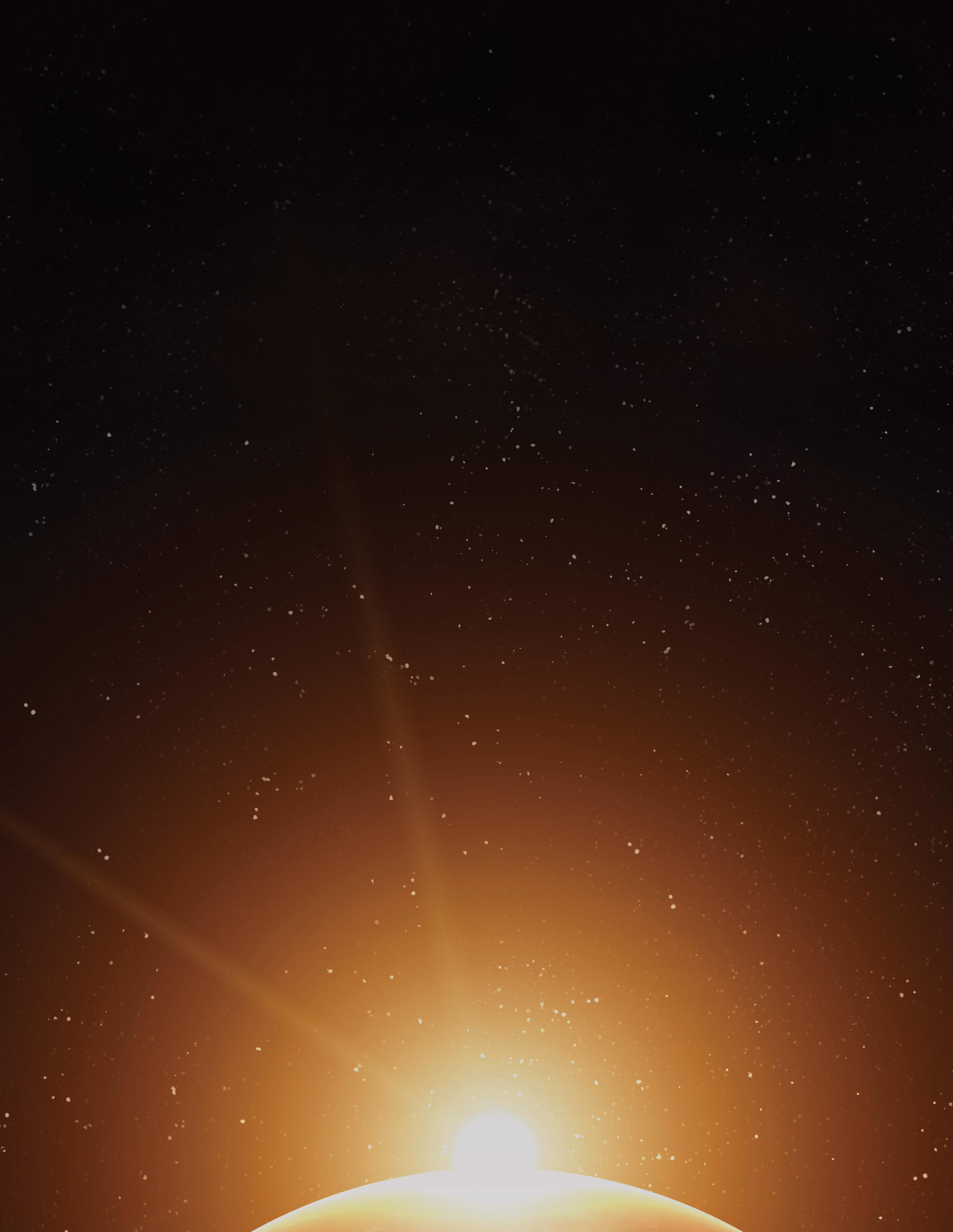
Reaching beyond the rainforest treetops to gather data in space, Chapman scientists stretch the boundaries of collaborative research, creating new landscapes for climate insight.
Sometimes scientific breakthroughs start with a slingshot in the wilderness.
“ JOSH’S WORK GETS US TO GLOBAL SCALE LOOKING DOWN, WHILE I’VE BEEN AT LEAF SCALE AND FINER SCALING UP. THEN WE MEET IN THE MIDDLE. ”
— Gregory Goldsmith
Deep in the rainforest of Costa Rica, Chapman University biologist Gregory Goldsmith aims high into the tree canopy and launches the weighted end of a nylon rope that will become his climbing lifeline.
“Basically,” Goldsmith says as a National Geographic video of his research plays on his laptop, “you shoot this line over a big branch and hope that it catches. Then you use mountaineering ascenders and you’re basically pushing yourself up the rope.”
Along for the ride are thermocouple wire and temperature sensors that attach to individual leaves, as well as a car battery to power the capture of information about the health of the trees. As Goldsmith shimmies from branch to branch, applying sensors from leaf to leaf, the data net widens. It’s painstaking and exhausting, but over time Goldsmith gets a read on the forest from the trees.
“If you’re going to understand biodiversity, at some point you have to go to the tropics, and then you’ve got to get into the canopy,” says Goldsmith, associate professor of biology and associate dean for research and development in Chapman’s Schmid College of Science and Technology.
Still, the leaf-by-leaf approach is only one chapter of the story. Getting a next-level grasp on conditions that stretch past the horizon requires a leap into the beyond.
That’s where Joshua Fisher comes in.
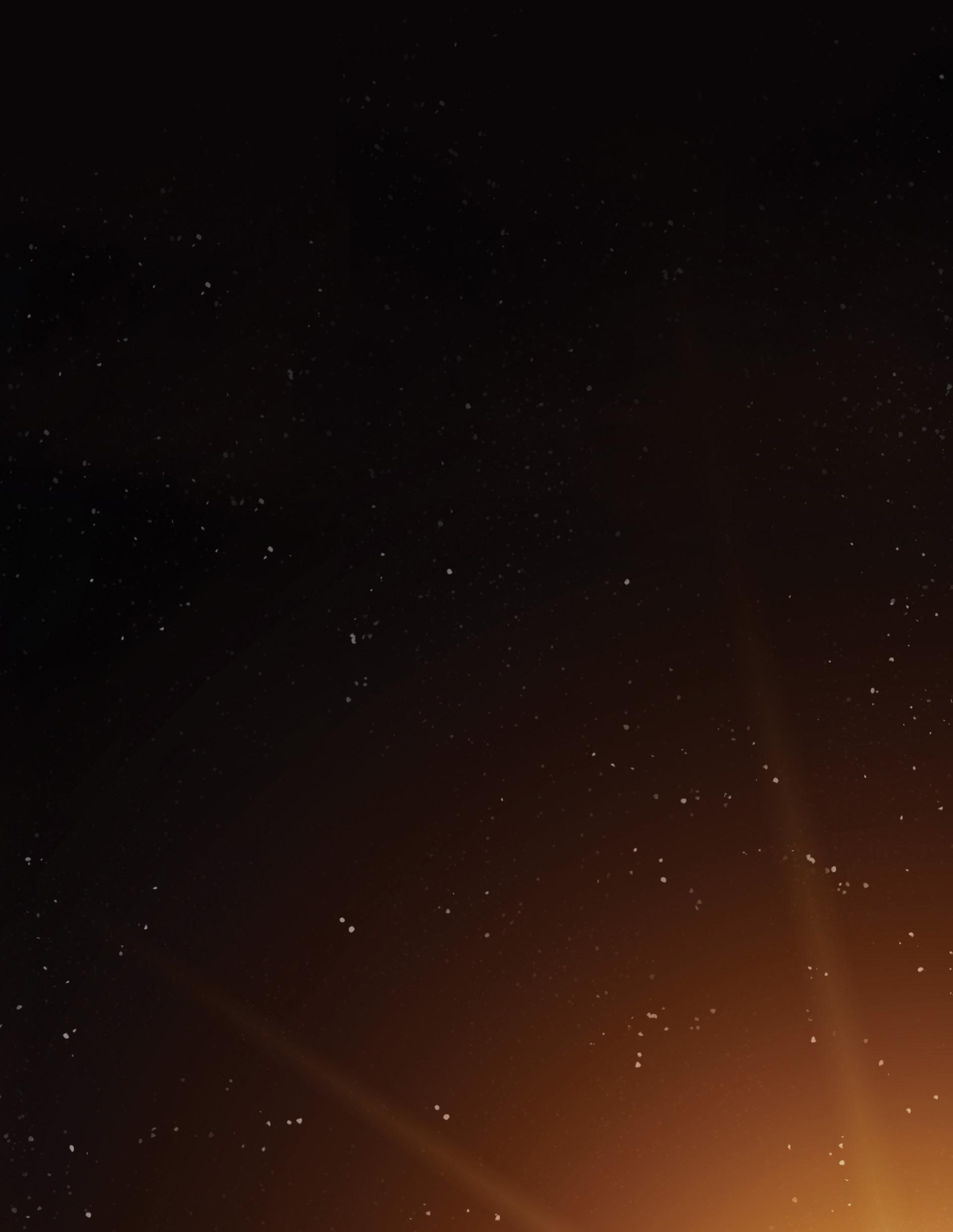
Before Fisher’s office was just down the hall from Goldsmith’s at Chapman, he was a scientist at NASA’s Jet Propulsion Laboratory. It was Fisher’s idea to place a thermal infrared radiometer on the International Space Station to study Earth’s ecosystems.
Five years later, that instrument — which is called ECOSTRESS — orbits the globe about every 90 minutes, taking images while capturing temperature and moisture data.

“It allows us to determine plant water use nearly anywhere on Earth at spatial scales that were unthinkable just a few years ago,” says Fisher, associate professor of environmental science and policy at Chapman.
From rainforest treetops to more than 250 miles out into space, a comprehensive portrait of biological stress is now coming into focus.
“The fact that ECOSTRESS can provide 70-meter resolution at 17,000 miles per hour is a gamechanger,” Goldsmith says. “Josh’s work gets us to global scale looking down, while I’ve been at leaf scale and finer scaling up. Then we meet in the middle.”
These days, the two share space and ideas on the second floor of Chapman’s Keck Center for Science and Engineering. There, Goldsmith, Fisher and other colleagues translate data into research findings with monumental ramifications.

On Aug. 24, discoveries by Goldsmith, Fisher and 16 other scientists were published in a cover story in the prestigious academic journal Nature. Their study, “Tropical forests are approaching critical temperature thresholds,” found that rainforest leaves are reaching dangerously high temperatures, triggering alarms about ecosystem breakdown and the dire effects of human-driven climate change.
“We want to understand the future temperatures of tropical forests because they hold most of the world’s species and because tropical forests are important for their climate regulation properties,” lead scientist Christopher Doughty of Northern Arizona University said during a press briefing after release of the study.
“We have known for a long time that when leaves reach a certain temperature, their photosynthetic machinery breaks down,” Goldsmith added during the briefing. “But this study is really the first to establish how close tropical forest canopies may be to reaching these limits.”
The study breaks new ground “because believe it or not, we don’t know terribly much about why trees die,” Goldsmith said. “We know that when a tree is knocked over in a storm and loses its roots, it dies. We know how it dies when there’s a fire. But we know much less about the interactive effects of heat, drought, water and temperature. I think this study really helps us begin to fill in the gap.”
The research also helps illuminate the urgency for action. It includes data about tropical forests from Central America to Australia and Africa to the Caribbean, so the alarms are global, not local. Mass media outlets have taken notice.
“Global warming could push tropical forest leaves past a critical temperature,” one headline reads. “Climate change is already making a small proportion of tropical tree leaves so hot that their photosynthetic machinery bakes and breaks,” Scientific American says in its lead paragraph.
Heightened concern is warranted, Fisher and Goldsmith say. But the Nature article also notes that “it is still within our power to decide … the fate of these critical realms of carbon, water and biodiversity.”

Leaves in tropical forest canopies already exceed their upper temperature limit about 0.01% of the time.

The study used a suite of observational, experimental and modeling approaches to study tropical canopy temperatures.
Increasing temperatures due to global climate change can cause leaves to surpass their upper temperature limit.
• When enough leaves in the canopy die, the tree dies. A small percentage of leaves are already exceeding these temperatures.
• Tropical forests are projected to withstand a 3.9- degree increase in air temperature before reaching a tipping point.
• The study shows there is still time to prevent the worst effects of climate change on tropical forests.
NASA Instruments Leaf Temperature Sensors Models Tower Instruments
Since the study was published, Fisher and Goldsmith have been adding extra emphasis to what they see as a historic opportunity for societal response to the threat.
“The media picked up on the gloom and doom, and now we’re trying to reframe the study as: No, this is actually a good thing because we can do something about it,” Fisher says.
Linking their research to actions that protect biological, environmental and policy systems is a key part of the work Goldsmith and Fisher do at Chapman.
In 2022, a predictive model that Fisher helped develop using remote-sensing technology was able to predict every global food security crisis within record at least three months in advance. The research advance, chronicled in the high-profile journal Nature Sustainability, offers the United Nations and other agencies the promise of focusing resources to keep areas of drought and famine from tipping into full-blown crises.
Meanwhile, as director of the Grand Challenges Initiative, Goldsmith helps Chapman students turn scientific research and innovation into solutions with direct societal application. He and faculty colleagues mentor undergraduate teams, including four Chapman students who won an award for their 2023 project that uses natural probiotic cleaners to combat superbug infections. Another awardwinning Grand Challenges team applied satellite information to improve water management systems.
During the fall semester, Fisher and Goldsmith launched a new crossdisciplinary course that puts real-time ECOSTRESS data in the hands of student researchers. To learn more about that class, see the accompanying story, “Down to Earth,” on Page 36.
In the classroom and the rainforest, the pursuit of innovative ideas continues to
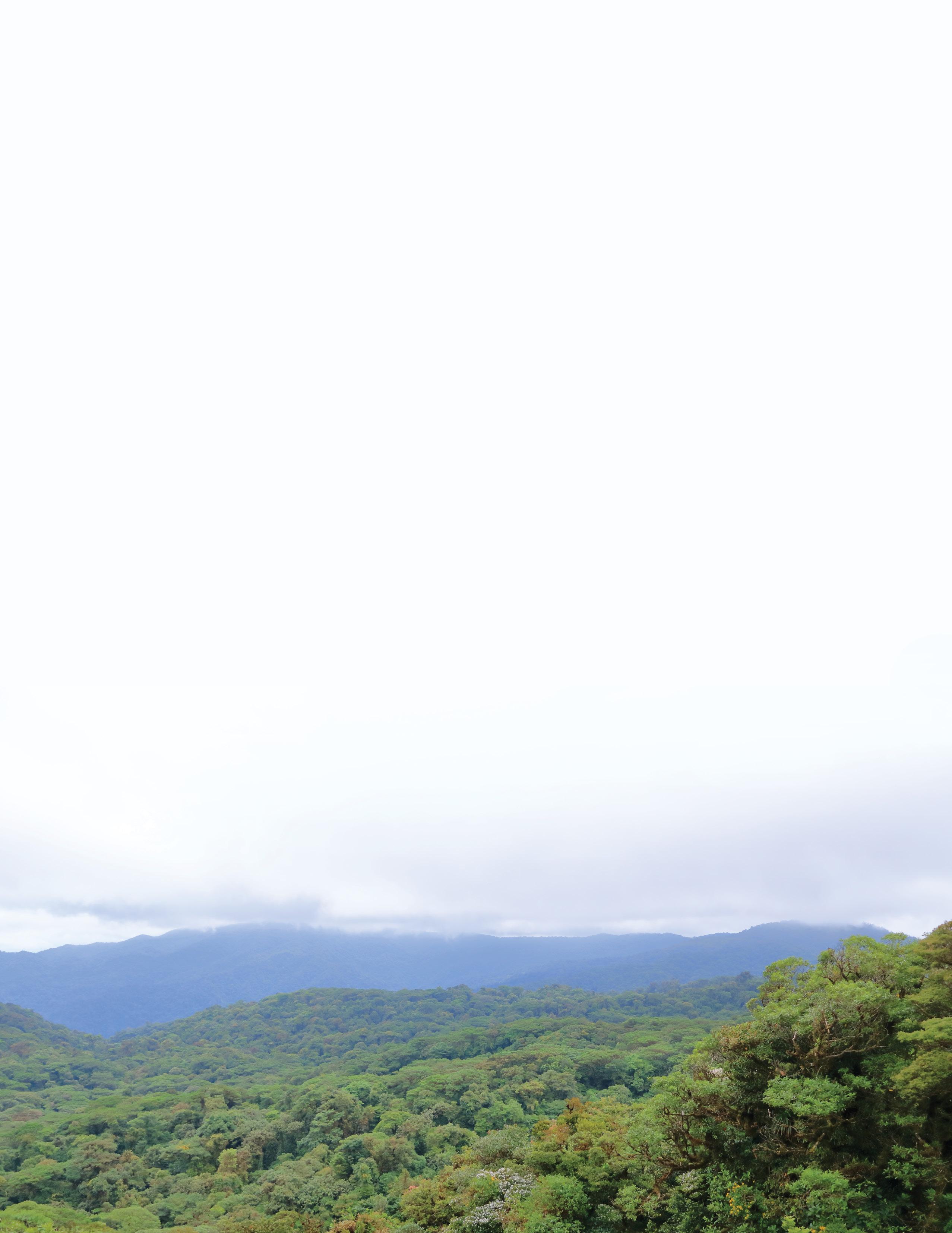
drive the Chapman science professors. For Goldsmith, it all connects back to a New England childhood full of outdoor climbing and curiosity.
Actually, he prefers a different term.
“‘Curiosity’ doesn’t intrinsically connect with me the way ‘exploration’ does,” Goldsmith says. “For me, as an ecologist, it’s always been about this opportunity to get paid to explore – to discover new things.”
In ecology, there’s an emphasis on inventing new ways to answer critical questions, he notes.
“Sometimes that means putting something on a rocket, and sometimes that means shooting a slingshot with a rope attached up through the canopy,” Goldsmith says.
It turns out this is the time to tether leaf-by-leaf insights to data downloaded from space.
“One of the reasons Josh and I work so well is that we come at the same question from two different perspectives,” Goldsmith says. “That not only gives us confidence that we got the right answer, but it also gives depth to the information.”
“From a personal perspective,” Fisher adds, “it makes us bigger than we are as individuals.”
It also gives them a spectacular place for their ideas to meet.
“At the top of the trees,” Fisher says.
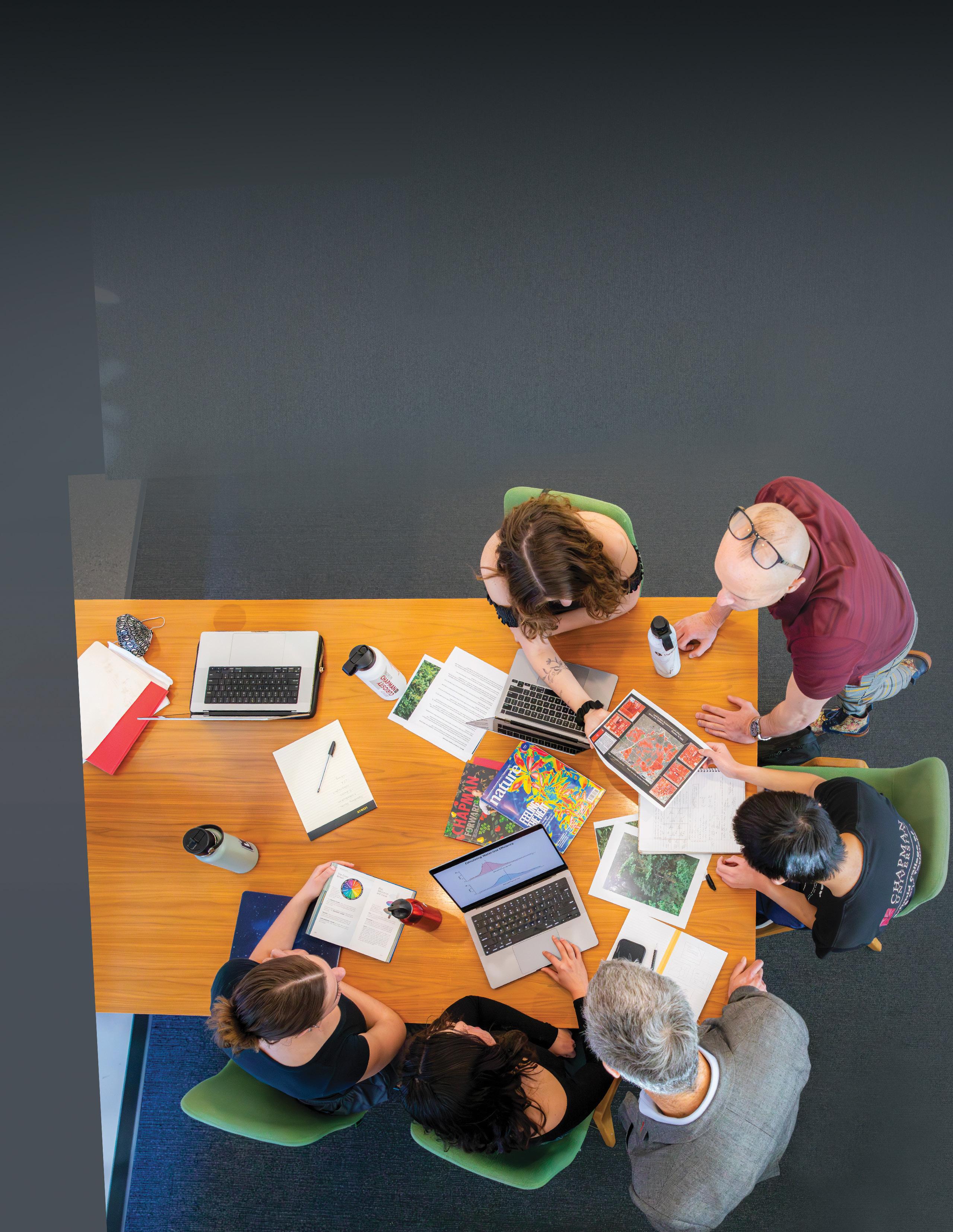 BY DENNIS ARP
BY DENNIS ARP
What begins in Earth orbit is now spurring grassroots response where environmental impact is most acute.
In a Chapman University cross-disciplinary course called “Observing Earth From Above: Using NASA Satellite Data for Real-Time Environmental Monitoring,” professors Gregory Goldsmith and Joshua Fisher help students translate remote-sensing information into community-based change.
“Greg and I had this common vision to do more than just another science project,” Fisher says. “We really wanted to expand this to capture climate disasters as they unfold in real time. There’s a need to keep up with the pace of both climate change and the media cycle.”
The scientists point out that their recent research study of heat-stressed trees in the tropics was three years in development before it was published as a cover story in the high-profile journal Nature.
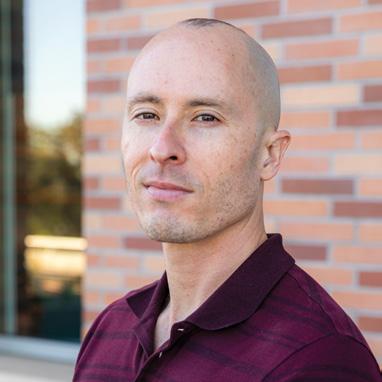
“ TO DO THINGS LIKE CREATE EFFECTIVE CLIMATE POLICY REQUIRES
”
AN INTERDISCIPLINARY TEAM.
— Joshua Fisher“We need it to take three days to get research to the public, not three years,” Goldsmith says.
Fundamental to the course is the professors’ work helping students learn to access and analyze data downloaded from a sophisticated remote-sensing instrument called ECOSTRESS, mounted on the International Space Station. But developing student skills in art, design and persuasive speaking is just as important.
“To do things like create effective climate policy requires an interdisciplinary team,” Fisher says. “We’re writing the recipe book on how to do that. These students are that interdisciplinary team.”
During a recent class session, students representing diverse majors – from engineering to philosophy – pitch their projects to Professor Susan Paterno, director of the journalism program at Chapman, and John Nielsen, a former science correspondent for National Public
SIDEBAR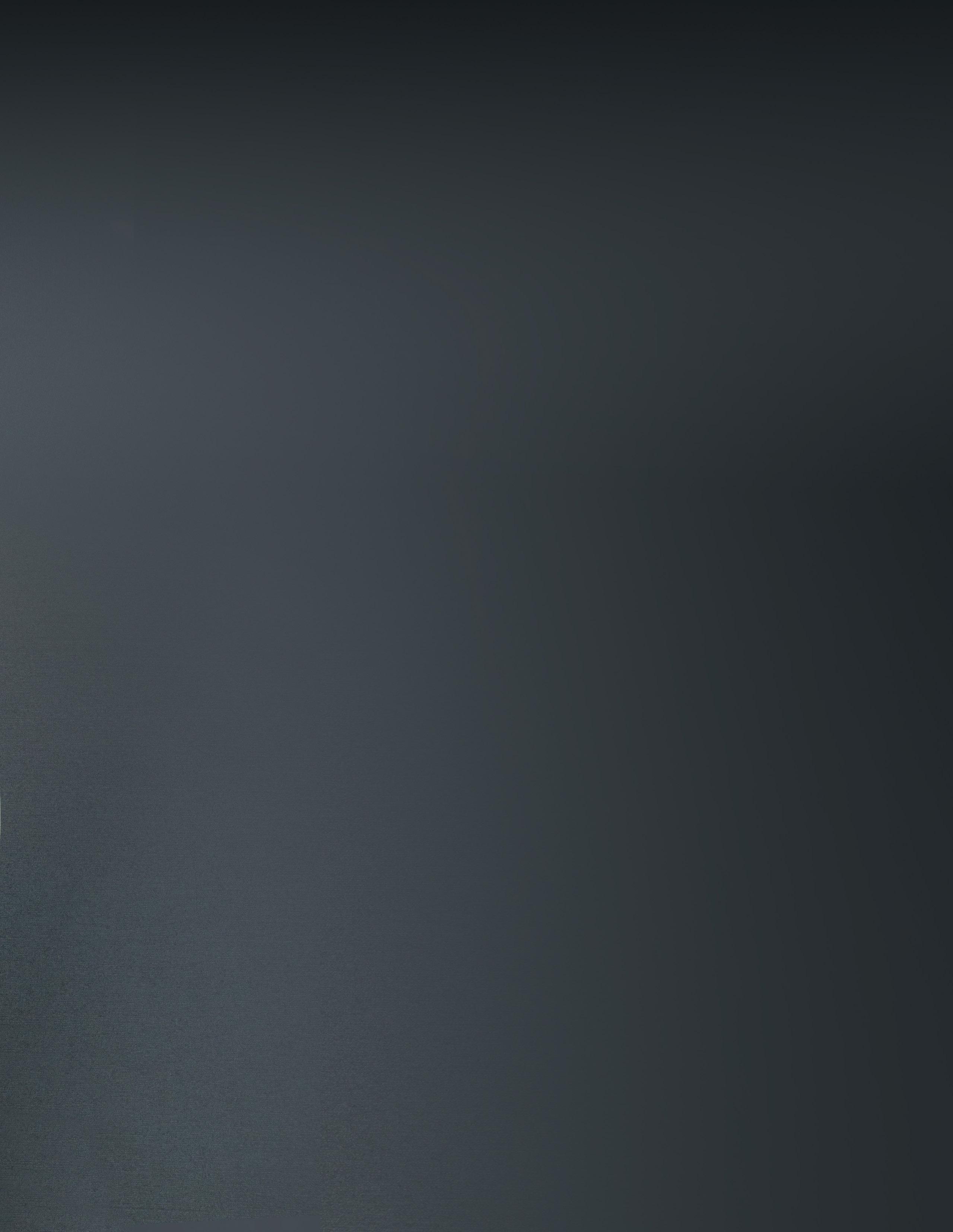
Radio. In previous class sessions, students also gleaned insights from Chapman art professor and information design expert Claudine Jaenichen as well as NASA Jet Propulsion Laboratory data lead Scott Davidoff.
In pitching her data-driven project, first-year student Ashley Agatep ’27 uses artfully displayed temperature maps to show how the Urban Heat Island Effect is impacting residents of Santa Ana, about five miles from the Chapman campus.
“In Southern California, heat is an everyday part of our lives during the day,” says Agatep, an environmental science and policy major. “What if we can’t escape that heat, even at night?”
Agatep’s maps show patches of pink that turn deep red over infrastructure such as parking lots and turf sports fields.
“During the day, these concentrations of asphalt and turf soak up the heat instead of reflecting it back, and then at night they emit that heat into our homes,” she explains. “The chronic heat exposure deeply impacts the lives of residents, with lower-income and minority communities being affected at much higher rates.”
Keila Villegas knows firsthand how urban heat takes a toll. She grew up in Santa Ana and still lives in the densely populated neighborhoods mapped by Agatep.
“I live in an apartment complex with no AC system, and it’s hard to be at your best when you need a fan blasting in your face to stay cool,” says Villegas, water justice director for the Orange County Environmental Justice Educational Fund. “[Keeping cool] becomes somewhat of a marathon when it’s even hot at night.”
After Agatep’s heat presentation during class, Paterno and Nielsen suggest tweaks to her messaging, but they also praise her presentation.
“I want to do this story for Voice of OC right now,” says Paterno, referencing a local news site to which Chapman journalism students contribute stories.
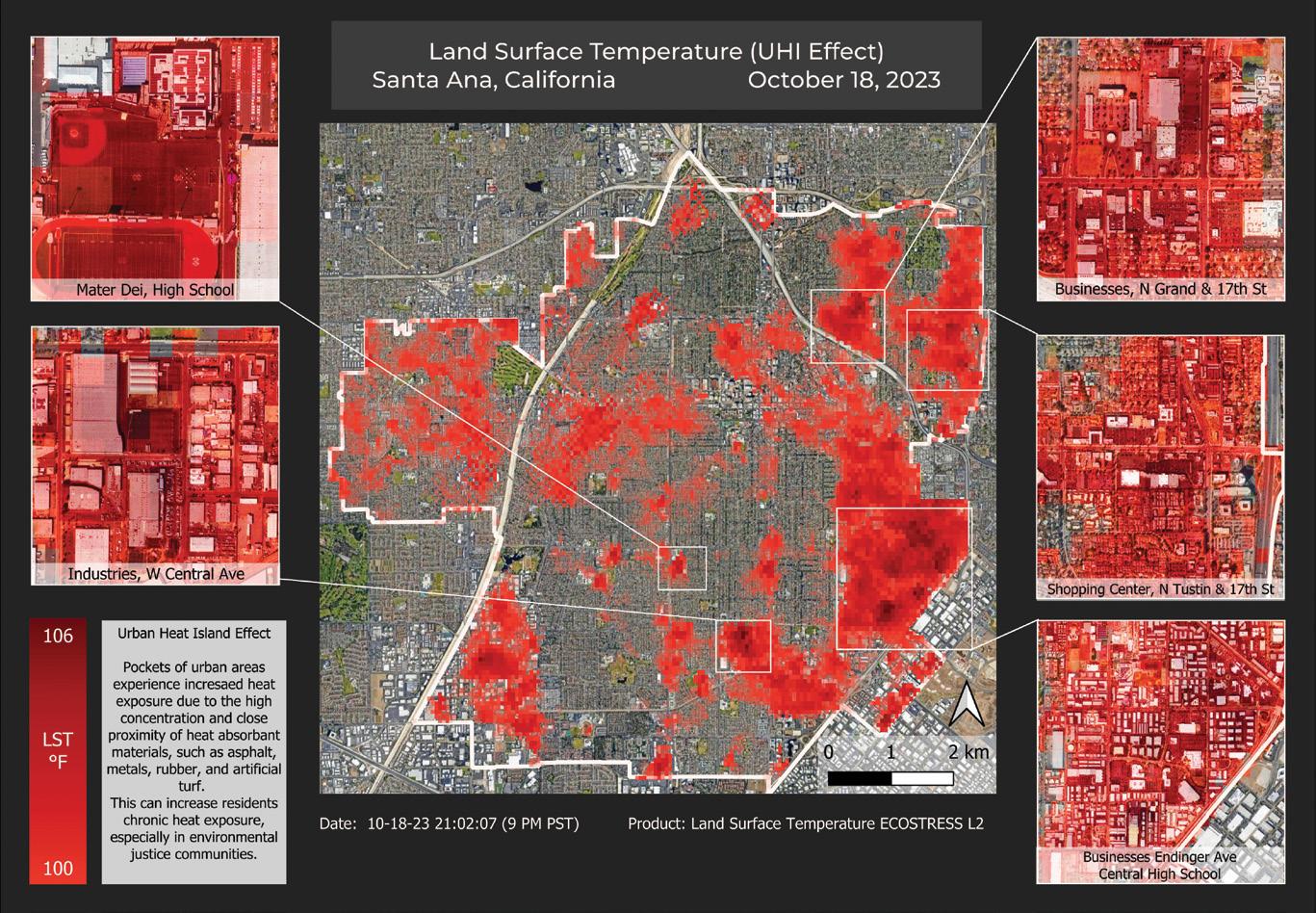
Later, Agatep would say that the pitch experience “taught me how to make my science more effective by communicating it to the public and to policymakers. I see that if I keep working on a project like this, it has the possibility of going out to people in Orange County.”
She’s also excited to get support for her work from the wider research community. Agatep and class colleagues Ruby Baldwin-Smith ’23 and Holland Hatch recently presented their work to NASA researchers at an ECOSTRESS team meeting.
The NASA experience was “nerve wracking,” Agatep admits, but she adds that many attendees approached her afterward to offer ideas for new applications of her research.
“A few months ago, as I was graduating from high school, I would have never thought I would be presenting to a NASA conference or having my work published on their website,” she says.
At the local level, Agatep’s project and others developed in the class also resonate with Maya Cheav ’22, a graduate of Chapman’s Environmental Science and Policy Program, who now is land and health director for Orange County Environmental Justice.
The neighborhood data Agatep collected reminds Cheav of a lead contamination project her team is
working on in Santa Ana. After a local resident brought the problem to light, community partners helped expand the data set to include about 1,500 soil samples, Cheav says.
Along the way, advocates and policymakers learned that the contamination was disproportionately affecting lower-income neighborhoods and people of color.
“A big map showed the concentrations, and the city started listening to residents,” Cheav says. “That’s the power of research to influence policy.”
Back at Chapman, Goldsmith and Fisher are dedicated to seeing their course drive action, not just to address climate change, but to lift underserved communities and underrepresented students. They note that a dozen other universities have committed to creating a course modeled on theirs, and all of those schools are Minority Serving Institutions, including several Historically Black Colleges and Universities.
“The geosciences are the least diverse of all the STEM fields, and we think this project-based learning approach has the potential to improve recruitment and retention of a new generation of diverse geoscientists,” Goldsmith says.
“Many smart people have been working on climate change for a very long time, which begs the question: Where will new and different ideas come from?” Fisher adds. “The answer is from voices that have been historically excluded from participating in STEM.”


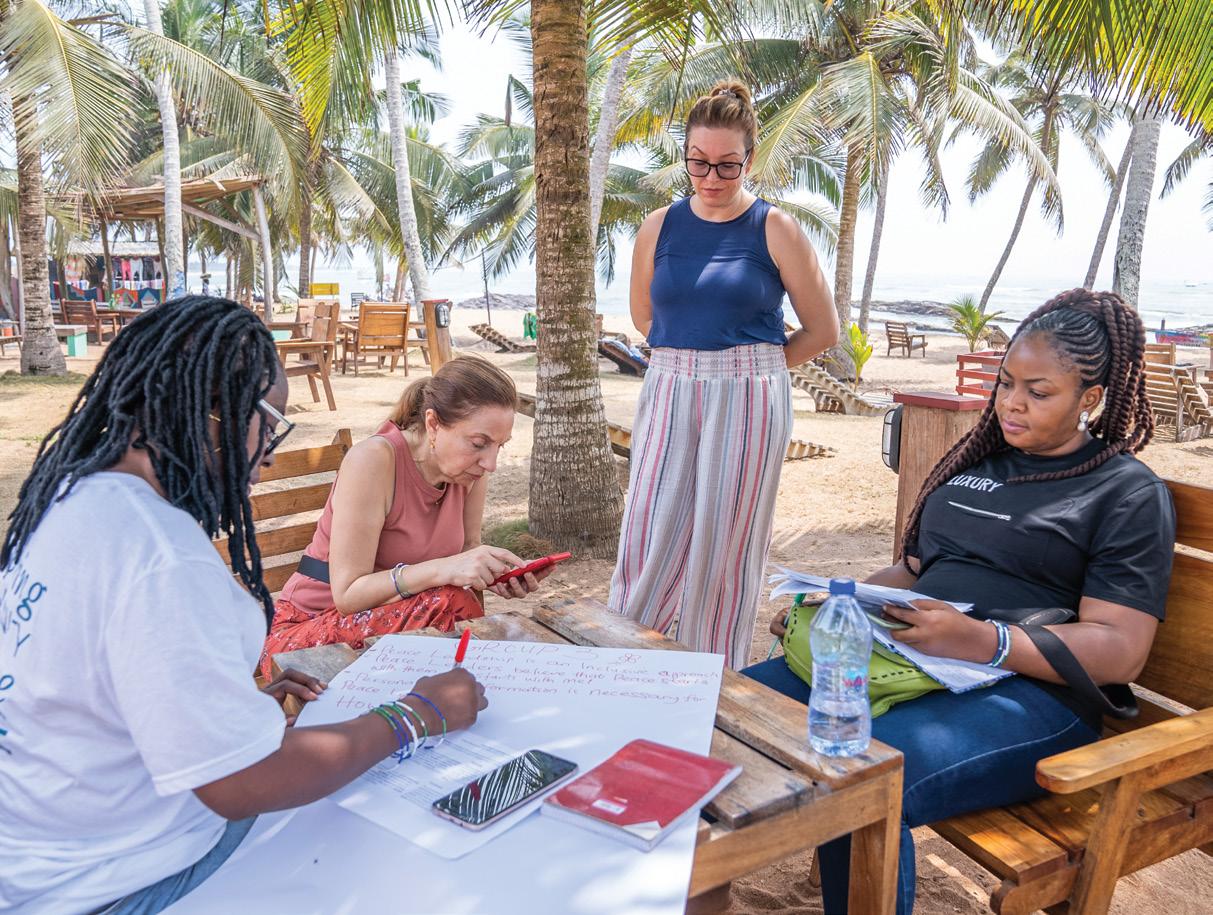
Participants build connections during the inaugural Peace Leadership Forum in Ghana.
McIntyre Miller facilitates peace leadership group work at the inaugural Peace Leadership Forum.
 BY DENNIS ARP
BY DENNIS ARP
All over the globe, changemakers are embracing Whitney McIntyre Miller’s peace leadership model, feeding a global movement for systemic change.
“Visualize Peace,” the bumper sticker proclaims in a font designed to be read at 70 miles per hour. But what good is such a bromide without a blueprint for transforming the sentiment into action?
Enter Whitney McIntyre Miller, a leadership studies professor at Chapman University whose Integral Peace Leadership model is now steering communities toward systemic change in more than 40 countries.
Eight years after introducing her model, McIntyre Miller continues to enhance it through her research and teaching in the Attallah College of Educational Studies at Chapman — one of the few U.S. universities
where programs in leadership studies and peace studies overlap. Along the way, McIntyre Miller has helped take the nascent field of peace leadership from visions and dreams to tangible steps for replacing entrenched systems.
“When I think of peace leadership, I think of intentional practices grounded in research-based work that challenges violence and aggression in whatever forms they take,” McIntyre Miller says. “There’s a need not just to undo systems, but also to build new structures that promote peace, equity and justice.”
She launched the model via a 2015 article co-authored with Zachary Gabriel Green. The authors frame peace leadership as “much more than what Einstein referred to as ‘the mere reduction of violence.’ It requires proactive, intentional practices to shift patterns of thinking, knowing and doing in the face of strongly held beliefs and cherished ways of being.”
McIntyre Miller grounds her research in the work of numerous authors who elucidate the traits and examples of historic peace builders such as Gandhi, King, Lincoln, Mandela and Chile’s Michelle Bachelet. But as she developed her model, she knew it would need to go far beyond a focus on “leadership as person.”
Through research and experience, including fieldwork in places like Sierra Leone and Bosnia-Herzegovina, McIntyre Miller ultimately built her peace leadership model on an integral theory structure called All Quadrants, All Levels, All Lines (AQAL) developed by American philosopher Ken Wilber.
Her model is designed to bring diverse theories and practices into a single framework for peace leadership impact. In essence, the model can inspire something like a peace-building checklist:
Do the inner work so you embody peace in your personal life.
Engage collectively to orient relationships and communities toward peace.
Study theories, behaviors and practices of peace builders to provide evidence of peace in action.
Apply strategies of group engagement to challenge societal structures.
But breakthroughs really become possible when all the elements come together over time to deepen experiences and create enduring connections.
“Each process in peace leadership is part of a nested and interwoven whole,” McIntyre Miller explains in the 2015 paper.
It didn’t take long for leaders and changemakers to embrace the professor’s integrated concepts, starting with Katy Lunardelli and Sylvia Murray of the Euphrates Institute.
“The model felt very true to the practices of our work,” says Lunardelli, executive director of the California-based nonprofit that equips, connects and uplifts emerging peace builders worldwide.
“It all clicked to have this research model that shows how inner work — embodying peace at the individual level — connects with outer work: interactions and relationships in the community,” Lunardelli adds.
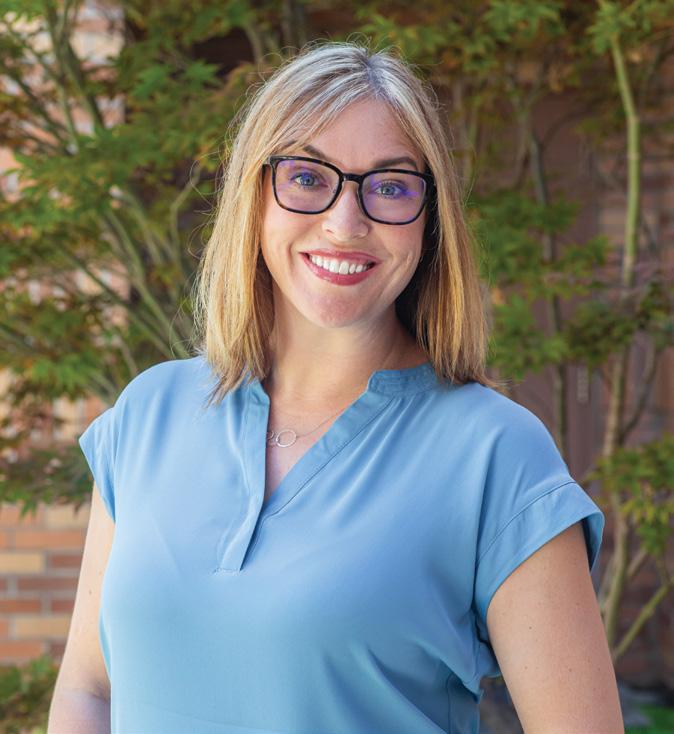
“ THERE’S A NEED NOT JUST TO UNDO SYSTEMS, BUT ALSO TO BUILD NEW STRUCTURES THAT PROMOTE PEACE, EQUITY AND JUSTICE. ”— Whitney McIntyre Miller



The Euphrates Institute adapted McIntyre Miller’s model as it developed its Peace Practice Alliance, a six-month collaborative experience that explores peace leadership theories and practices while cultivating resilient peace-building communities.

More than 100 graduates of the program are now applying what they learned in leading organizations around the world, from California to Cameroon, Liberia to India, Afghanistan to Ukraine.


In Nigeria, trained peace builders are working with young girls who were kidnapped and sexually assaulted during the Boko Haram insurgency. Practices and trainings help victims “find a measure of peace after suffering such a horrible trauma,” McIntyre Miller says. “They’re also doing sensitizing workshops for the community so people learn about what their neighbors have gone through, and so the community itself can experience healing.”
McIntyre Miller and many of those who are putting her insights into practice recently met in Ghana for a Peace Leadership Forum, which featured focus groups, workshops and countless stories of peace-building progress.
Participants present their group peace tree and map during the Peace Leadership Forum.
McIntyre Miller participates in a batik fabric-making workshop in Cape Coast, Ghana.
McIntyre Miller leads a conversation around integral peace leadership during the Peace Leadership Forum.

“We’re seeing what we envisioned, which is a global movement of peace practice that’s growing and evolving,” Murray says. “Whitney’s theories are proving true in practice.”
Impact is being realized across a host of community and business sectors, including education, medicine and engineering. Nongovernmental organizations, churches and other community leaders are creating change in fields such as public health, conflict resolution, domestic violence, trauma healing, climate justice and even youth sports.
“I can’t tell you how humbling and amazing it is that this idea I put on a napkin in 2014 is now being used every day around the world,” McIntyre Miller says.
In Saudi Arabia, Miznah Alomair (Ph.D. ’18) is applying peace practice principles in her leadership role with the Alnahda Society, where she and her 70-plus employees work to empower Saudi women and families to succeed socially and economically.
“The work I’ve been doing with Whitney and my research in peace leadership have changed me as an individual,” says Alomair, who helped create a peace leadership curriculum during her time as McIntyre Miller’s first doctoral student at Chapman.
“I’ve been able to take my sense of empathy to a new level,” Alomair adds. “It’s not that I’m more peaceful; it’s that I have a broader perspective — I look at the wider impact of actions and I’m able to think more systematically about everything. I see how all the lines connect.”
The lessons of peace leadership represent a cultural shift for Alomair’s organization, where the approach of previous leaders was
more pragmatic and transactional rather than based in peace-building principles, she says. Progress is incremental as she helps prepare women to step into roles that used to be unavailable to them.
There’s optimism that succeeding generations will be especially open to change.
“As I connect with the youth, I continue to believe this is the right fit. There are great opportunities to impact societies at different levels and in more powerful ways,” Alomair says.
Cultural transition is also at the heart of the work being done by Nick Irwin (MA ’17, Ph.D. ’24), who includes peace leadership research in his Chapman doctoral dissertation. He’s also a student of the Euphrates Peace Practice Alliance.
Irwin retired in June after 20 years in the Navy, and now he’s applying peace leadership lessons as he works with college students who are military veterans — many of whom struggle to adapt to campus life.
“In the military, things tend to be black and white — us vs. them,” Irwin says.
Peace leadership practices help with self-regulating responses, “so we can manage our stress and respond rationally,” he adds. “Connecting the personal to the interpersonal is all part of building positive peace strategies.”
As a mentee of McIntyre Miller, he has seen the best of peace leadership in action, he says.
“Whitney embodies peace leadership,” Irwin enthuses. “After defending my dissertation proposal, I told her I wanted to take summer school to maximize my veteran's benefits, and she advocated to make that happen. As we say in the Navy, she rogered up, which isn’t a surprise because she’s continuously supportive and is always looking for ways to collaborate.”
“ I LOOK AT THE WIDER IMPACT OF ACTIONS AND I’M ABLE TO THINK MORE SYSTEMATICALLY ABOUT EVERYTHING.”— Miznah Alomair (Ph.D. ‘18)

These days, McIntyre Miller continues to explore opportunities to refine and apply her Integral Peace Leadership model. She and colleagues published four papers on peace leadership in 2022, including one, co-authored by Alomair, for the journal Peace Psychology titled “Understanding Integral Peace Leadership in Practice: Lessons and Learnings From Women PeaceMaker Narratives.”
Another paper, written with researcher Anna Abdou, shares stories of peace leadership growth, training and development in K-12 educational settings. In addition to their research, the authors are working with teachers and administrators to share peace leadership practices and develop curricular materials.
Financial support for this project comes from Attallah College’s Solutions Grants, which support faculty research that addresses a specific local need, as well as from the American Psychological Association’s Peace Psychology Division. In addition, grants from the Miner Anderson Family Foundation support the school training project along with a new Peace Leadership Collaborative, which will bring together a broad range of peace leaders to network and share resources.
Also on the horizon for McIntyre Miller is a book of peace leadership narratives, building on her work during the Ghana conference.
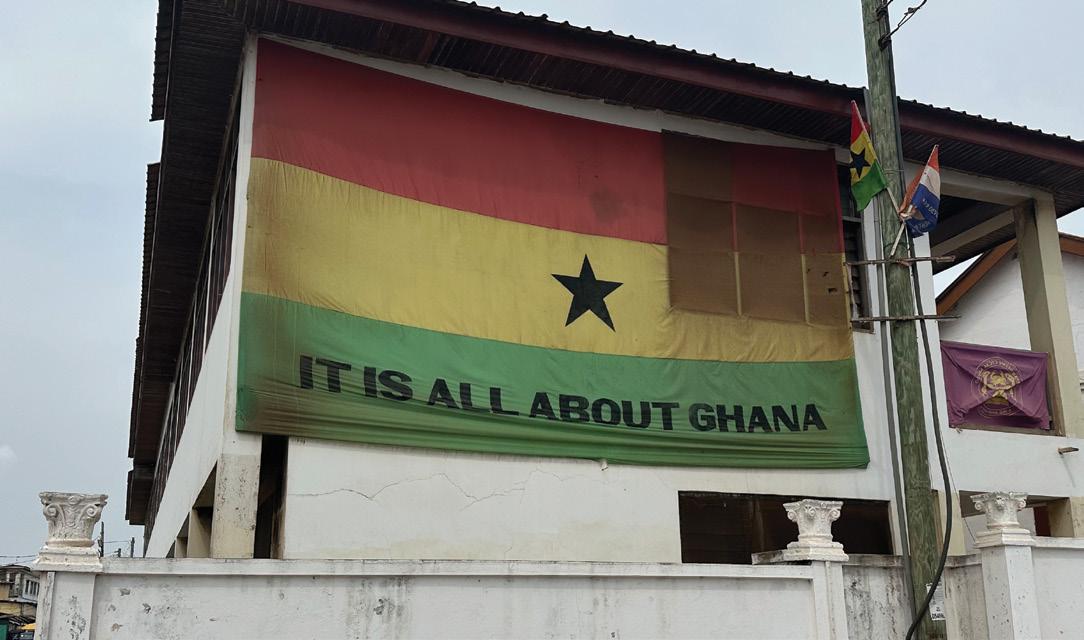
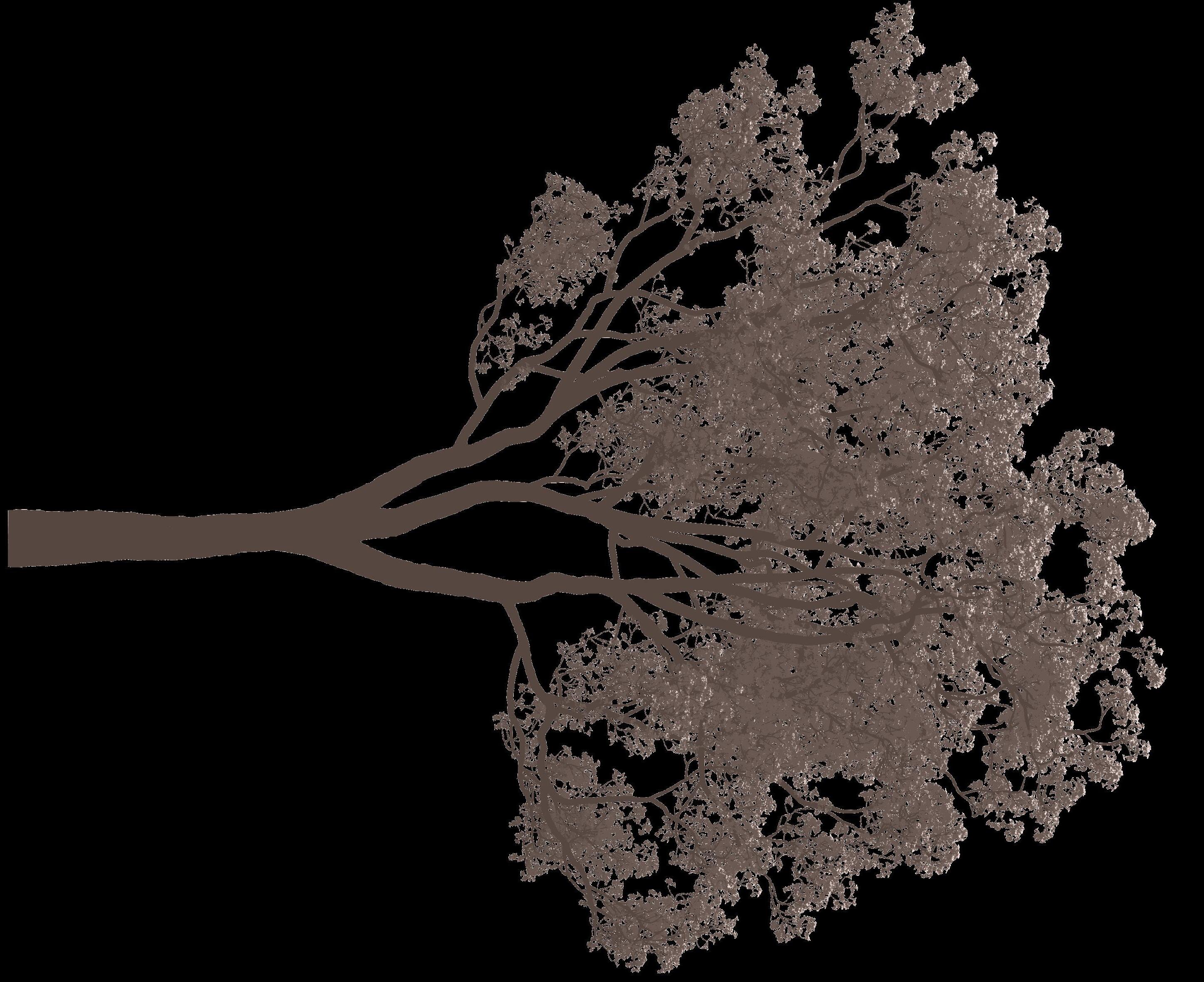
“The plan is that each of these stories will illustrate the Integral Peace Leadership model — how it actually works in practice and what it looks like for people,” she says.
As the seedlings of peace leadership planted by her model continue to propagate, McIntyre Miller also works to root the lessons in her own life.
She loves that the story-gathering and other research she does take her to frontline peace-building communities in Ghana and beyond. But she knows that the work begins in her home and classroom.
“Really, it’s a fairly idealistic, optimistic model, and we acknowledge that it’s hard to do this work — hard to do all the pieces, and especially hard to do all of them well,” she says.
“So I try to use this at an interpersonal level all the way up to how we might implement the Paris Climate Accords so they aren’t just signatures on a document. I want to find a place for it in all of my decision-making — how I spend time in this space to give to the work and to the world.”
A banner hangs from a building in Cape Coast, Ghana.
Participants engage in peace leadership dialogue during the Peace Leadership Forum.
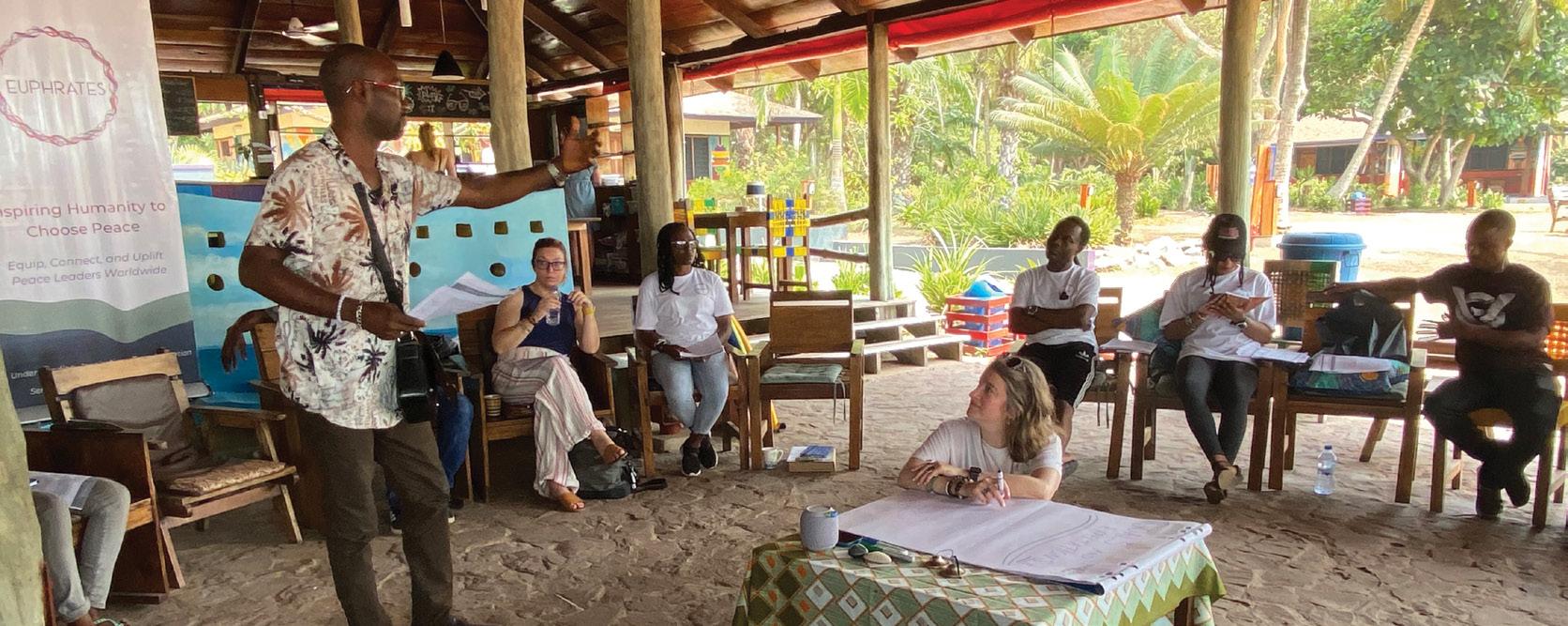
 BY STACE DUMOSKI
BY STACE DUMOSKI
Once an important site in school desegregation, now the building will become the new home of Chapman’s Institute for Quantum Studies.
Last fall, renovations began on the historic Lydia D. Killefer School building, located on Olive Street north of Walnut Avenue in the City of Orange.
Purchased by Chapman University in 2020, the building is set to become the new home of the university’s renowned Institute for Quantum Studies and the state-of-theart Advanced Physics Laboratory – a facility that focuses on nano-scale research using non-chemical-emitting equipment that poses no risk to the neighborhood.
Plans for the renovation, which were approved by the Planning Commision on July 17, will preserve the historic nature of the building, which played a pivotal role in the history of school desegregation in the U.S. and is a nationally registered landmark. The design retains the bones of the building
but reshapes the interior to accommodate research spaces, offices, meeting rooms and community-accessible exhibits.
A new entryway from Olive will lead to the historic lobby, which is being updated for inclusivity and accessibility. The courtyard and outdoor spaces will be enhanced to create community and a semipublic community room will be built. The lobby features an exhibition niche that will pay homage to the history of the building, including the important role it played in school desegregation.
Integration at Killefer School, which is part of the historic Cypress Street Barrio district, occurred in 1944 – three years before the Ninth Circuit Court of Appeals decision in Mendez, et al v. Westminster School District of Orange County that ended segregation in Orange County schools. The case became one of the precedents for the U.S. Supreme Court decision in Brown v. Board of Education of Topeka, which ended the legal right to segregation across the country in 1954.
After desegregation, the building continued to serve as the local elementary school until 1989.
Construction is expected to be completed in late 2024.
Pause for a moment to admire the vibrant flowers of the ruby glow tea tree.
Keep an eye out for pollinators as you pass the hummingbird yucca. Bend to get a closer look at the emerald green leaves of the carpet manzanita.
These verdant opportunities extend throughout Chapman University. And now the experiences are more immersive thanks to signage with QR codes that link to images and information about the drought-tolerant landscaping flourishing all across campus.
Chapman’s new virtual Water-Wise Landscape Tour has an elemental goal –to enrich the Chapman Experience by inviting community members to stop and smell the sage. But there’s another objective as well.
“No matter which side of campus you enter, and no matter where you’re walking on campus, you’re going to see beauty in the fulfillment of the university’s efforts to reduce our use of irrigation water,” said Jenny Kaufman, manager of energy conservation and sustainability at Chapman.
Launch of the Water-Wise Landscape Tour last spring culminated the latest phase of Chapman’s commitment to water conservation. That effort, which began in 2014, includes:
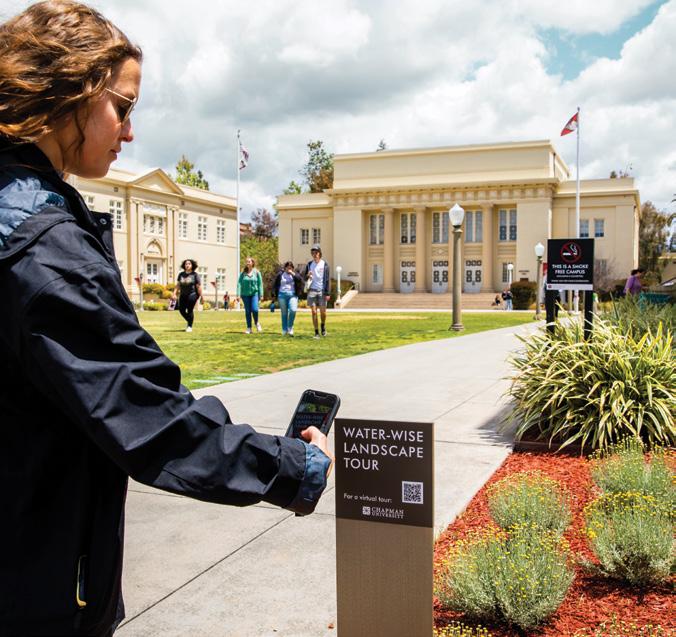
Introducing drip irrigation to non-turf landscape areas.
Retrofitting sprinklers with low-flow nozzles in recreational turf locations.
Adding more than 4,100 square feet of artificial turf to Residence Life areas.
Replacing water-intensive plants with drought-tolerant landscaping throughout the campus.
Educating students and others about opportunities to reduce personal water use.
Over 25,000 square feet of grass on the main campus in Orange has been converted to drought-tolerant landscaping, resulting in an estimated annual water savings of 712,362 gallons.
It’s a moment to relish the progress and to spread the word that adopting a water-wise approach doesn’t have to sacrifice visual or overall sensory appeal, Kaufman said.
“I like that we’re making it a celebration of California-native and droughttolerant plants as we share information that we hope will get people to consider adding them to their own landscapes at home,” she said.
It’s easy to begin the campus landscape tour experience. Just look for signs that read “Water-Wise Landscape Tour” at six locations:
MEMORIAL, BERTEA & MOULTON HALLS
REEVES, SMITH & DEMILLE HALLS
MUSCO CENTER FOR THE ARTS
WALNUT AVENUE & GRAND STREET
WALNUT AVENUE & CENTER STREET
DAVIS APARTMENTS & SANDHU RESIDENCE CENTER
Then use your smartphone and the QR code on the signs to access information about the landscaping near each stop on the tour.
“We’ve gotten great feedback on the cohesive look of the landscapes and the nice diversity of species represented,” Kaufman said. “We think people will also appreciate all the details they’ll find on the virtual tour.”
Kaufman lauded the many contributions of Chapman’s Campus Planning and Design group as well as longtime campus contractor BrightView for realizing the university’s vision for water-wise landscaping.
Going forward, Chapman will continue to identify opportunities to convert landscaping on the Main Campus in Orange as well as at the Rinker Health Science Campus in Irvine, Kaufman added. The university does so even as it recognizes the need to preserve some grassy areas that serve the recreational needs of students.
“I would encourage everyone to take a walk around campus and visit the QR codes to learn about the plants and pollinators they pass every day,” Kaufman said. “I think those who take the tour will appreciate the intentional choices that were made and the intrinsic value that’s been added.”

Frozen shrimp may not be the best bang for your buck, according to a Chapman food science professor.
Ashopper grabbing a bag of frozen shrimp may not think to question the label or weight before tossing the contents into stir fry or shrimp scampi.
Yet, the weight and type of shrimp they buy may not align with what’s on the label.
Associate Professor Rosalee Hellberg and some students found in a new study that more than a third of 106 frozen shrimp samples from Orange County stores were mislabeled and/or weighed less than the packages stated. One fourth of samples were glazed with too much ice, and around a fifth were a different species than labels advertised. Among shrimp in the super/extra colossal size category, half of samples were short-weighted.
“When you combine all the labeling errors, that is a relatively high percentage for seafood products,” says Hellberg, associate director of the food science program at Schmid College of Science and Technology.
“ IT’S HAPPENED WITH THINGS LIKE PUFFERFISH BEING MISLABELED AS MONKFISH, WHERE
PUFFERFISH HAVE A TOXIN — PEOPLE ATE THAT AND GOT SICK FROM THAT. ”— Rosalee Hellberg
Four students — McKenna Rivers (MS ’23), Alexia Campbell ’23 and community college students Chris Haneul Lee and Pragati Kapoor — bought bags of frozen shrimp at grocery stores in Orange County and did lab analysis to determine net weights, ice glaze levels and DNA-based species identifications.
“It’s pretty laborious because you have to remove the ice layer from the shrimp, and you have to weigh it before and after,” Hellberg says. “So [the students got] pretty tired of working with shrimp.”
Although shrimp is the most-consumed seafood in the United States, there’s little research into the extent of short-weighting and mislabeling, according to the study.
Some companies may mislabel imported seafood to avoid anti-dumping taxes or food safety requirements, Hellberg says. Consumers should be concerned about short-weighting and mislabeling of seafood because of health concerns, overpaying and sustainability, she says.
“It’s happened with things like pufferfish being mislabeled as monkfish, where pufferfish have a toxin — people ate that and got sick from that,” she says. “Now obviously,
that’s different from the shrimp scenario. But any time you have mislabeling going on it misleads consumers and regulatory authorities in terms of the possible health risks or health hazards.”
A health risk in shrimp is antibiotic residues from farming, Hellberg says. Additionally, people and companies may unknowingly overpay for shrimp because the processor has added extra ice, increasing weight.
“Another important reason is for consumers to be able to know exactly what they’re purchasing,” she says. “Some types of shrimp are more sustainably harvested compared to others. And so consumers interested in purchasing sustainable options are being misled if the seafood is mislabeled.”
Shrimp species names can be confusing, and companies are supposed to stay within labeling guidelines. One of the most
common types, whiteleg shrimp, is often wrongly labeled as another species, white shrimp, Hellberg says.
“They sound very similar but they’re actually quite different,” she says. “White shrimp is one of the main species in wild-caught fisheries in the U.S. Whiteleg shrimp is commonly farmed and imported … it’s misleading to consumers.”
Hellberg recommends training and outreach about proper labeling and more research worldwide into overglazing, shortweighting and mislabeling the country’s most popular seafood. She shared her results with NOAA Fisheries, the USDA and the FDA and says the FDA is looking into increasing surveillance efforts for frozen shrimp.
The shrimp study is just Hellberg’s latest dive into seafood. She’s finishing a study on canned tuna and published a study on short-weighting of frozen fish a few years ago. Last year, she published a paper about the prevalence of mislabeling ready-to-eat raw seafood — poke, sushi and ceviche. Her students went to restaurants around Orange County.
“Some ceviche products we bought that were supposed to be fish actually had shrimp. So that would be a concern with allergies,” Hellberg says.
She says she doesn’t have another shrimp study planned, but other types of shellfish may be next on the research menu.

On the 25th anniversary of Chapman University’s Holocaust Art and Writing Contest, organizers and participants reflect upon its impact and ongoing importance in confronting antisemitism.
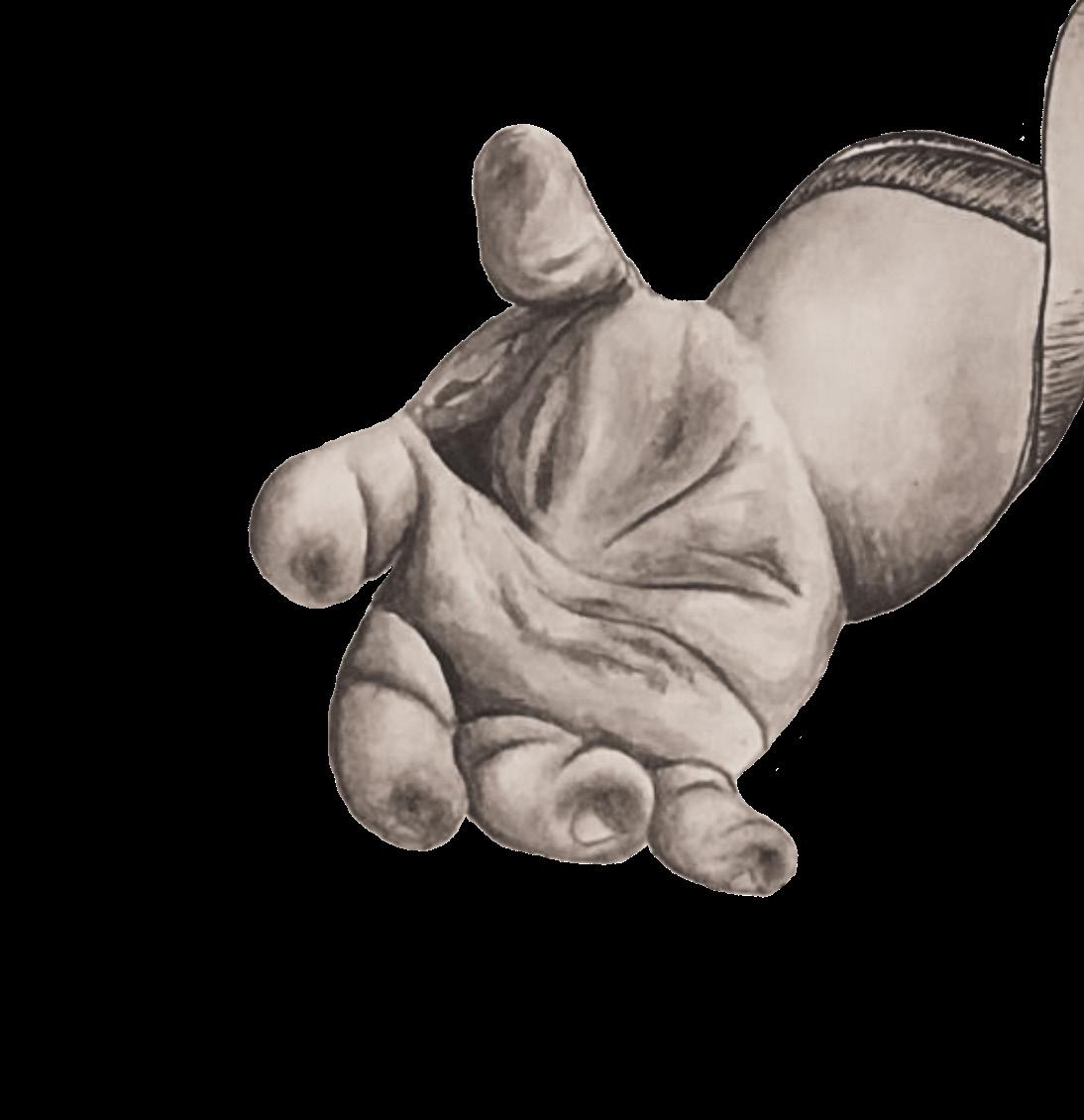 BY STACE DUMOSKI
BY STACE DUMOSKI
In 2019, Abigail Stephens ’26 was a first-year student at Canyon High School in Anaheim, Calif., when her poem, “My Enemy, My Friend,” won first place in Chapman University’s Holocaust Art and Writing Contest. This year, Stephens — who is now a history major at Chapman — will serve as a judge for the contest’s 25th anniversary.
For Stephens, the highlight of the whole experience is the opportunity to interact with Holocaust survivors and educators. Those conversations have helped her to see survivors not just as statistics or as their stories of trauma, but as people who have built fully-rounded lives post-tragedy.
“I could really sit down and talk to them about what they’re doing now,” she said. “Talk about what they like to do. I talked with one of the survivors about how we both swam every day, and I was talking to another woman … about how she hates salad …That’s one of the first things I learned. These people are humans, and not just a story.”

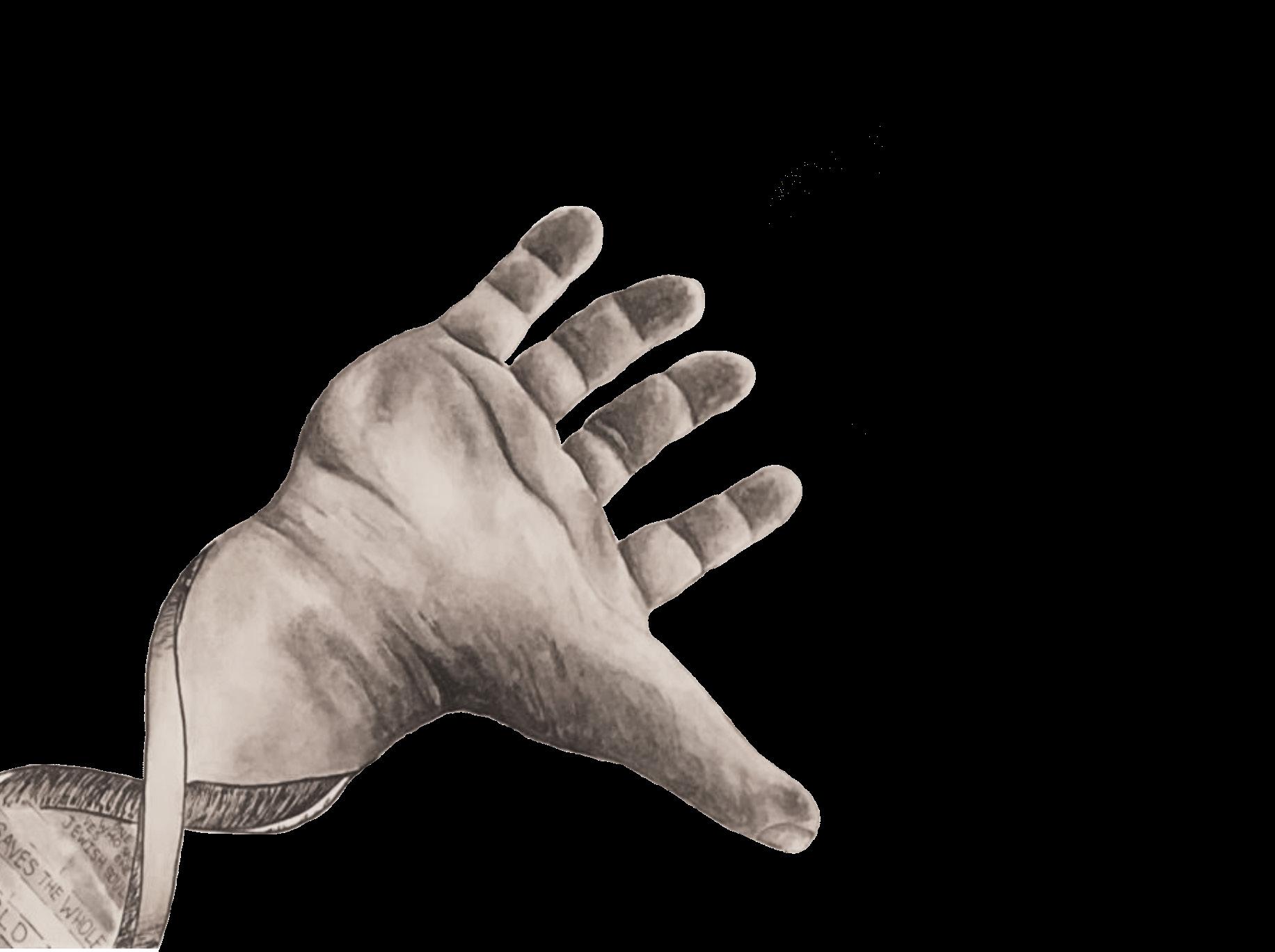
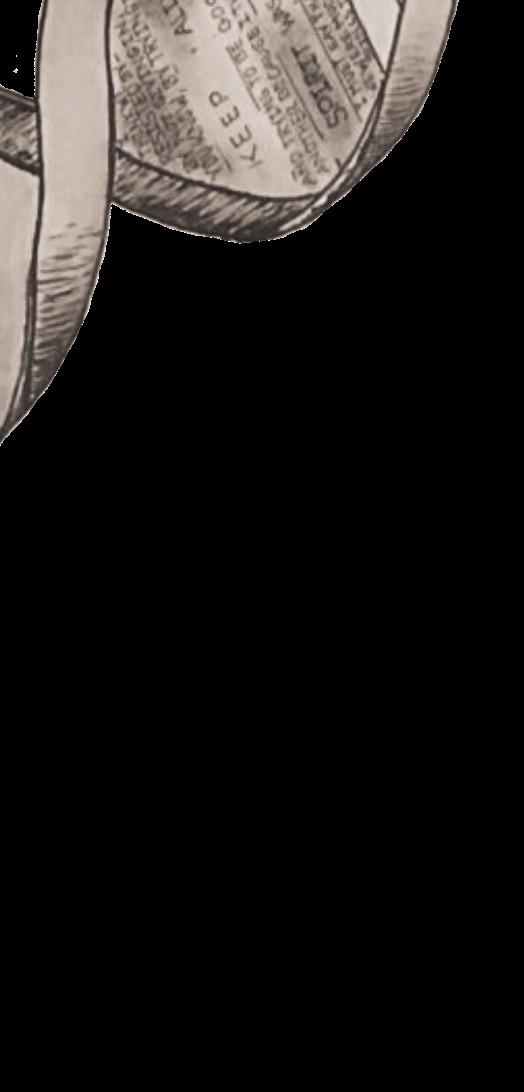
The facts about the Holocaust are easy to find: Between 1941 and 1945, the Nazi government systematically murdered 6 million Jewish people from across German-occupied Europe.
But for 21st century students, even the most basic facts can be opaque. Currently, only 25 U.S. states and nine countries worldwide require Holocaust education, and as many as 6 out of 10 Americans under 30 cannot accurately identify how many Jews were killed in the Holocaust.
At the same time, incidents of antisemitism in the U.S. have risen 428% over the last 10 years, according to the AntiDefamation League’s Center for Antisemitism Research (CAR). Jewish people represent less than 2% of the U.S. population, but 60% of the faith-oriented hate crimes target Jewish communities. The CAR research suggests a direct relationship between the lack of Holocaust education and the increase in prejudicial, antisemitic beliefs.
For Holocaust Art and Writing Contest organizers Marilyn Harran and Jessica MyLymuk, those current realities are just as important as the history they study. They also know that the facts alone are not enough to convey the lived experiences of those who endured this history, nor can they inspire the personal connections that are essential to answering the call, “never again.”
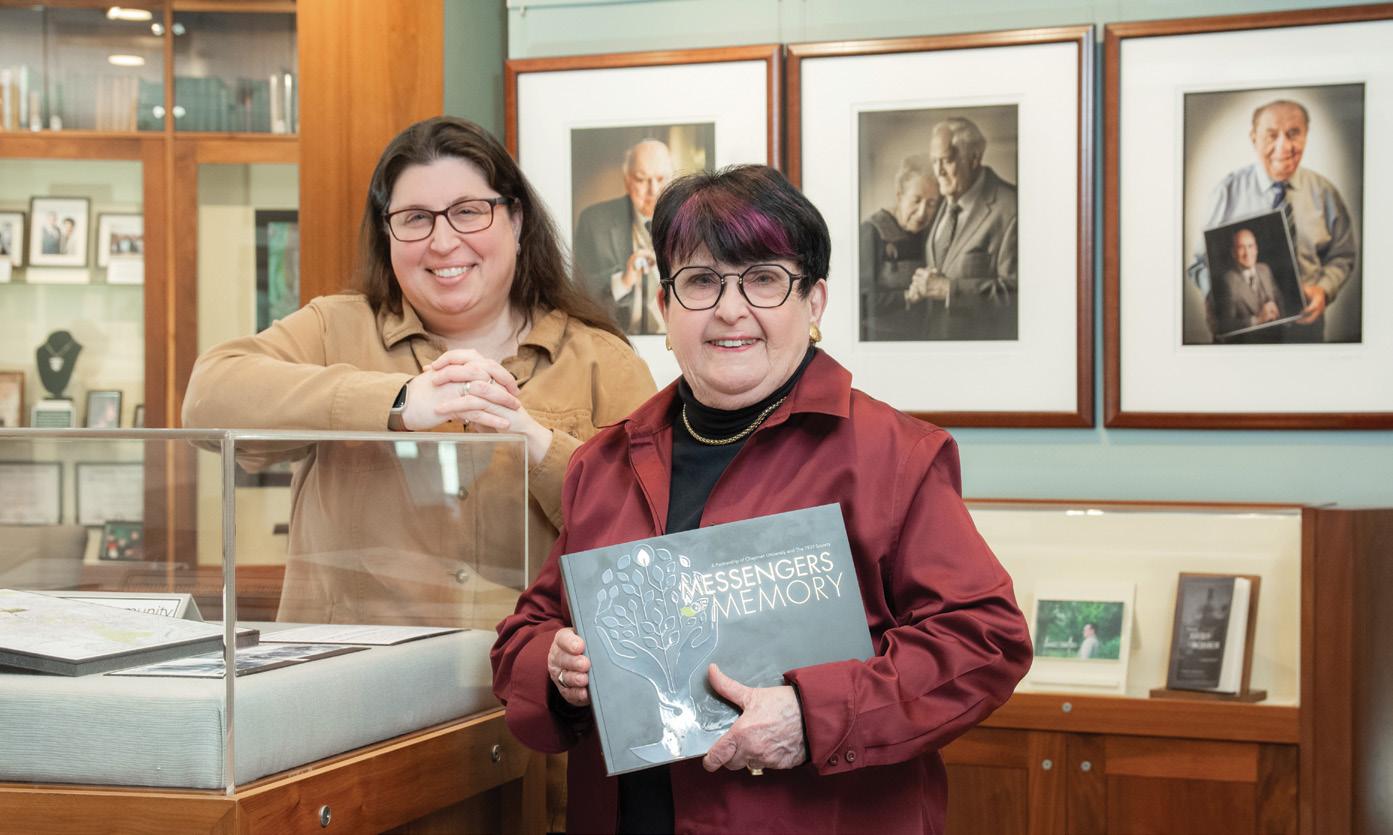
Co-sponsored by The 1939 Society and supported by the Samueli Foundation and Dana and Yossie Hollander, the contest has welcomed some 150,000 middle school and high school participants from Orange County, across the country and around the world. Students are asked to watch testimonies recorded by Holocaust survivors or rescuers and respond through their own creative work – essays, poems, visual artwork and film. Representatives from each school, along with their teachers, attend the awards ceremony and reception where students and survivors meet. Winners also participate in a four-day summer study trip to visit the Holocaust Museum LA, the Japanese American National Museum and other sites in Los Angeles, as well as to meet with members of The 1939 Society, a community of Holocaust survivors, descendants and friends.
“We have always sought in diverse ways to build a connection between students and the survivor,” says Harran, who is the

founding director of Chapman’s Rodgers Center for Holocaust History and holds the Stern Chair in Holocaust Education in Wilkinson College of Arts, Humanities, and Social Sciences.
The commitment to ask students to view a full-length survivor testimony in order to get a sense of what their life was like before and after dates back to the contest’s earliest days.
“There is some criticism about Holocaust education and how it does or does not address concerns about antisemitism,” says MyLymuk, associate director of the Rodgers Center. “One of the criticisms is that it paints survivors as victims. That we are so entrenched in their tragedy that we don’t see them as whole people. If you don’t know what their lives were like, you don’t know what they lost. You also just don’t see them as anything beyond what their trauma is.”
The opportunity to engage with survivors as individuals and not just statistics is the first step in building empathy, and showing students that Jewish lives are not so different.

Artwork on opposite page:
The Creation of Connection
2019 First-Place Winner
Amanda Harris, Grade 11
Trabuco Hills High School, Mission Viejo, Calif.
Teacher: Jeb Berry
Testimony: Ludmila Page
Jessica MyLymuk and Marilyn Harran in the Sala and Aron Samueli Holocaust Memorial Library.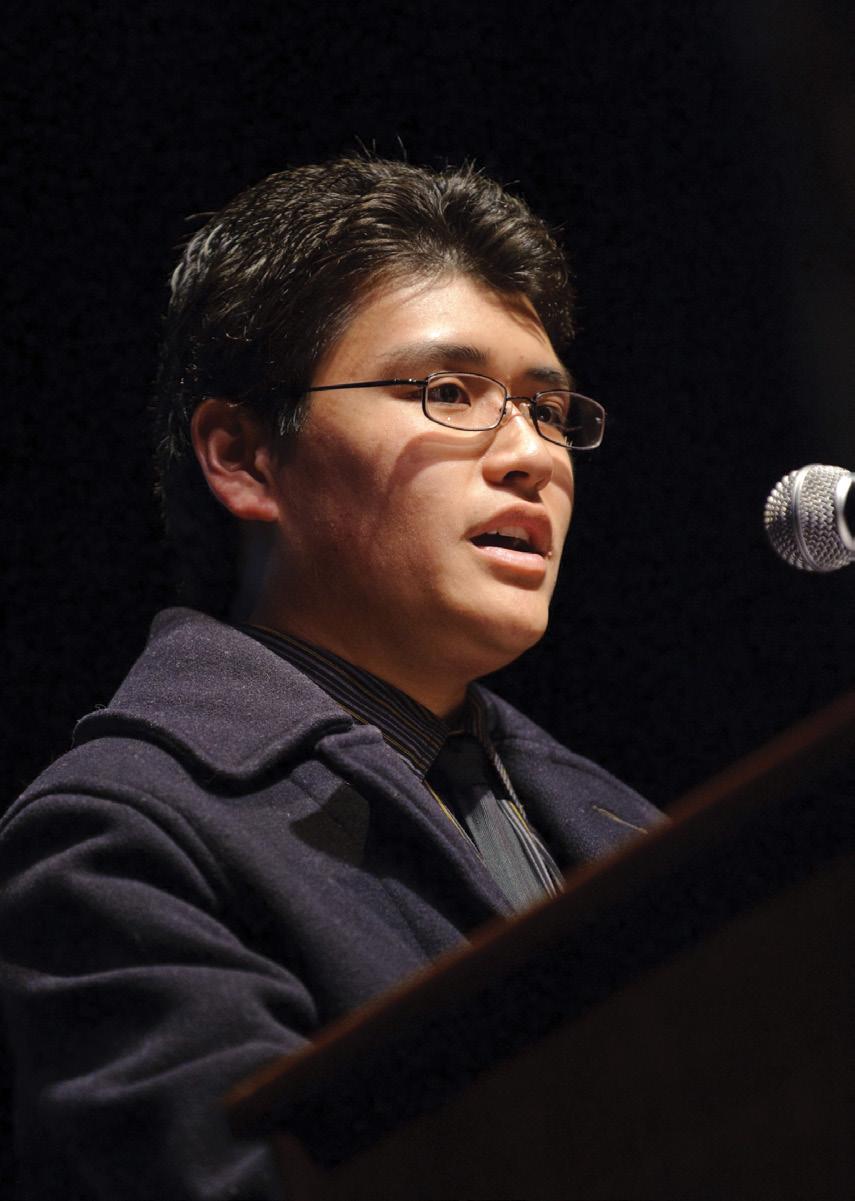

For Mindi Seigler (MAT ’09, Ph.D. ’16), a 9th grade English teacher and Chapman alumna, the contest has become a core facet of her curriculum not just in her own classes, but through every grade level at Hawthorne Math and Science Academy in Hawthorne, Calif.
“Some of the students go really deep and they get really personal,” says Seigler, discussing her students’ experiences. “This becomes for them not just a contest to win … they really want to do their best because they take pride in knowing that if the survivor was alive in front of them, they would want to be able to reflect back to the survivor, ‘Your story meant something to me, and now that I know your story, I can’t unknow it.’”
The need to create empathy across time and generations lies at the heart of the contest’s purpose.
“There are so many different people who are touched by this contest,” says Stephens. “It builds empathy in students. Because sometimes I think high school students are [very] unempathetic, like little kids. And we need to fix that.”
While the experience can be impactful for students, it is just as meaningful to survivors.
“There have been some dry spells, I think, when sometimes it might have felt as though people weren’t listening anymore,” says MyLymuk. “And then you come to an event where you’ve got a thousand people in a room celebrating the fact that they have listened to these stories and celebrating and

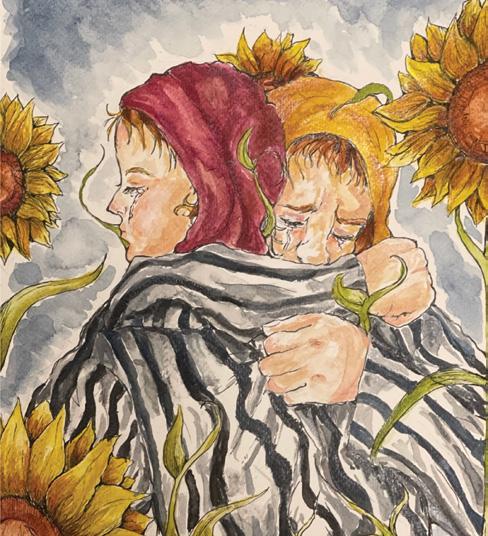
honoring the survivors as well. We could see their spirits lift. It meant the world to them to be able to come in and be with the students, to hear what they had to say and know that they’d been heard as well.”
This generation of students will be the last
“ WE NOW MUST ALL WORK HARDER TO TEACH AND LEARN THE LESSONS OF THE HOLOCAUST, SO IT NEVER HAPPENS AGAIN.”— William Elperin
to meet a Holocaust Survivor in person — a fact pointed out by William Elperin, president of The 1939 Society, when he first proposed the contest to Harran 25 years ago.
“The contest spreads awareness of survivors’ stories, teaches us the lessons of the Holocaust and creates links between survivors and future generations,” Elperin said. “We now must all work harder to teach and learn the lessons of the Holocaust, so it never happens again.”
The 25th Anniversary Holocaust Art and Writing Contest Awards will be presented at Chapman University on March 15, 2024. For more information, visit chapman.edu/holocaust-arts-contest


Testimony:
Beechwood
Teacher:
Testimony: Jadzia Stern
Case Takata in the peacoat his grandmother was given when she was incarcerated in a U.S. Japanese internment camp during World War II. In his 2010 essay, Takata drew a powerful connection between his grandmother and survivor Leon Leyson. Solace in Reprieve Second-Place Winner 2023 Yewon (Violet) Woo, Grade 10 Crean Lutheran High School, Irvine, Calif. Teacher: Sherrie Lah Rosette Fischer Humanity First-Place Winner 2018 Kristen Landsman, Grade 12 Delone Catholic High School, McSherrytown, Pa. Teacher: Jessica Reed Testimony: Natan Gipsman Holding on to Hope First-Place Winner 2023 Sophie Shinmei, Grade 8 School, Fullerton, Calif. Marisa SonnyPoem
First-Place Winner 2019
“My Enemy, My Friend”
Abigail Stephens, Grade 9
Canyon High School, Anaheim, Calif.
Teacher: Tannis Deloyola
Testimony: Nathan Offen


German soldiers turned stalagmites, legs frozen stiff
Rigid from waiting on the Russian front, like dominoes, begging to be knocked over
You were to carry those icicle soldiers down from the train, down the stairs
You were their pack mule, giving Nazi snowmen piggyback rides
Those men were cinder blocks on your body
Your rib-showing body, your fragile-as-a-house-of-cards body
Your months and months in the Kraków Ghetto body
And the soldiers were the ones needing immediate care?
The one you carried, the young SS man, the blonde-haired blue-eyed ice cube
He had said the most terrible thing to you, how clearly do you remember it?
How he didn’t spout slurs or ooze disgust, how he had no hostility
No, the most terrible thing he did that day was call you his friend
He looked at you, a slave to his people, and called you a friend
He was fighting a war for the right to exterminate your race and he called you a friend
Your blood boiled so sweltering, your skin began to burn
He suffered when you made his frozen legs hit the stairs, every single step down
Did he then realize that he could see true suffering if he had looked at the man who carried him?
But that’s not why you tell this story, is it?
You don’t want us to harm those who’ve treated us with hatred
No, you want us to know how you sobbed after you put him down
How you regretted every time he screamed in pain--because of you
You had realized that if you hurt your enemy, you became just like him
Is that why you tell your story?
And today we ask that question, the same one that you’ve been asked a million times
How did you learn to love your neighbor, Mr Offen, when he wrung you out and left you to die?
Well, many years ago, you answered like this:
“Hate in itself is self-destruction, it ties a noose around your neck”
And if I want to take action, if I’ve truly learned from you
When faced with opposition, I will respond with poise and respect
Even though it may seem impossible, when so many are bound by their rage
I can accomplish more with an ounce of compassion than I can with an ocean of hate
Because if we continue to weaponize hatred and solve our conflicts with war
It’s like setting the world on fire and expecting ourselves not to burn

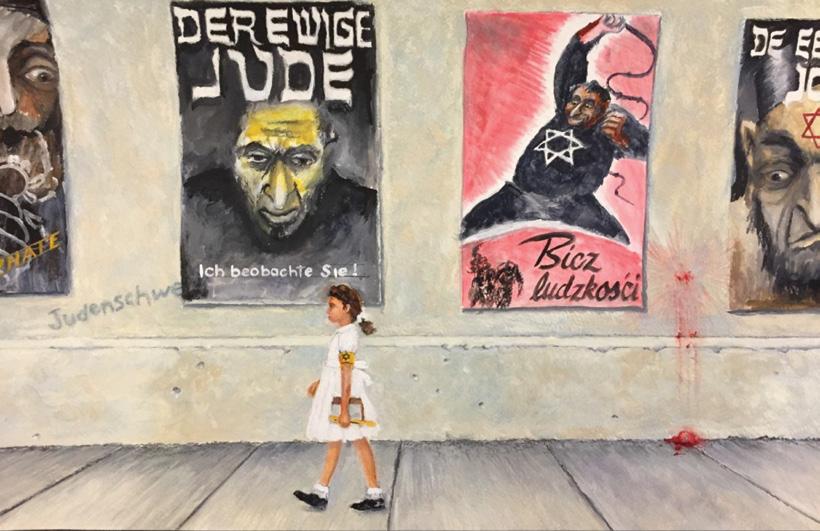
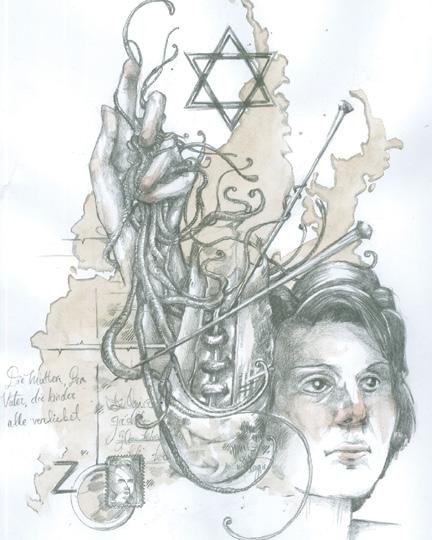

Teacher:
Testimony: Gloria Ungar
Acaciawood
Teacher: Diane Owen
Testimony: Hilde Scheraga
Aeryn
Sentinel
Teacher: Tammi Allison
Tesmony: Sally Roisman
Devoted First-Place Winner 2023 McCallie, Grade 9 High School, Missoula, Mont. Divided First-Place Winner 2020 Rachel Brinkman, Grade 11 Trabuco Hills High School, Mission Viejo, Calif. Jeb Berry The “Writing On The Wall” First-Place Winner 2015 Joshua Sands, Grade 10 College Preparatory Academy, Anaheim, Calif.
Paul Folino, a prolific Chapman University supporter and Orange County entrepreneur and philanthropist, passed away Oct. 14, 2023. He was 75.
“Mr. Folino’s contributions have left an indelible mark on our institution, most notably through his generous support of the Folino Theater, which has enriched the lives of countless students, faculty and community members,” Chapman President Daniele C. Struppa said.
As a member of the original Xerox Corporation team, Folino contributed to the launch of Ethernet networking products in the 1970s. He was president and chief operating officer of Thomas-Conrad Corporation and then president and CEO of tech company Emulex, which he led to becoming Orange County’s topperforming public stock in the 1990s.
Folino was named Orange County Co-Entrepreneur of the Year in technology in 1999 and Orange County Director of the Year for high-growth technology in 2000. In 2006, the Los Angeles Times honored him as “one of the top 100 most influential” people in Southern
California. He served on the boards of the Orange County Performing Arts Center, Orange County High School of the Arts, Commercial Bank of California and Microsemi Corporation.
The Folino Theater, a cornerstone of Chapman’s No. 4-ranked Dodge College of Film and Media Arts, opened in August 2006 as part of Marion Knott Studios.
Equipped with state-of-the-art Kinoton 35mm projectors, a Barco 2K digital projector and Dolby Digital surround sound, the Folino Theater has been the backdrop for student, classic and foreign film screenings. Many actors, directors and filmmakers have shared their insights and experiences with Chapman students in the theater during master classes and other events.
“Paul Folino was a man of boundless generosity, not just to Dodge College but to many other institutions too. He was truly foundational to the creation of our film school,” said Dodge College Dean Stephen Galloway. “I’m so glad his name will live on in our gorgeous theater.”
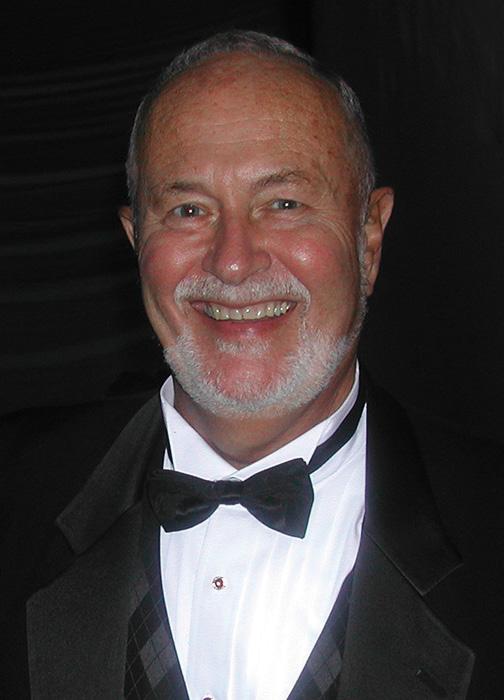
Longtime faculty member William D. Hall, founding dean of Chapman University’s College of Performing Arts (CoPA) and founding dean and artistic director of Musco Center for the Arts, passed away Oct. 7, 2023. He was 89.
Hall worked at Chapman almost 60 years, from 1963 to 2021. Under his leadership, the Department of Music became the School of Music, then the Hall-Musco Conservatory of Music, and subsequently merged with dance and theatre to become CoPA.
“Bill was a unique academic leader: a visionary with bold ideas,” CoPA Dean Giulio Ongaro said. “What he envisioned and realized should have been unattainable – this was true both in the pursuit of academic and artistic excellence as well as in his ability to convince donors to contribute to his vision. He was a true force of nature in the service of the performing arts which he so loved.”
Hall oversaw accreditation of the performing arts programs, the hiring and tenuring of many current faculty and the 2003 opening of Oliphant Hall, which houses the music program. He helped design Musco Center for the Arts, which opened in 2016.
“Bill was instrumental in working with Yasuhisa Toyota of Nagata Acoustics to provide the superior acoustics in the Musco Center,” said Marybelle Musco, the center’s co-
founding benefactor and member of the Chapman board. “His legacy as a musician, professor, dean of CoPA, dean of the Musco Center, his former William Hall Chorale and Orchestra and dean of the Hall-Musco Conservatory of Music are hallmarks of an arts genius.”
Hall, the first professor to hold the Bertea Family Endowed Chair in Music, oversaw great growth in student numbers and quality in the then-School of Music and tours in the western United States and abroad.
In 1963, Hall organized the first Wassail holiday music program, which became a Chapman tradition for decades. He was a longtime conductor of Chapman Celebrates, which brought in over $40 million for students in its 40-year run.
“William Hall’s influence on music at Chapman was so great that it is fitting our music program bears his name: the Hall-Musco Conservatory of Music,” said music chair Amy Graziano. “He was a master teacher who made learning the greatest adventure and inspired generations of students with a love for and dedication to music. Those students went on to perform nationally and internationally and to be teachers themselves.”
With contributions from CoPA Associate Dean Louise Thomas.

Former Chapman University
Director of Athletics David Currey, the architect of modern Chapman athletics and a beloved campus figure, passed away July 15 following an illness. He was 80.
Currey oversaw Chapman athletics for 25 years after coaching Division I football, including Rose Bowl appearances with Stanford. He helmed Chapman’s transition from Division II to Division III athletics, which led to the university entering the prestigious Southern California Intercollegiate Athletic Conference (SCIAC).
Currey said at his retirement in 2015 that the last 25 of his 50-plus years of coaching and teaching “is what I think of as maybe the best of my life, because at Chapman I found a family that accepted me and made me feel a part of them. So many wonderful things have happened to us in the intercollegiate world.”
After coaching at Stanford, UCLA, Long Beach State and the University of Cincinnati, Currey came to Chapman in 1990 “to see if I could stay away from football.”
When then-President Jim Doti asked what he thought of starting a football team, Currey told him he was crazy. Chapman hadn’t had a team in more than 60 years, and local universities were eliminating the sport.
“Of course we laughed, and set out to do it,” Currey said.
Doti called Currey his “Rock of Gibraltar” during tough meetings during the controversial division transition.
“To be there alone would have been really difficult, but having Dave at my side made it bearable,” Doti said.
Under Currey’s leadership, Chapman went from being a Division II program, “losing most of the time, with mediocre facilities and only 150 students participating, to what I think is now one of the leading Division III programs in the nation, with more than 500 students participating, and state-of-the-art facilities,” Doti said.
Current Director of Athletics Terry Boesel said Currey is synonymous with Chapman athletics.
“Coach Currey’s fingerprints are on every single aspect of our Athletics Department and will be for many years to come,” he said.
Former women’s basketball coach Mary Hagarty said at Currey’s retirement that an athletic director might develop new facilities or enter or transition into an athletic conference “but Dave’s done all those things, and stood like a rock.”
Currey built relationships with student-athletes and coaches.
“He stayed connected and engaged in conversation with students and alumni throughout the years,” said Chapman President Daniele C. Struppa. “Thousands of Chapman alumni remember great days on the field, court, track, course and on and in the water because of his vision and passion.”
Currey hired and worked with some of Chapman’s longest-tenured coaches, including women’s volleyball coach Mary Cahill, men’s basketball
coach Mike Bokosky, softball coach Janet Lloyd, men’s soccer coach Eddie Carrillo, and tennis coach Will Marino, all of whom have been in their positions for more than 20 years. On Currey’s watch, 15 received regional coach of the year honors from their respective governing organizations.
Head football coach Bob Owens took morning walks with Currey.
“Sometimes those were walks of a thousand questions, and he was always kind enough to respond in a way that allowed me to reflect, or be challenged, by the situation I was dealing with,” Owens said at Currey’s retirement. “How good is that? It was an opportunity for me to grow as a head coach under his tutelage.”
Struppa said Currey was known for being kindhearted, funny, honest and “famously frugal.”
Former associate athletic director and coach Penny Brush told the story at Currey’s retirement of when they both went to the NCAA National Convention in San Antonio in 1993.
“At the airport we go to the car rental and we get a blue Pinto, the most bottomof-the-line car they had,” she said. “And you should know that Dave doesn’t just have the coaches save money when they travel — he saves money, too. We didn’t stay at the convention site hotel. Oh no, those rooms were way too expensive. We stayed – ‘It’s only half an hour away, Penny, come on!’ –at the Holiday Inn Express.
“But seriously, for all that he’s frugal, we all know the generosity of Dave on the things that really count … The generosity of his leadership, and his time, and his mentoring of new coaches; his enthusiasm, his welcoming of people to support the athletics program because it’s great for student athletes,” she said.
After retiring to Utah, Currey returned to campus three times. In 2017, he returned to be inducted into the Chapman University Athletic Hall of Fame. In 2019, he was recognized as a member of the Charles C. Chapman Legacy Society. In spring 2022, he was honored with the SCIAC Distinguished
Service Award. At the time of his passing, he was considering another trip.
Currey’s son John David said he passed along “all of the well wishes from the good folks at Chapman” as his father’s illness progressed.
“Thank you for the support over all of these years – he loved and appreciated you all very much,” he said.
Dave Currey is survived by his wife of 18 years, Elaine; John David ’98, his wife Michelle and their children Jenna and Ben; and daughter Tracey Riness, her husband Clayton and their children Owen, Phoebe and Piper.
Gifts in memory of Currey may be made to the David Currey Endowed Directorship of Athletics.
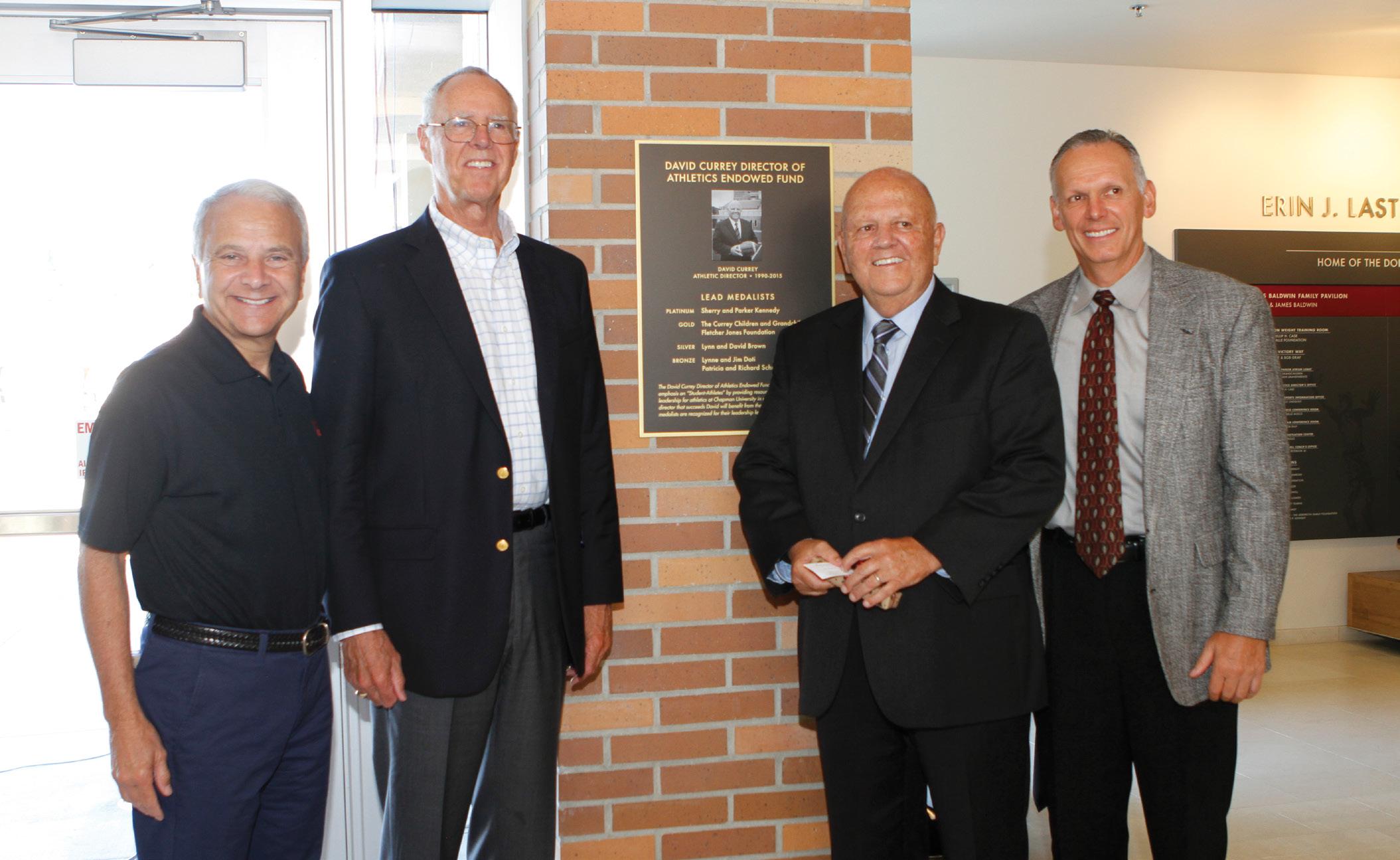 In honor of Currey’s retirement, the athletic directorship was endowed as the David Currey Endowed Directorship of Athletics.
In honor of Currey’s retirement, the athletic directorship was endowed as the David Currey Endowed Directorship of Athletics.
Being a part of the Chapman Alumni community brings many benefits, but one of the most valuable is the powerful connection between Panthers of every generation. No matter when you graduated, no matter where your path in life might lead, you can always depend on the support of the Chapman alumni community.
The Office of Alumni Engagement knows how cherished these alumni relationships are and is committed to helping build a strong network that offers resources, experiences and volunteer opportunities that will help you stay connected not just to Chapman, but to each other.
“With an invigorated staff and new strategic vision for alumni engagement, we are focused on creating deeper, more meaningful, lifelong relationships with our alumni,” said Nidhi Vogt, associate vice president of engagement and volunteerism.
With a renewed focus on building and strengthening community (near and far), the alumni engagement team is taking a multi-faceted approach, providing opportunities to connect and engage. From regional networks and in-person events around the country to a brand-new career networking platform, there are more ways to connect with Panthers than ever before.
The office continues to expand ways alumni can get involved, such as mentoring, mock interviews, speaking on panels and much more. “We recognize that alumni want to contribute their time and talent in different ways,” said Vogt. “We want to get to know you, hear your stories, backgrounds, career paths and understand how you want to volunteer your time.”
Email alumni@chapman.edu or call (714) 997-6681 to get in touch!
The Chapman Family’s signature networking series for alumni and families of current students kicked off in New York City in May at Cornelius Restaurant in the iconic Grand Central Station. The event saw an impressive turnout, with nearly 100 attendees, including alumni and parents in the tri-state area, and students and faculty participating in the Walk on Wall Street course. It marked a significant milestone as the first Chapman University event in New York following the COVID-19 pandemic.
The evening started with remarks from Vogt and Henrik Cronqvist, dean of Argyros College of Business and Economics. Their presence underscored the university’s commitment to fostering connections and engaging with its extensive alumni network.
“I’m proud to be a Chapman graduate because I’m seeing the investment the university is making through alumni networking; the work that Chapman is pouring back into the school, like diversity and inclusion, is also really cool,” said Ivy Chiou ’14, who was delighted to discover the vibrant Chapman community in the tri-state area.
In August, Chapman Family members in the Pacific Northwest gathered for an evening of connection and camaraderie at a cocktail reception in the Seattle home of David and Danielle Limp, proud parents of Dylan ’26 and Duncan ’26. Chapman President Daniele C. Struppa shared the latest updates about the university’s inspiring momentum, including a rise in national rankings, a new strategic plan and the university’s future.
President Struppa was also in attendance in November, when Chapman on the Road visited the Bay Area. “I really value the opportunity to connect with the Chapman Family at these events,” he said. “Building a community that reaches beyond our campuses is important work, and it’s exciting to see our alumni and families coming together to support one another and learn from one another.”
Want to find out when Chapman on the Road will visit your area? Scan here to find out or visit chapman.edu/alumni

Chapman Family members can stay connected thanks to a growing number of in-person and virtual opportunities.
What if there was a place where you could get to know other Chapman alumni and students who are looking to build their professional network? A place where you could find a mentor — or be a mentor! — and really connect with other Panthers who share your background, goals and ambitions? And what if all this was something you could find easily, whenever you needed it?
Have you ever wished you could create a bit of the Chapman experience for yourself? Even if you’re not a current student, our regional networks are here to make that possible.
If that sounds like a place you’ve been looking for, then it’s time to check out The Panther Network, the new online networking community just for Chapman alumni and students. The offices of Alumni Engagement and Career and Professional Development have collaborated to create a secure, supportive environment that will help you get more out of your professional life.
Chapman’s regional networks are designed to build and foster community, offering support and opportunities to engage with other members of the Chapman Family. Members of a network receive special communications throughout the year that include invitations to both in-person and hybrid events as well as virtual volunteer opportunities and resources to promote lifelong learning.
Jessi Rickmers ’08 is a volunteer with the Seattle area network and is helping to organize quarterly events in Washington. She hopes creating a strong Chapman presence in the state will improve networking opportunities and help bolster the reputation of the university.
Rickmers encourages other Panthers to get involved with regional networks in their own area. “I think we should be really proud of going to Chapman,” she said, “It was so small before, but now it's getting better and better known each year.”
Find out how to connect with the regional network in your area by visiting chapman.edu/alumni
The Panther Network is not just another social media platform. It’s an exclusive community where you’ll find many free resources designed to help you get ahead in your career, including:
Alumni Directory: Reconnect with old classmates and find new connections with direct messaging and voice-call capabilities.
Mentoring Program: Take a step further and offer to be a mentor or be mentored, as you develop a deeper relationship with a fellow Panther.
Groups: Connect with others with whom you share a common interest, industry or general location. Exchange ideas, plan events and communicate through dedicated discussion boards.
Career Pathways: Learn more about career possibilities, what options are available to you and how to best prepare.
Resources: Access articles and videos to refine your skills and knowledge of the workplace, professional development and more.
The Panther Network is free to join and use. Scan here to find out how easy it is to get started or visit thepanthernetwork.chapman.edu.
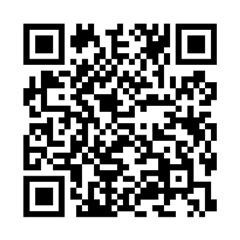

Vanessa Mendoza ’19 (MMS ’22) has a World War II-era Snoopy figurine on her desk, given to her by a man she met as a hospice volunteer.
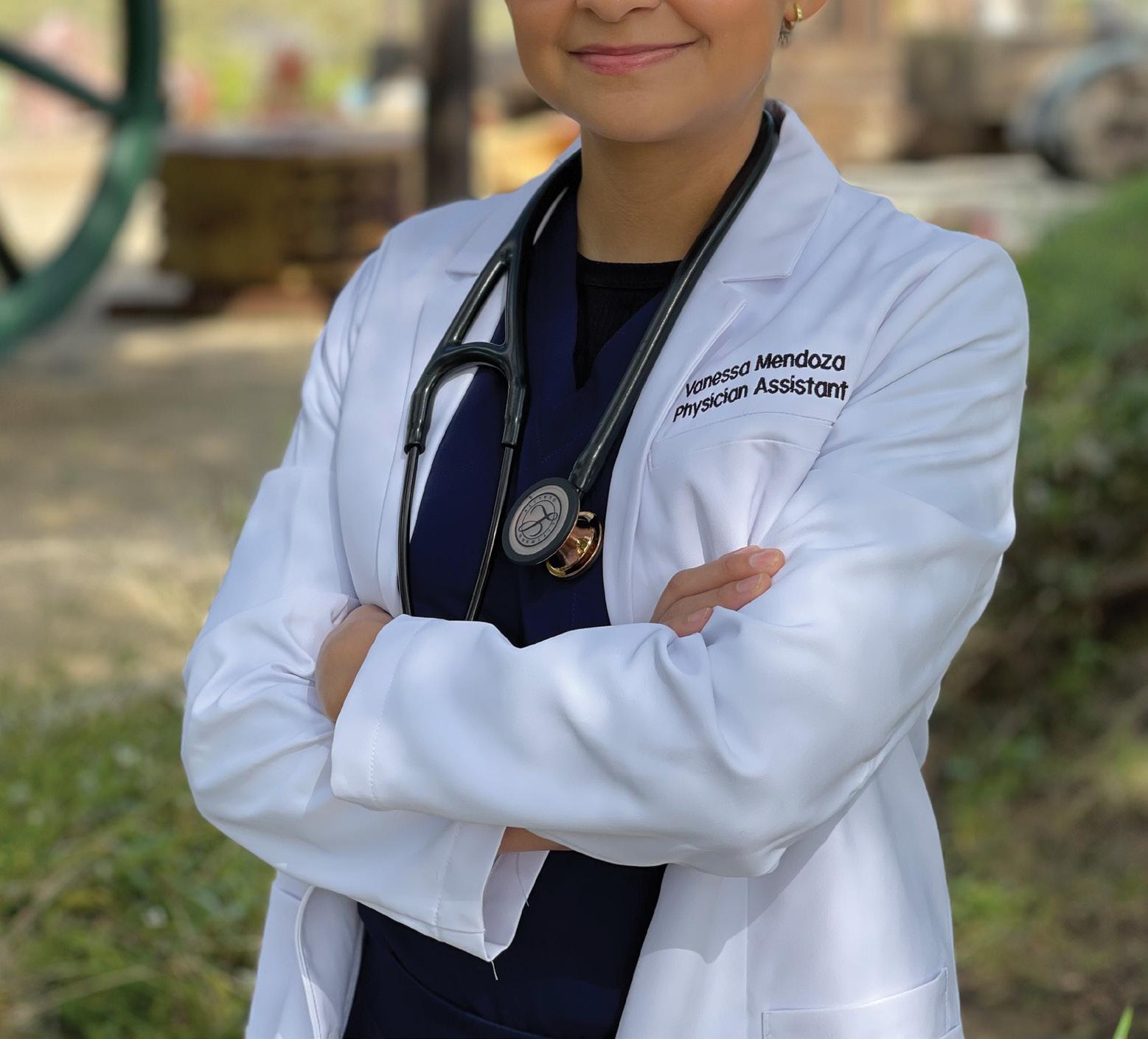
“Each time I visited him, he wanted to learn about me and others. He cared about the caregivers and the med techs in the community,” says Mendoza, who volunteered at the hospice company while studying for her biological sciences degree at Chapman University.
He was always brainstorming ways to make a difference in others’ lives, even as he reached the end of his.
“One of his last wishes was to go to Children’s Health of Orange County children’s hospital dressed in a Snoopy outfit to make the children happy,” Mendoza says.
She thought her visits were helping him, then realized he was the one helping her.
“He was wise and provided mentorship, guidance and bits of knowledge that he gained over his years,” she says. “Most importantly, he taught me to be kind, selfless, to always put others first and encouraged me to spend my life doing something I find passion and purpose in.”
The figurine given to her by the man, who died in his mid-90s, is “a reminder of the person I strive to be.”
“He made a positive impact on me and I want to make a positive impact on others,” Mendoza says.
Mendoza finds passion and purpose as a physician assistant for a mobile primary care company serving older adults. She goes where her patients are — home, assisted living and board-andcare facilities.
“I get to see my patients weekly. Over time I not only learn more about their medical conditions and health, but I also have the privilege of developing a trusting relationship with them. I am able to learn their likes, dislikes, about their family life and who they are as a person,” says Mendoza, who received a full-tuition scholarship through Chapman’s Simon Scholars PA program, which the Simon Family Foundation supports.
Mendoza’s studies at Chapman, work and volunteer experiences gave her a foundation.
She wanted to work in the medical field since she was 5 years old. In high school, she created a club that raised awareness of, and funds to treat, various medical conditions.
She thought she wanted to work with kids, as most of her volunteer experience was with children. Before entering the PA program, she began volunteering with a hospice company supporting older adults.
“I’d visit weekly to read to them, sing with them, listen to music with them, listen to their life stories, hold their hand and provide companionship” she says. “Through that experience, I learned that I love and appreciate the geriatric population. It’s an honor to be part of someone’s life at the end stage.”


“It’s an honor to be part of someone’s life at the end stage.”
— Vanessa Mendoza ’19 (MMS ‘22)
Before applying to Chapman’s PA program, she worked as a medical scribe for her current company and as an EMT. Once she became a Simon Scholar PA student, she learned time management, perseverance and the value of being a continuous learner.
“The rigorous criteria of the PA program has helped me in practice because I now have a very solid foundation in medicine,” she says.
As a Simon Scholar PA student, she received mentoring, tutoring support, access to guest speakers, financial advice and listening ears from program staff. The scholarship program gives students earning their master’s in medical science through the Chapman PA program the chance to graduate in two years with little or no debt.
“Having the financial support during PA school allowed me to devote all of my time, energy and attention to PA school. It gave me the opportunity to dedicate myself fully to achieving my goal and dream,” Mendoza says.
Now she’s able to give back to the community without the pressure of high student debt.
“I strive to give high-quality health care to patients,” she says.
On a typical day, the Orange County native sees patients in person and via telemedicine, makes diagnoses, interprets tests and develops patient care plans. She manages a variety of acute and chronic medical conditions. She also educates patients, staff and the community on topics like healthy habits through staff trainings, “doc talks” and more.
“I’m grateful that Chapman University and the Simon Family Foundation have invested time and resources in me,” she says. “They have provided guidance, knowledgeable professors, resources and support that has allowed me the opportunity to make a positive impact as a physician assistant.”
A Snoopy figurine given to her by a man she met in a hospice facility sits on Mendoza’s desk.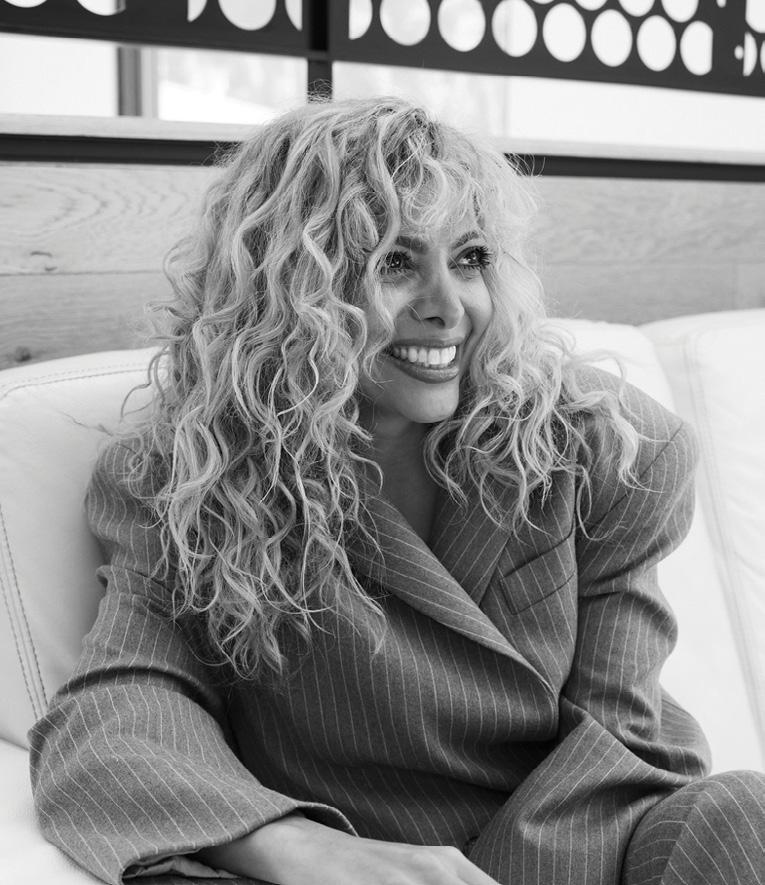
What do an animated music special, a fake jury trial, a road-rage feud and a beloved sports comedy-drama all have in common? The answer: Chapman University alumni.
This year, four talented women with degrees from Chapman’s Dodge College of Film and Media Arts were nominated for Emmy Awards. They’ve worked on some of television’s biggest shows and their contributions took the spotlight when the Emmys took place in January.
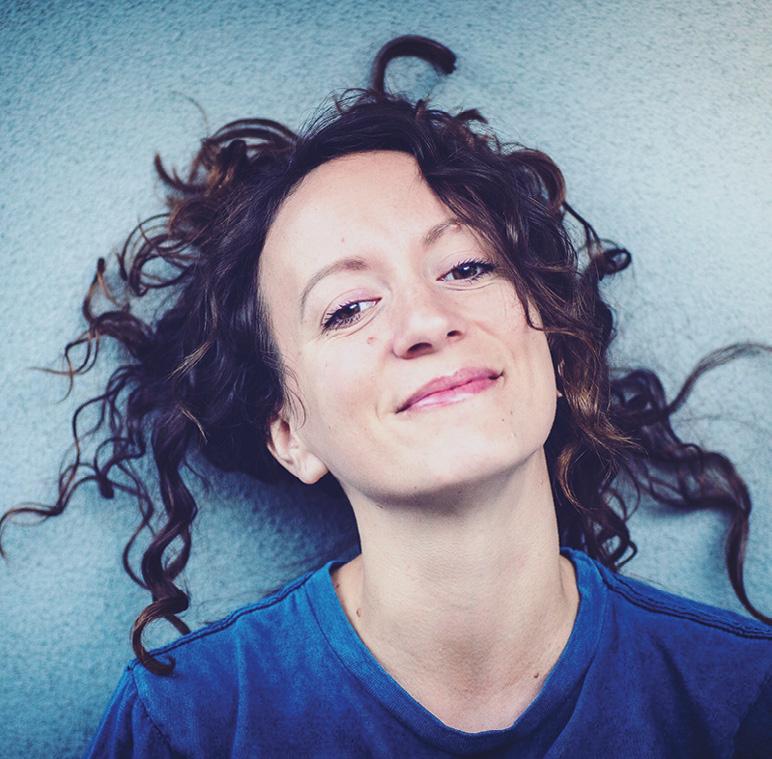
Laura Zempel ’09, who’s work on the Netflix show “Beef” earned her the award for Outstanding Picture Editing for a Limited or Anthology Series or Movie, said the show was unlike any show she’s worked on previously, thanks to the offbeat humor in the story of two strangers whose involvement in a road rage incident escalates into a prolonged feud.
“We got to play with humor and surrealism to tell a story about these really complicated characters,” she said. “I love when humor is incorporated into drama, and I think the humor in ‘Beef’ is so unique in illustrating the darkness and pain that live within Amy and Danny.”
Zempel said working with showrunner Lee Sung Him was a very collaborative and rewarding experience.
“For me, this nomination is significant because it means we were able to take what was in his head and make it really resonate with an audience,” she said.
Zempel previously won an Emmy for her work on the show “Euphoria.”
“The nomination feels like a raucous validation of a project that hits so deep for us,” said Karina Manashil, producer of the Netflix animated special “Entergalactic,” which was nominated for Outstanding Animated Program.
The program is based on the album of the same name by American musician Kid Cudi, and has already earned honors from the Critics Choice Assn. and the NAACP Image Awards.

“So many parties took a chance on us,” Manashil said. “An album-driven adult animated black love story was not a genre we were seeing.”
“There are days I still can’t believe we’re nominated,” said Katrina Mathewson ’11, who was nominated as a producer on the Amazon Freevee show “Jury Duty.” The show, a reality hoax sitcom television series about a fake jury trial, is Mathewson’s first producing credit with writing partner Tanner Bean.
Mathewson was thrilled to be competing with brilliant and groundbreaking comedies like “Barry” and “The Bear.”
“We’re talking about some of my favorite shows from the past decade,” she said. “So I finally understand what people mean when they say: ‘It’s an honor just to be nominated.’”
Melissa McCoy ’07 was also nominated for her editing on the comedy series “Ted Lasso” from AppleTV+.
Karina Manashil Katrina Matthewson Nat Fuller and Laura Zempel
Dodge College alumnus reconnects with his inner theater kid, earns Tony Award nomination
As a teenager growing up in San Diego, Hunter Johnson ’07 spent much of his time at the La Jolla Playhouse. The venue was a perfect creative outlet for a theater kid as it was often the first stop for shows before they went to Broadway.
Classics like “Fiddler on the Roof” made an indelible impression on him, and he connected with the open-minded demeanor of the theater community. As a gay teenager, Johnson felt out of place in the conservative neighborhood where he grew up. The theater provided respite from judgment.
“I felt like I was being pulled in a bunch of different places, and the theater made me feel at home,” Johnson says. “The people in the theater helped me feel safe.”
But with competing interests in film and television, Johnson chose to focus elsewhere when he selected his area of study at Chapman’s Dodge College of Film and Media Arts and eventually started Xpedition, an award-winning entertainment studio that produces television shows, documentaries and branded content. Chapman alumnus and adjunct faculty member Derek Helwig ’05 is senior vice president of unscripted development at the company.
Theater took a backseat for Johnson, until an opportunity arose about a year ago that excited his inner theater kid. He was offered a producer role on the renowned play, “New York, New York.”
“It was a crazy first show, it was like being a kid in a candy store,” Johnson says of the show, for which he was nominated for a Tony Award. “I’m literally in shock to be honest. It’s been so fast and that is really show business.”
Johnson quickly learned that the skills he mastered at Chapman were incredibly useful when adapting to a new industry. Over the last year, Johnson has been involved in “Back to the Future,” “Grey House” and “Harmony,” which includes Chapman alumna Kyla Stone ’20 as a cast member.
Johnson has been a producer on each show except “Back to the Future,” in which he was an investor. It’s been a surreal experience for Johnson, who has been in a producing group with Broadway legends like Stephen Sondheim, Susan Stroman and Lin-Manuel Miranda. Johnson has three more shows slated for 2024, including the musical, “My Son’s a Queer (But What Can You Do?).”
“Chapman instilled in me this scrappy, can-do notion of picking yourself up by your bootstraps and getting things done,” Johnson says. “There’s also this sense of being on a team. This team environment is something that makes Chapman incredibly special. It’s how I learned to be a leader and a great team member. It gave us an edge that has allowed us to propel way beyond what people thought we could do quickly.”
With his current production, “Harmony,” Johnson helped bring to stage a work that he’s loved since he was a child. The musical depicts a group of Jewish singers who were persecuted during the rise of fascism in Germany. While struggling to find a sense of belonging as a teenager, the show’s message about camaraderie resonated with Johnson.
“My dad’s Jewish and my mom’s Christian, so I’ve always been split between worlds,” Johnson says. “The message of togetherness and harmony and finding commonality with one another is so important with so much hate going around the world.”
Being a part of “Harmony” epitomizes Johnson’s reconnection with the art form he’s loved ever since he was a wide-eyed theater kid.
“To be a part of the producing team to bring ‘Harmony’ to Broadway is a full-circle moment for me,” Johnson says. “This has been a theater kid’s dream come true.”
William Steiskal ’86 published a book, “Love Politics Prayers,” combining photographs with poetry. His poem “911 War Psalm” was made into a short film released on YouTube.
Gincy Heins (MBA ‘87) published a book, “Advocacy Press Before the Diagnosis: More Stories of Life and Love Before Dementia.” All proceeds are donated to Alzheimer’s Orange County. 1
Wayne Bethanis ‘88 made an album, “Listen,” that reached No. 1 on One World Music Radio’s album chart in February 2023. 2
Diane Makar Murphy (MA ’91) published a novel, “Down, Down, Down,” inspired by her experiences in the U.S. Army. 3
Thomas Bailey (MS ’93) created an endowment fund at the University of Maryland Global that has been renamed for him. The fund has provided scholarships to 10 psychology students so far.
Echo Baker ’93 participated in the California Art Club’s annual Gold Medal Exhibit at Bowers Museum and the Festival of Arts in Laguna Beach. 4
Gabe Serrato Buelna ’97 was vice chair of Oceana’s 16th SeaChange Summer Party in Dana Point, which raised more than $1.5 million for ocean conservation. He is pictured with the band Third Eye Blind, which performed at the event. 5
Maylynn Jakubowski (Morales) ’01 met John Wood ’77 on an Arctic expedition through Norway, Greenland and Iceland. Wood is an educator and Jakubowski is a controller for a real estate firm. Jakubowski served on the Alumni
Board of Directors and carries a Chapman pennant when she travels in case she meets other Chapman alumni. 6
Jaz Berger ’03 was named vice president of development in the Factual Department of Morgan Freeman’s Revelations Entertainment production company.
Hunter Johnson ’07 was nominated for a 2023 Tony Award for producing the Broadway musical “New York, New York.” He is also a producer of the new Broadway play “Grey House.”
Andrew Krop (Scheppmann) ’07 (MFA 09) was named associate game writer at Gravity Well Games. 7
Danielle Beckmann ’08 and Ashley Gianni ’08 wrote a film script that was ranked in the top 5% of 120,000 scripts on entertainment writing website Coverfly in November 2023. The script is about a drag queen in the 1990s. 8
Johnny Maravelis ’08 was on LA Weekly’s “Top 10 Los Angeles Entrepreneurs to Know About Going in 2023.” He credits his “great classes at Dodge.”
Jon Cohn ’10 published “Slashtag”, a book about a horror reality competition series. 9
Rachel Lohman (Berry) ’10 published a book, “Miscarried Hope,” about finding hope and healing after miscarriage. 10
Tiffany Neptune ’10 started her writing career with her first article published in the Source Weekly in Bend, Oregon.
Alex Mohajer (JD ’11) announced his campaign to represent District 37 in the California State Senate. The primary is scheduled in March 2024. 11
Emmeline Kim ’12 was featured in a June 4, 2023, Los Angeles Times article, “Slide into a Los Angeles Pole Dance Class.” She is CEO and president of dance and photography studio Sabbath Circle.
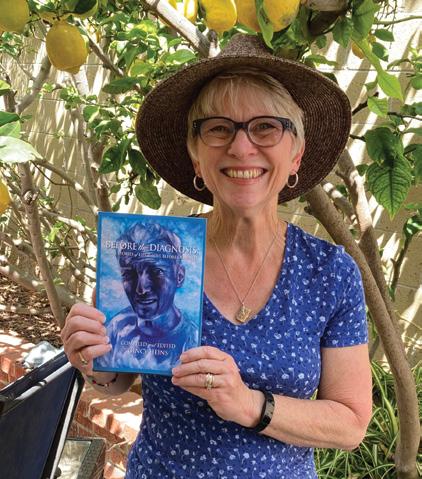


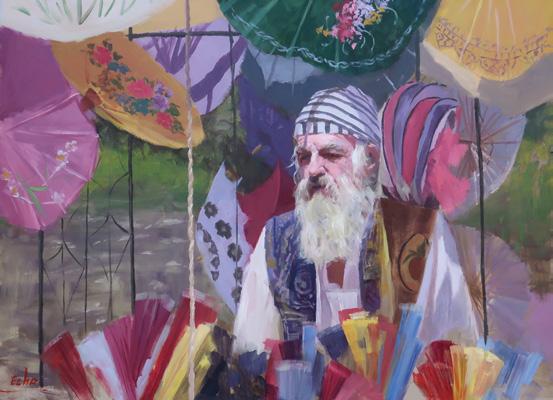
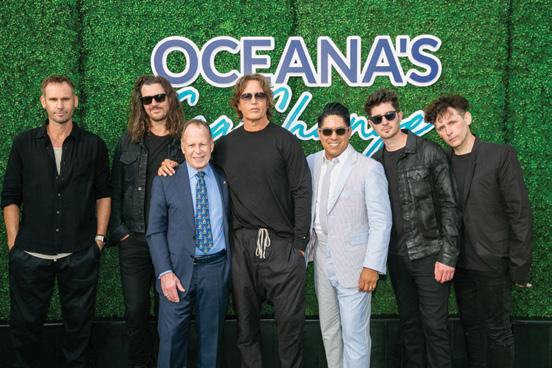
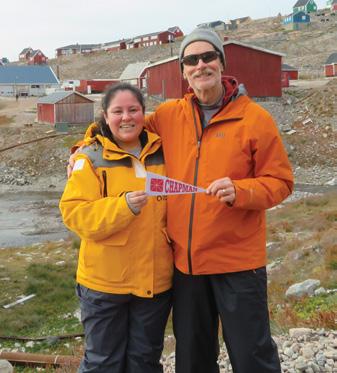
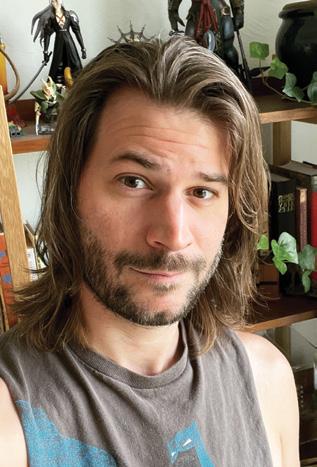


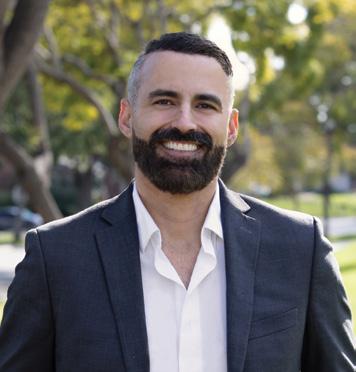


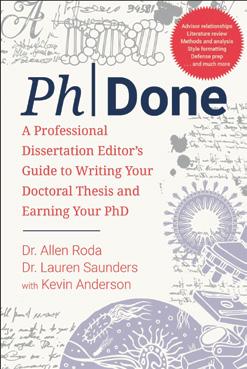
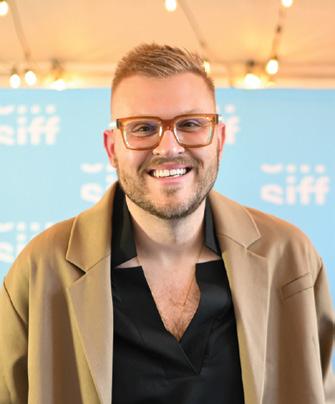



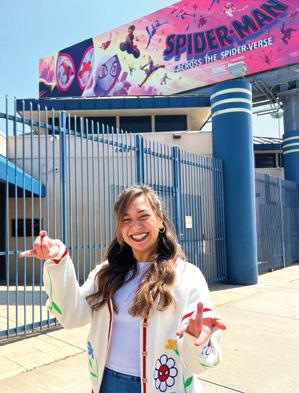
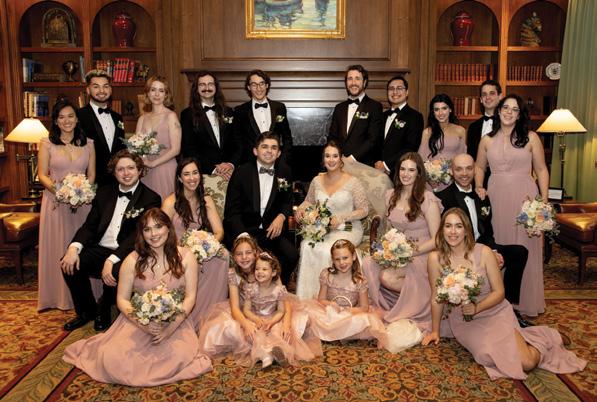





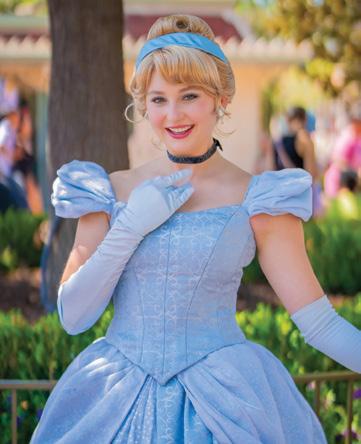
Megan Demshki ’12 (JD ’15) made the 2023 Top Women Lawyers list in the Los Angeles Daily Journal in June 2023. She is managing partner of Aitken Aitken Cohn’s Riverside office and specializes in plaintiff-side personal injury, medical malpractice and wrongful death cases. 12
Lauren Saunders (Benke) ’12 published a book, “PhDone: A Professional Dissertation Editor’s Guide to Completing Your Doctoral Thesis and Earning Your Degree.” 13
Andy Vallentine (MFA ’12) directed and produced “The Mattachine Family,” which was screened at film festivals around the U.S. and abroad. Chapman alumni Sid Ganji, Cameron Hutchison and Chelsea Fenton were co-producers. 14
Peyton Collins ’13 and Jeff Topolski ’13 married June 11, 2023 in Denver. They met at Chapman in 2011 through Greek life and Dodge College. The wedding party included Alissa Caton ’11, Allegra Batista ’13, Mia Wardell ’13, Shannon Parker ’16, Ryan Wardell ’14, Nate Grady-Reitan ’14, Matt Brown ’12 and Garrett Addison ’13. The couple honeymooned in Italy. 15
Steven Kanter ’13 won the American Regional Cinema Competition at Film Fest Knox in Knoxville, Tennessee, with his film “Peak Season.” 16
Maryann Krikorian (Ph.D. ’16) published a book, “Higher Education for the People: Critical Contemplative Methods of Liberatory Practice.” She also received Loyola Marymount University’s Term Faculty Distinguished Teaching Award.
Allie Altman ’17 (MA ’18) and Tim Altman ’17 welcomed their first child, Everly James Altman, on July 3, 2023. They met on move-in day when Tim knocked on Allie’s door in Pralle-Sodaro Hall to introduce himself. 17
Melanie Duke ’17 was named development coordinator at Sony Pictures Animation. She was a script and story coordinator and voice talent for “Spider-Man: Across the Spider-Verse.” 18
Sabrina Santoro ’19 and Casey Donovan ’19 married March 11, 2023, in Newport Beach. They met living in Glass Hall their first year. Their wedding was officiated by Rev. Gail Stearns, former dean of Wallace All Faiths Chapel, and attended by President Daniele C. Struppa. Their wedding party included Leah Roach ’19, Emerson Harris ’18, Alan Macchiarolo ’17, Matt Garcia ’17, Lorig Yaghsezian ’20, Steven Santoro ’20, Ariana Santoro Alexovich (JD ’14), Alexandra Santoro ’12, Mandy Jacobs ’19 and Murphy Studebaker ’19. 19
Mallory Sullivan ’19 was promoted to producer for “Good Day LA” and got engaged. 20
Arielle Ross ’20 started a cosmetics company, Relevation Beauty, that donates 10% of every purchase to education of young women in Bangladesh. 21
Brooke Archer ’21 is publishing “Hearts Still Beating,” a young adult post-apocalyptic romance, in spring 2024.
Brendan Bubion (MFA ’22) received first place in the LA Press Club’s SoCal Journalism Awards’ entertainment category for producing an episode about the Gay Men’s Chorus of L.A. as part of KCET’s “Weekly Arts” series. 22
Leyna Kataoka ’22, a Ph.D. candidate in learning and mind sciences at the UC Davis School of Education, was awarded the Eugene V. Cota Robles Fellowship. She hopes to use her research to make settings more inclusive for neurodivergent people. 23
Emelia Arnheim ’23 was named platform marketing coordinator for A+E Networks.
Lindsey Ryan ’23 started work as a princess at Disneyland. 25
Olivia Johnson ’23 (right) became a full-time medical assistant at Newport Heart Medical Group. 24BARBARA EMMITT (KENT) ’49 passed away March 1, 2023. She taught piano for 40 years in Camarillo and was also a singer. She was known for her “wit and wisdom.” She is survived by a daughter, son, daughter-in-law and grandson.

THOMAS RAMPTON ’67 passed away Aug. 7, 2023. He studied chemistry at Chapman and taught the subject in Buena Vista, Colorado, where he spent the rest of his life.
His interests included chemistry, geology, photography and aviation. He loved whitewater rafting and self-published several river guides. He wrote “Vietnam in the Absence of War,” which he illustrated with his own photography. He is survived by his daughter, stepdaughter and sister.

GORDON LOCKETT ’75 passed away Dec. 16, 2022. He majored in business administration at Chapman and managed restaurants in Mexico before moving to Richmond, Va., where his family had roots. He worked in restaurant management, real estate and the insulation industry. He loved golf, fishing, watching football, gardening and cooking. He shared what he grew and loved cooking for family and friends.
“He was the epitome of a host. He had a multitude of dishes that he could whip up with little effort, he was so passionate about it,” says his sister, Laura Lockett ’73. Lockett is also survived by his three children and three grandsons.
After 16 years at Chapman, Senior Editor of Chapman and Chapman Forward magazines Dennis Arp has laid down his pen. As the editor and lead writer for Chapman publications, Arp left his mark on readers through his insightful reporting and poignant storytelling that brought to life the breadth and depth of the Chapman experience.
Under his leadership, Chapman magazines earned numerous awards from the Council for the Advancement and Support of Education (CASE) and other industry organizations. In 2022, Arp was awarded the Silver Quill Award from the International Association of Business Communicators for his article “After Fleeing Afghanistan, Law School Alumni Find Refuge at Chapman.” (Scan the QR code at right to watch a video in which Arp reflects on the creation of the piece).
Among his favorite memories while working for Chapman Magazine was a trip to eastern Montana to meet and report on legendary paleontologist and Chapman Professor Jack Horner. “It was definitely a highlight to be there when he confirmed that the fossil the team had discovered in the Hell Creek Formation was indeed the complete skull of a T.rex.,” he says.
“Thanks to Chapman innovators, there’s never a shortage of great people to meet and stories to tell on this campus. That’s why I can’t wait to open future issues of Chapman Magazine to see what’s inside.”

Scan the QR code or visit chapman.edu/dennisarp to watch “Changed by Story,” a short film by Dennis Arp.
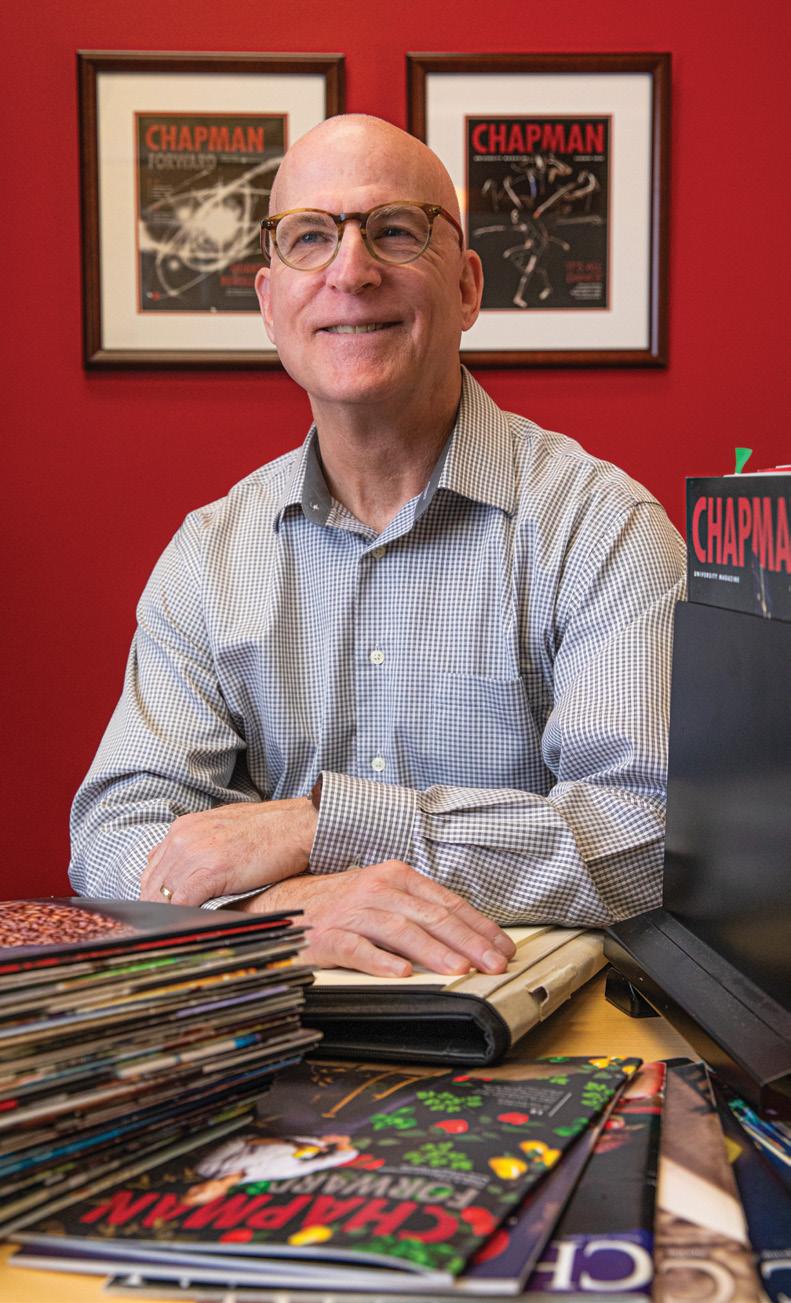
The Panther Network is your opportunity to refine your professional skills, grow your network and give back to the next generation of Chapman Panthers.
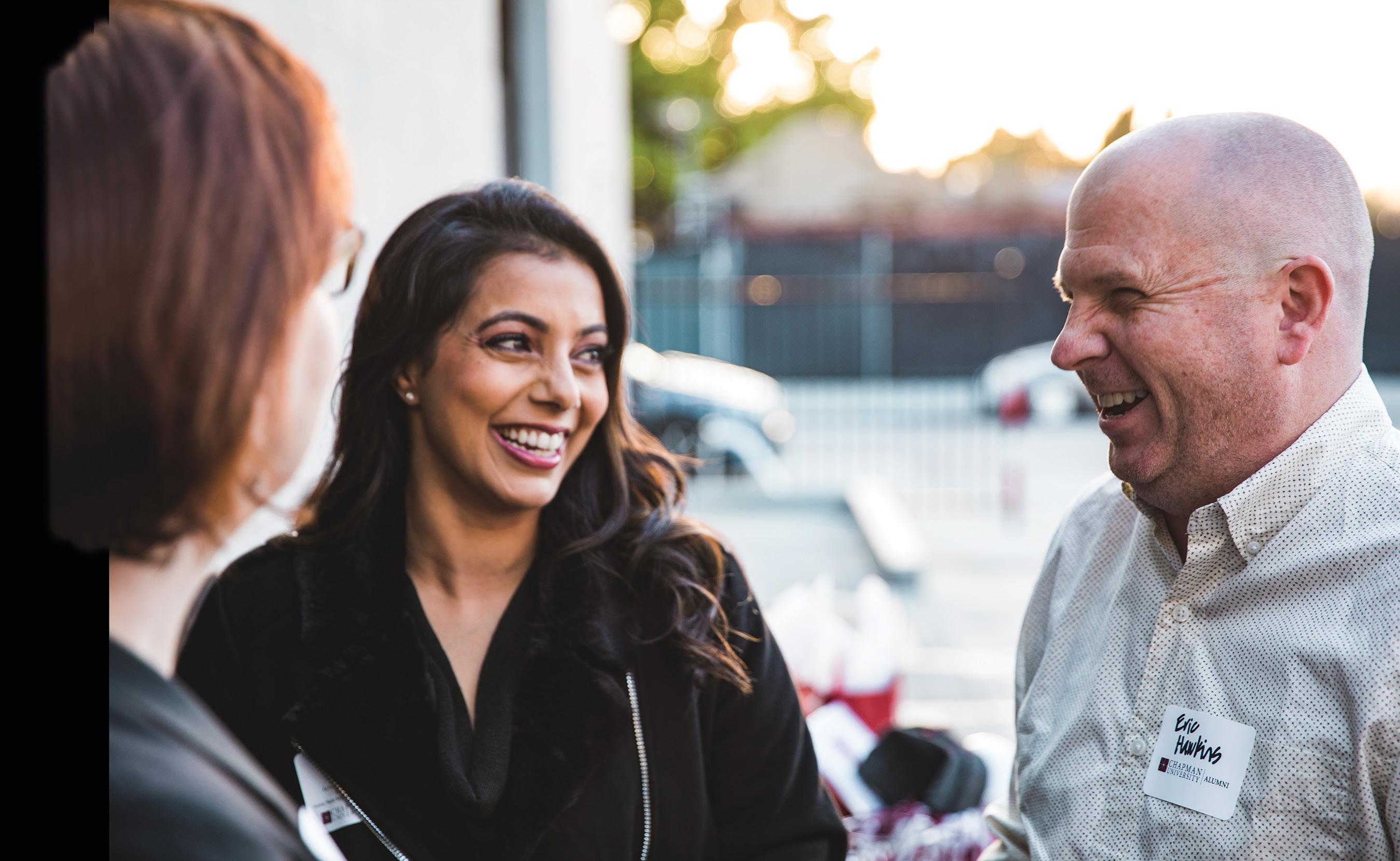
GROUPS
MENTORING
BUSINESS DIRECTORY

ALUMNI DIRECTORY RESOURCES
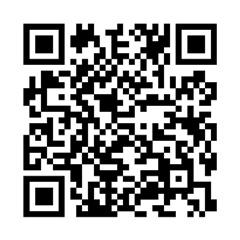
JOB OPPORTUNITIES
Read more about this exclusive online community for Chapman students and alumni on page 57 of this magazine.


